

www.GolfKitchen.com March 2020-August 2020
Shaun C. Lewis Liberty National
Golf Kitchen Magazine is a biannual publication of Golf Kitchen LLC. Copyright 2020. Print subscriptions are available at www.golfkitchen.com for $59.99 per year.
All rights reserved in all countries. Contents may not be reproduced in any manner without written permission of Golf Kitchen LLC. Golf Kitchen LLC does not necessarily agree with the viewpoints expressed by our contributing writers of articles and advertising copy.
For advertising opportunities please email us at info@golfkitchen.com
Golf Kitchen welcomes letters to the editor at info@golfkitchen.com
GOLF KITCHEN
Magazine
CONTENTS SPRING | SUMMER, 2020
14 CHRISTOPHER PARK EXECUTIVE CHEF WYCLIFFE GOLF & COUNTRY CLUB
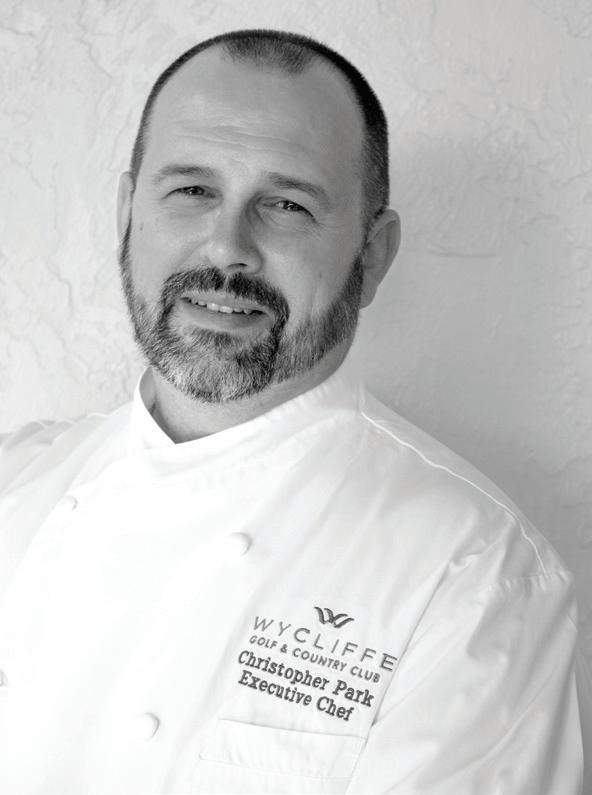
38
FORK FARMS A FRESH TAKE ON DINING BY ALEX TYINK
42
UNDERGROUND DINNER: A TASTING DINNER AT ADDISON RESERVE
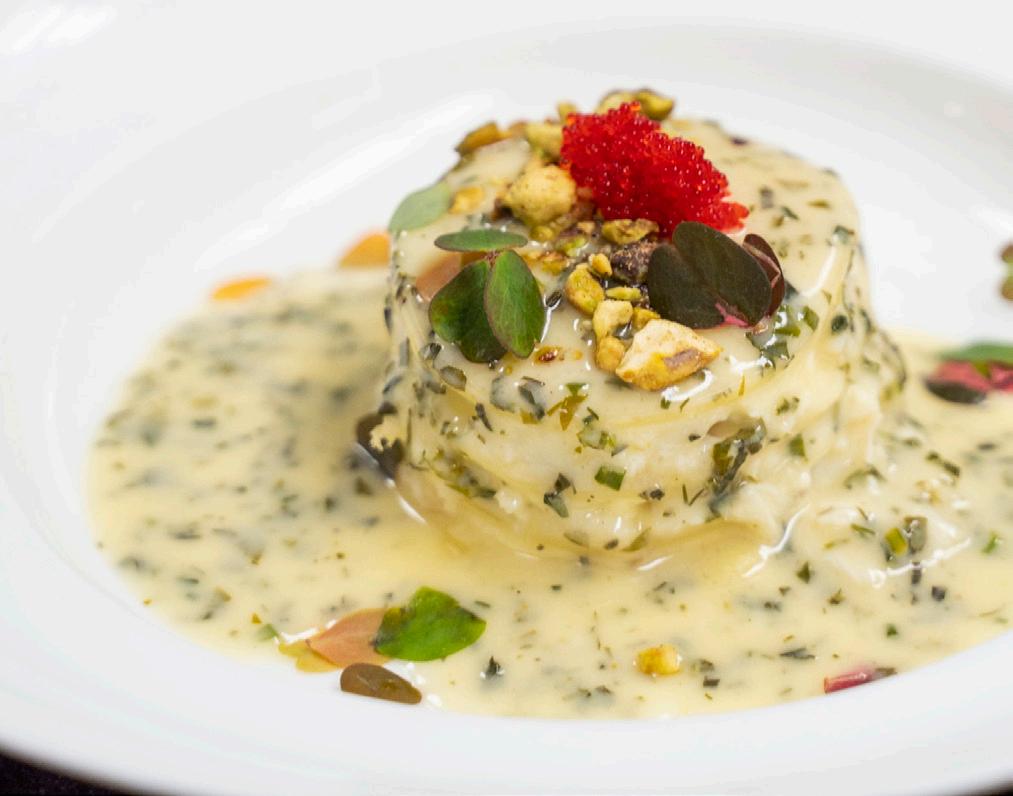
52 FERNANDO SILVA A SOMMELIER AND ARTIST AT GLENARBOR GOLF CLUB



414 42
60
COVER STORY: SHAUN C. LEWIS, EXECUTIVE CHEF AND ASSISTANT GENERAL MANAGER AT LIBERTY NATIONAL GOLF CLUB
52
60
Khayyan’s collection of wine vinegars are aged and categorized under Crianza, Reserva and Grand Reserva, and are produced from high quality Palomino, Tempranillo, Fino, Oloroso, Moscatel and Pedro Ximenez grapes aged in American Oak barrels in Jerez and Cordoba, Spain. These unique flavors have quickly become a staple ingredient in the kitchens of some of the country's top chefs.

94
112
140
HESS, A RISING STAR AT
152
A CHEF WHO GETS THE MESSAGE RIGHT BY PAUL
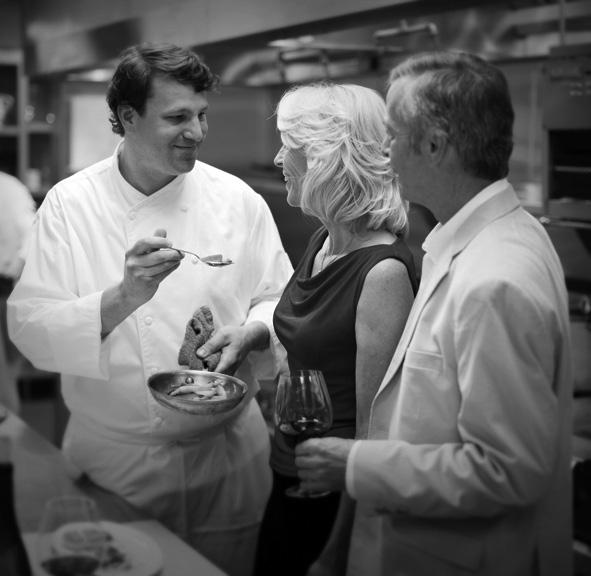

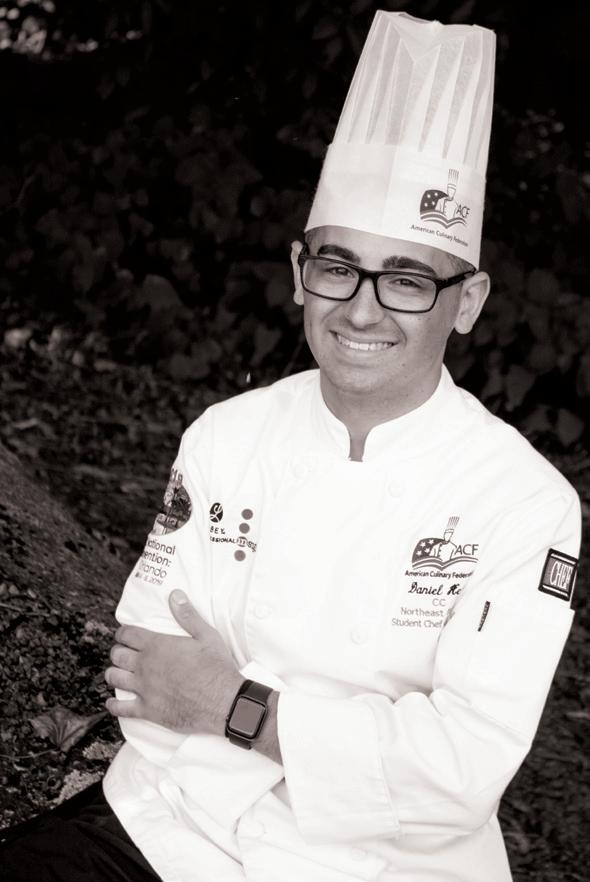
136
CLUBHOUSE COCKTAILS
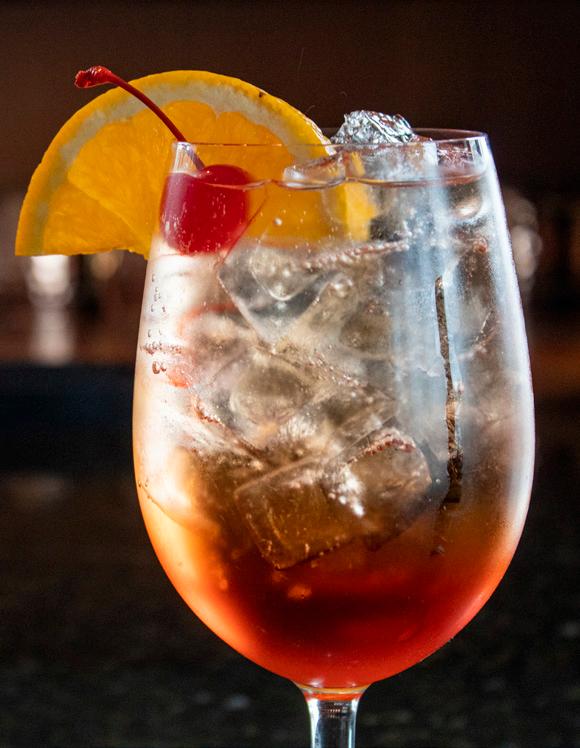
136 70 70
140 86
RAISING THE BAR BY NATALIA FEDRA CABRERA MERCADER
DAN
WESTCHESTER HILLS GOLF CLUB
CONTENTS
94
SORGULE
112
SCOTT PIKEY EXECUTIVE CHEF MAYACAMA GOLF CLUB
BLAKE BURGARD EXECUTIVE CHEF THE TUXEDO CLUB

FROM THE EDITOR
I entered the new decade, guns blazing with new ideas and initiatives to continue to illuminate and grow this beautiful culinary community in the Private Golf and Country Club industry. Whoa, did that make an abrupt about-face or maybe not? Maybe it has turned a corner for the greater good of our industry.
Some might say that it is a stretch, but from personal experience, and not too many people know, I faced significant losses in my life, particularly during the period when book one was released, and book two was published. On the surface, my life looked rosy, an accomplished photographer, a published author, and a successful small business. I kept up the bravest face one could do; however, in the background, between global trips to the most luxurious locations from the northern and southern hemispheres, evil lurked. I had become the victim of a horrendous ongoing crime that lasted for many years and affected every aspect of my life.
I knew I had to fight back if I were to survive, I had to find that inner strength that I had, that lust for life and travel that has propelled me forward since I was a child. For a period, I was caught between two states of mind, one was that I was NOT going to quit what I had started, and the other was one of extreme numbness, loss, pain, grief, and emptiness. I learned how to jump between the two mindsets somehow, only my immediate family and friends knew. I honestly don’t know where my strength came from, but ultimately it was LOVE that saved me. It was the love of others for me and my love for them and those that I had lost that kept me going.
It took four years for the overwhelming situation to be put to rest. That was four years ago now. Yes, it was challenging, BUT I kept going. I faltered, I fell, I lashed out, and I cried... boy, did I cry. Ultimately I SURVIVED, and I transitioned, and then I became the butterfly.
My point is that no matter how dire this current Covid 19 situation becomes unless it kills us, it presents us ALL with two mindsets that we have to experience.
1. To allow ourselves to fully grieve the loss of the past.
2. To find a healthy, sustainable path forward.
Let’s all become butterflies together. Let’s talk to each other, be there for one other, share ideas, and forge the way forward in our industry together.
Editor note: Special thanks for this issue goes out to Liberty National Golf Club, The Tuxedo Club, Mayacama Golf Club, Addison Reserve Country Club, Westchester Hills Golf Club, GlenArbor Golf Club, Wycliffe Golf and Country Club, Fork Farms, Khayyan Specialty Foods, Michael J. Fiedler, and Paul Sorgule. Everyone involved in this issue has contributed hours of work and dedication to bring it to the forefront.
Diana DeLucia

Golf Kitchen
email: diana@golfkitchen.com
Hello all!
Golf Kitchen Magazine 8
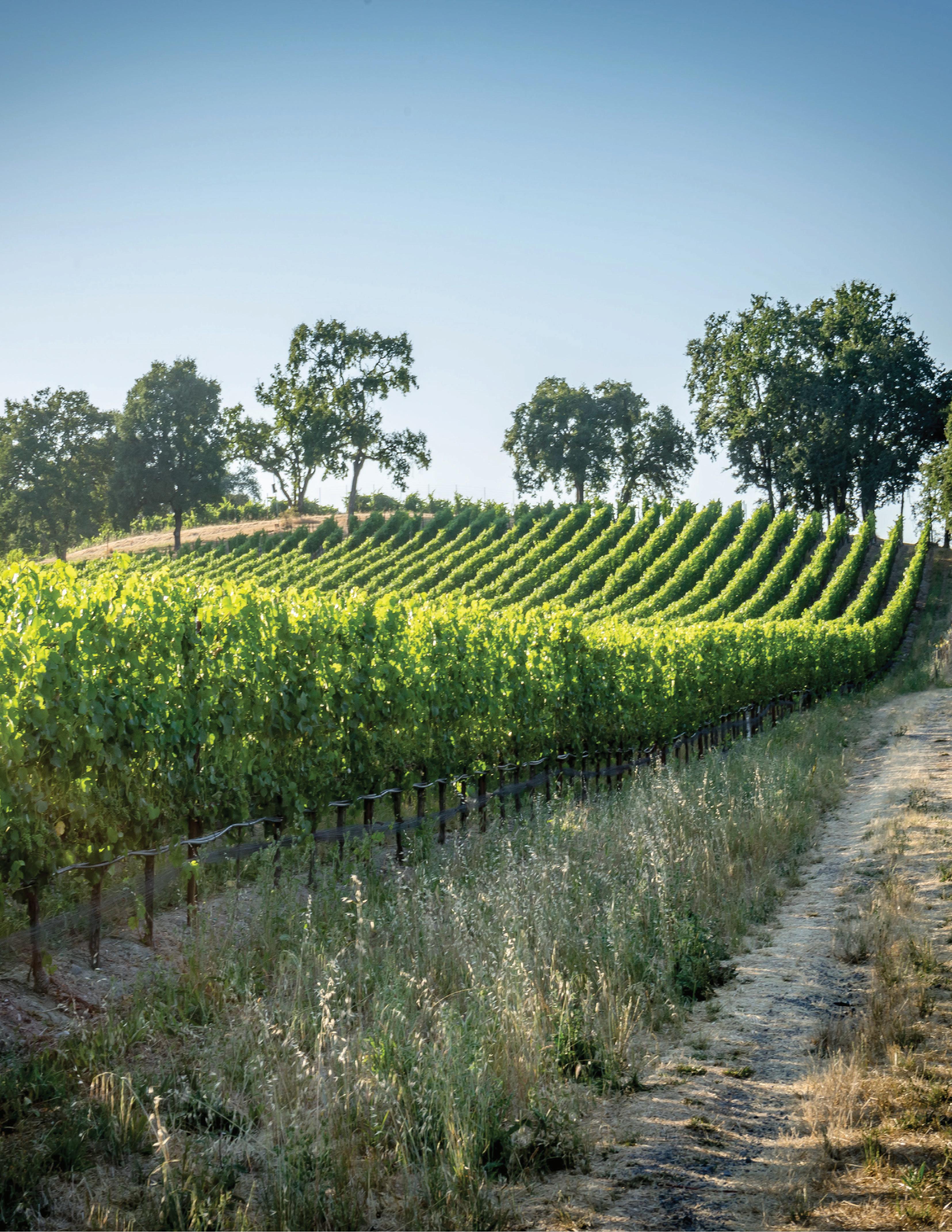





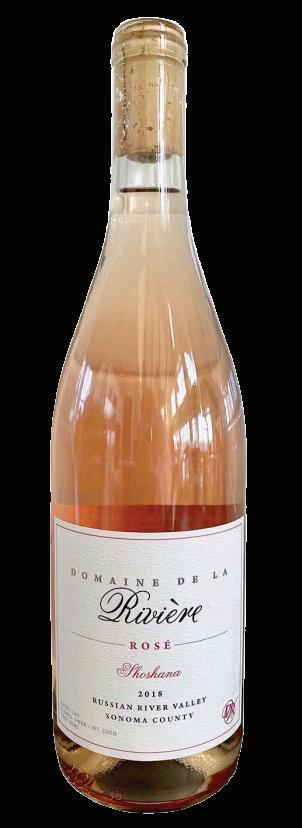


family’s goal is to craft unique, limited production, age-worthy wines from the Middle Reach of the Russian River Valley that create memorable experiences.” 6157 Starr Road, Windsor, CA - domaineriviere.com - (707) 888-1598
“Our
CONTRIBUTORS
Mercader is the Founder of Khayyan Specialty Foods. She is a producer of real food and ingredients grown by local farmers in Spain which are packed by the source. She is also an importer of Spanish Olive Oil and Specialty Vinegars. Her brands can be found at some of the finest restaurants and private golf and country clubs across the North East of America and abroad.
Natalia is a regular and valuable contributor to Golf Kitchen writing focusing on new and authentic produce.
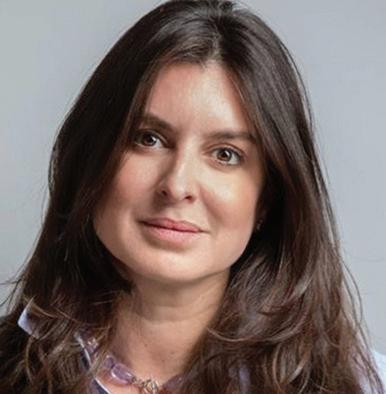
Khayyan’s brand of Olive OilSanta Maria was awarded Gold at the 2019 World Olive Oil Competition.
Contact:
Email: natalia@khayyan.com Web: www.khayyan.com
Alex Tyink is the co-founder of Fork Farms and the inventor of its farming technology and methods. He is a former opera singer with 10 years of leadership experience in the social service sector, who works to inspire vast food system change across communities. He began his urban agriculture career in Brooklyn, New York where he first worked on rooftop gardens and then started building indoor growing systems of his own for educational and food security purposes. This eventually led to the development of Fork Farms intellectual property, and the rest is history. Fork Farms was the winner of the 2019 Wisconsin Innovation Award for Product Design and Insight Publications Innovation Award in 2018.
After relocating back to Wisconsin, Alex continued his work as program director at Goodwill Industries of North Central Wisconsin and as director of innovation and programs for Feeding America Eastern Wisconsin. In 2018, he was a Fox Cities Future 15 winner and featured as Fox Cities Magazine’s ‘Big Idea’. Alex currently lives in Appleton, Wisconsin with his wife, son and their dog Maya.
Contact:
Email: info@forkfarms.com Web: www.forkfarms.com
Photographer Michael J. Fiedler discovered his talent and passion for photography more than 30 years ago aboard a Navy aircraft carrier. While traveling the world and experiencing the diversity of many cultures, he was naturally drawn to chronicling the experiences of people, especially in their vocational settings, telling their story through his images.
Fiedler has a distinct documentary style, often using available or low light, creating pictures with a more intimate, realistic feel. His photographs are visual representations of the message his client wants to convey. Whether photographing a CEO in a board room or a farmer in the field,he can capture their individuality and uniqueness of their lives.

Most recently Fiedler published his first book titled Working Journal, which has been featured in Forbes Magazine, Downtown Magazine, Fox News and more.

Contact:
Email: Michael@MichaelJFiedler.com
Web: www.working-journal. com
Natalia Fedra Cabrera
Golf Kitchen Magazine 10



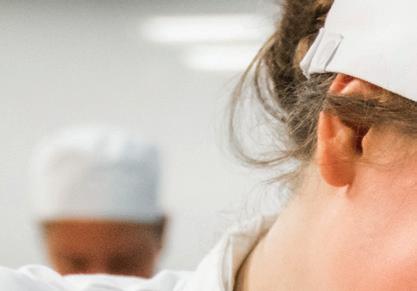




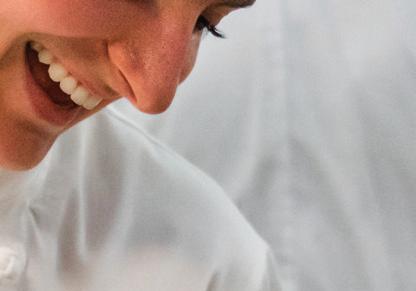
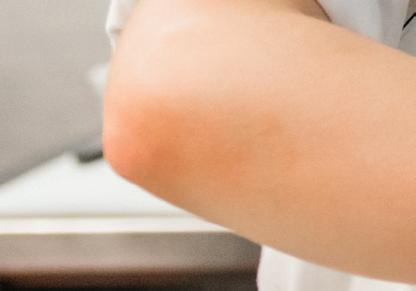
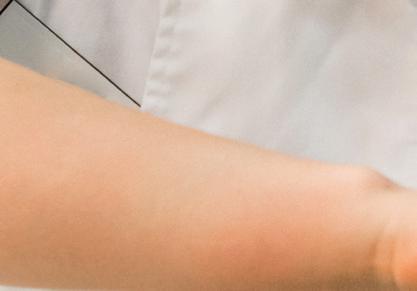



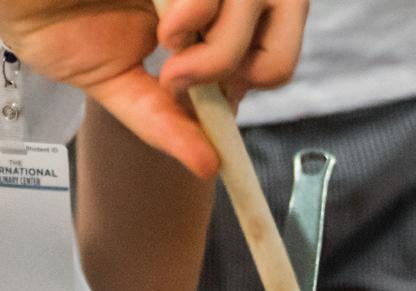

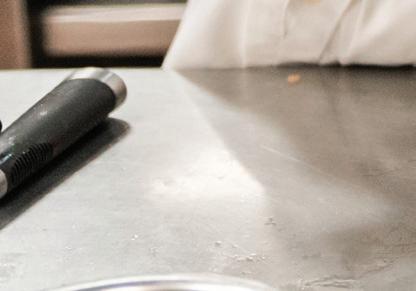








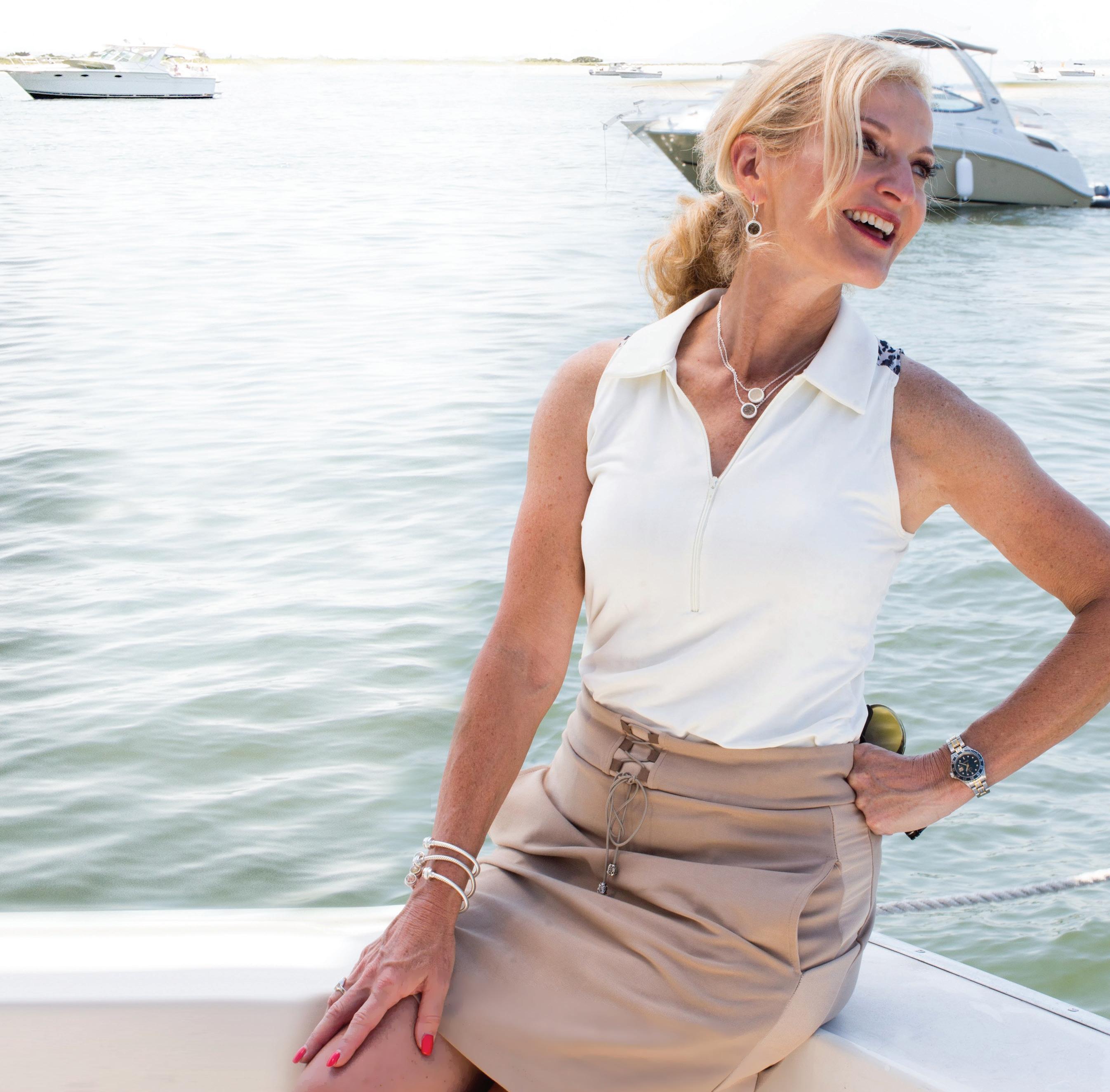
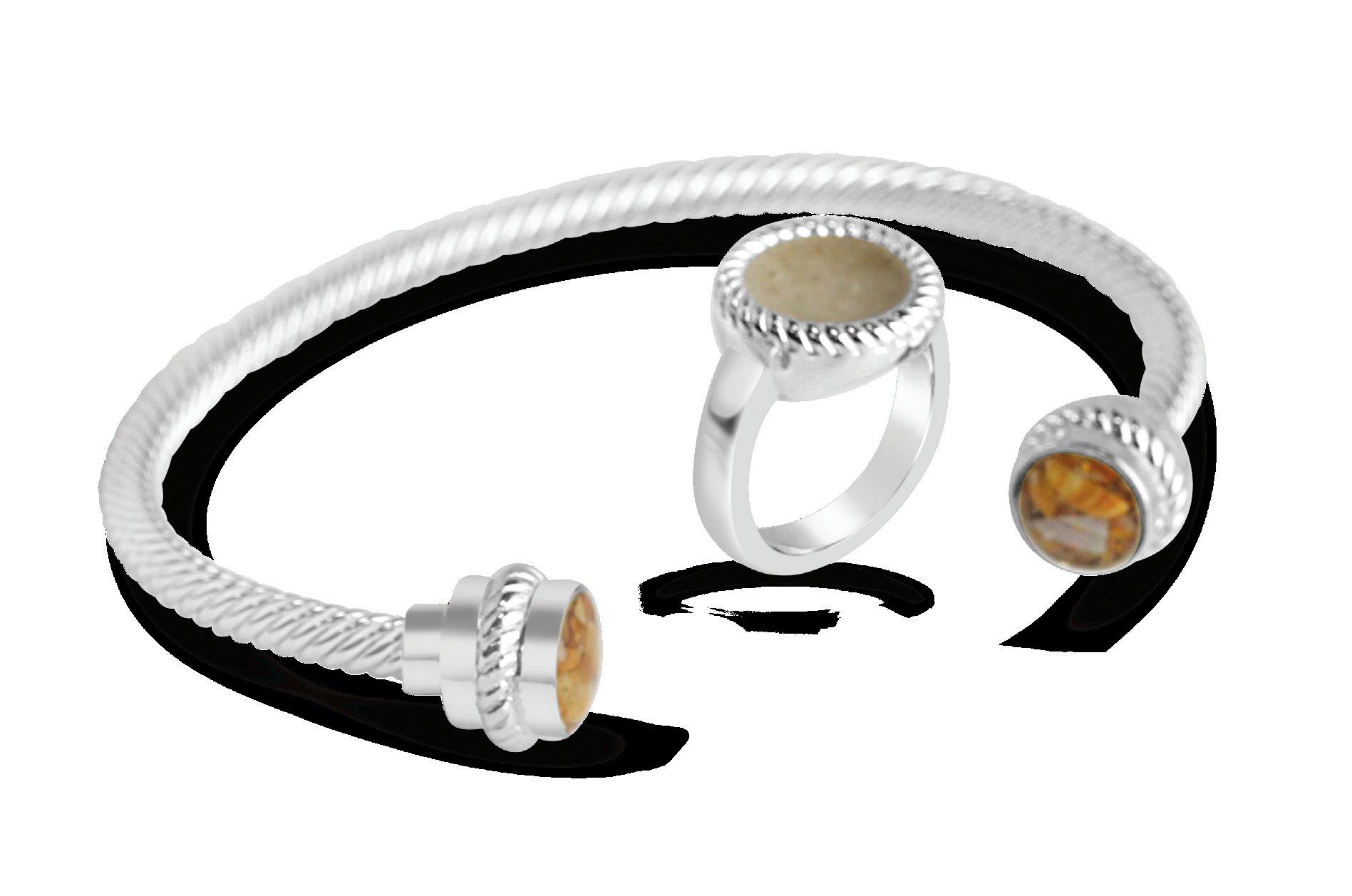
® #WEARYOURTRAVELS EXPERIENTIAL JEWELRY ® HANDMADE WITH SAND & NATURAL ELEMENTS FROM AROUND THE WORLD. Discover The Hamptons Rope Collection, a creative collaboration between Ann Liguori & Dune Jewelry
Chef Paul Sorgule is a seasoned veteran of both quality restaurant operations and culinary education administration.
Sorgule is the founder and president of a restaurant and culinary school consulting firm: Harvest America Ventures, LLC (www.harvestamericaventures. com), providing menu-planning, systems development, training and quality assessment for restaurants, hotels and resorts as well as assistance in curriculum development and faculty training for secondary and post-secondary institutions.
Chef Sorgule served as Executive Chef of the Mirror Lake Inn, helping to bring the fourth diamond recognition for the Inn’s restaurant – The View. He held the position of Dean of Culinary Arts and Hospitality Management at Paul Smith’s College for 26 years where he developed associate and baccalaureate degrees in both disciplines. Most recently, Sorgule served as Vice President of Culinary Education at the New England Culinary Institute in Montpelier, Vermont.
In 1988, as a member of the New England Culinary Olympic Team, Chef Sorgule was awarded a gold medal at the Culinary Olympics in Frankfurt, Germany. In 2001, the American Culinary Federation (ACF) recognized Chef Sorgule as the National Culinary Educator of the Year.
In 2008, Chef Sorgule was invited to bring the Mirror Lake Inn Culinary Team to cook at the
prestigious James Beard House in New York City. Additionally, he served as a member of the ACF Accrediting Commission, chair of the Education Services Committee for the ACF and board member for the Research Chefs Association (RCA).
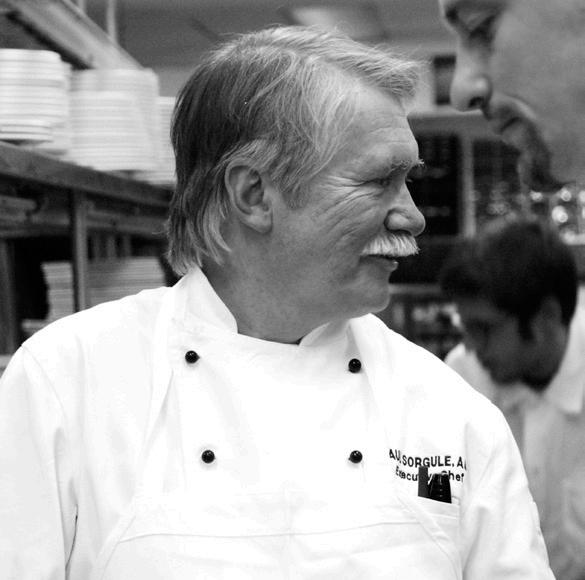
Sorgule earned a Master’s Degree in Hospitality/Service Management from the Rochester Institute of Technology. He is the author of 2007 and 2014 books entitled: In the Shadow of Cooks, and The Event That Changed Everything, publishes weekly blog posts for the industry through www.harvestamericacues.com, and is commissioned to write for numerous other professional organizations.
Contact:
Email: psorgule@hotmail.com Web: www.harvestamericacues.com
Originally from Cape Town, he first travelled to the USA in 2012 and went on to study at the New York Institute of Photography.
From 2012-2018, he explored various parts of the United States, while documenting his travels and working in some of the most esteemed country clubs in the world. Gideon is known for his creative technique, developed from combined experience in a wide range of genres, including portraits, documentary, architecture, weddings and events.
He now resides near Miami, and works full time as a Social Media Marketer & Content Creator.
Contact: Email: media@addisonreserve.cc Web: www.addisonreserve.cc
 Gideon Dariyal Heller is a creative professional based in South Florida, United States.
Gideon Dariyal Heller is a creative professional based in South Florida, United States.
CONTRIBUTORS
Wycliffe Golf & Country Club Wellington Florida

 The stunning GlenArbor Clubhouse.
The front entrance of Wycliffe Golf & Country Club Image courtesy Wycliffe G & CC
The stunning GlenArbor Clubhouse.
The front entrance of Wycliffe Golf & Country Club Image courtesy Wycliffe G & CC
INTERVIEW
Christopher Park Executive Chef
I was introduced to Christopher Park, by Rob Martin, the General Manager, who contacted me via LinkedIn to tell me about their extensive renovations. He was very passionate about them, and when the renovations were complete, I was delighted to meet and work with Rob, Christopher, and their passionate and enthusiastic team. I was particularly impressed by the member/staff communications policy. ~ Diana DeLucia
GK: Tell us a little about your background history.
I am originally from Texas, but moved to Palm Beach County, Florida, when I was five years old. I went to high school here, and two weeks after graduating, I went right to the Florida Culinary Institute.
At age 16, during high school, I started working in a restaurant for a Marriott Hotel in the area. I quickly went from washing dishes to working the fry station, and I fell in love with it. I signed up for culinary school in my sophomore year of high school. I knew from a young age that I wanted to be a chef.
When I graduated, I worked at The Breakers in Palm Beach, which was a Forbes Five-Star, AAA Five Diamond resort. I started as a cook and quickly got involved with everything. After six months, I became a Saucier Chef.
After 9/11, everyone stopped traveling, hotels and resorts became like ghost towns and had to lay off a lot of staff. I went to work for a private club as a Restaurant Chef for a little while, and then an a la carte restaurant. My mentor at the time, Warren Lee, said, “you have learned this, and now it’s time to move to a
high-volume restaurant to learn more speed and mass volume.” From there I helped open a new restaurant, Bimini Twist. I worked my way to Sous Chef by the time I was 20, and then I knew it was time to move onto something more challenging.
A friend of mine told me that a position was open at BallenIsles Country Club as a Restaurant Chef. I went for an interview, was asked to do a tasting, and that’s where I met Michael McCarthy, who was the General Manager at the time. I got the position and began working with Chef Jerome Nicholas. I was promoted to Executive Sous Chef after a year and stayed for five years. When Jerome went to Ibis Golf and Country Club, he asked me to join him and I worked as his Executive Sous Chef for ten years.
GK: What brought you to Wycliffe?
It was 2017, and I was waiting for the right opportunity as an Executive Chef. I interviewed at many locations but couldn’t find the right fit until I met Rob Martin, the General Manager. I liked the vision and the direction that Wycliffe wanted to go in. I thought it was a perfect opportunity as they were renovating the entire clubhouse, kitchen, and dining facilities. Just the thought of being a part of such an evolution excited me.
GK: Tell us about the transition?
It was an interesting one! When I came in, they had rough ideas of what they wanted to do. The entire program had to be redone including kitchens, dining rooms, and space allocations. I got involved with all these plans and layouts as I wanted to make sure everything would flow.
Golf Kitchen Magazine 16
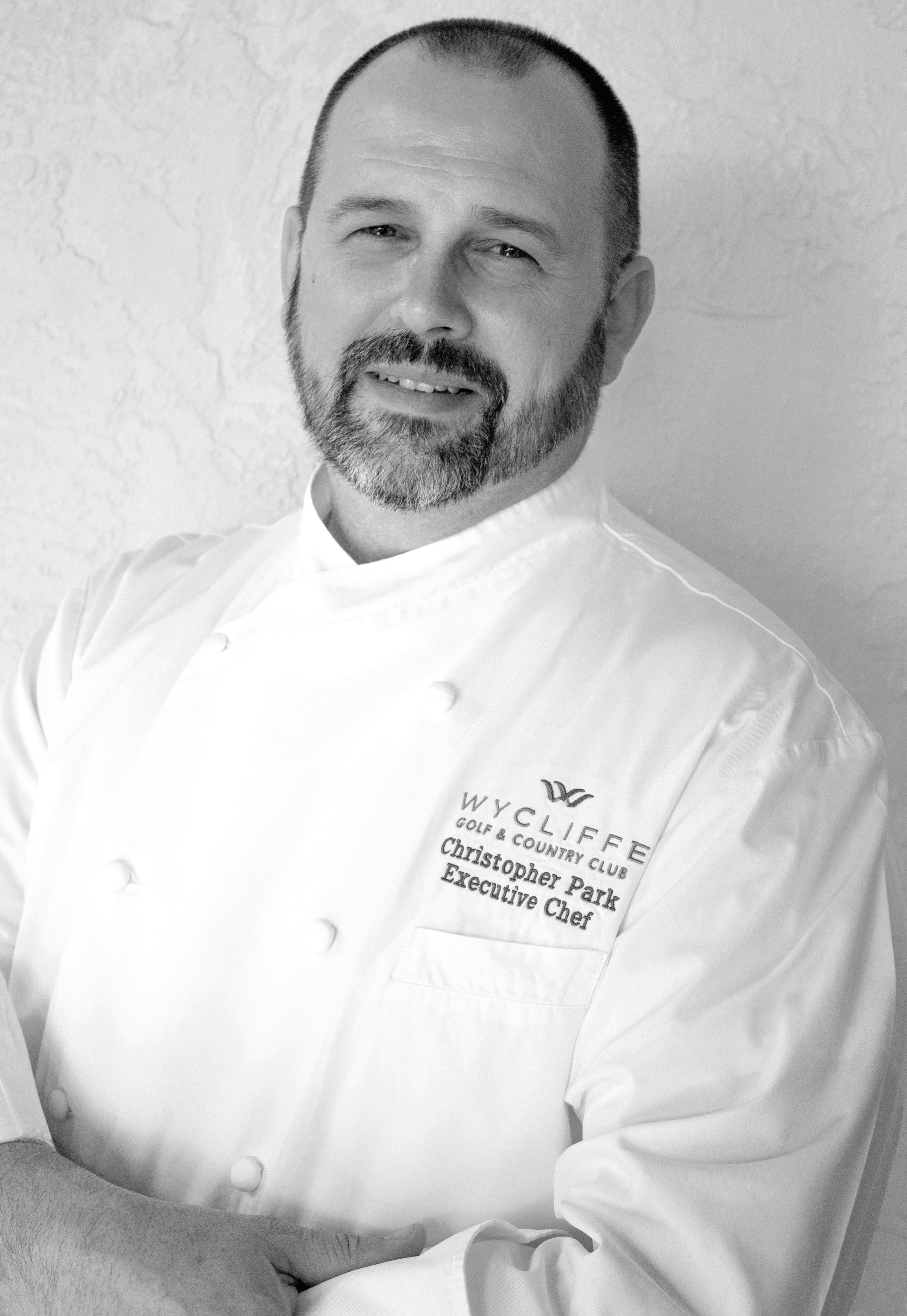
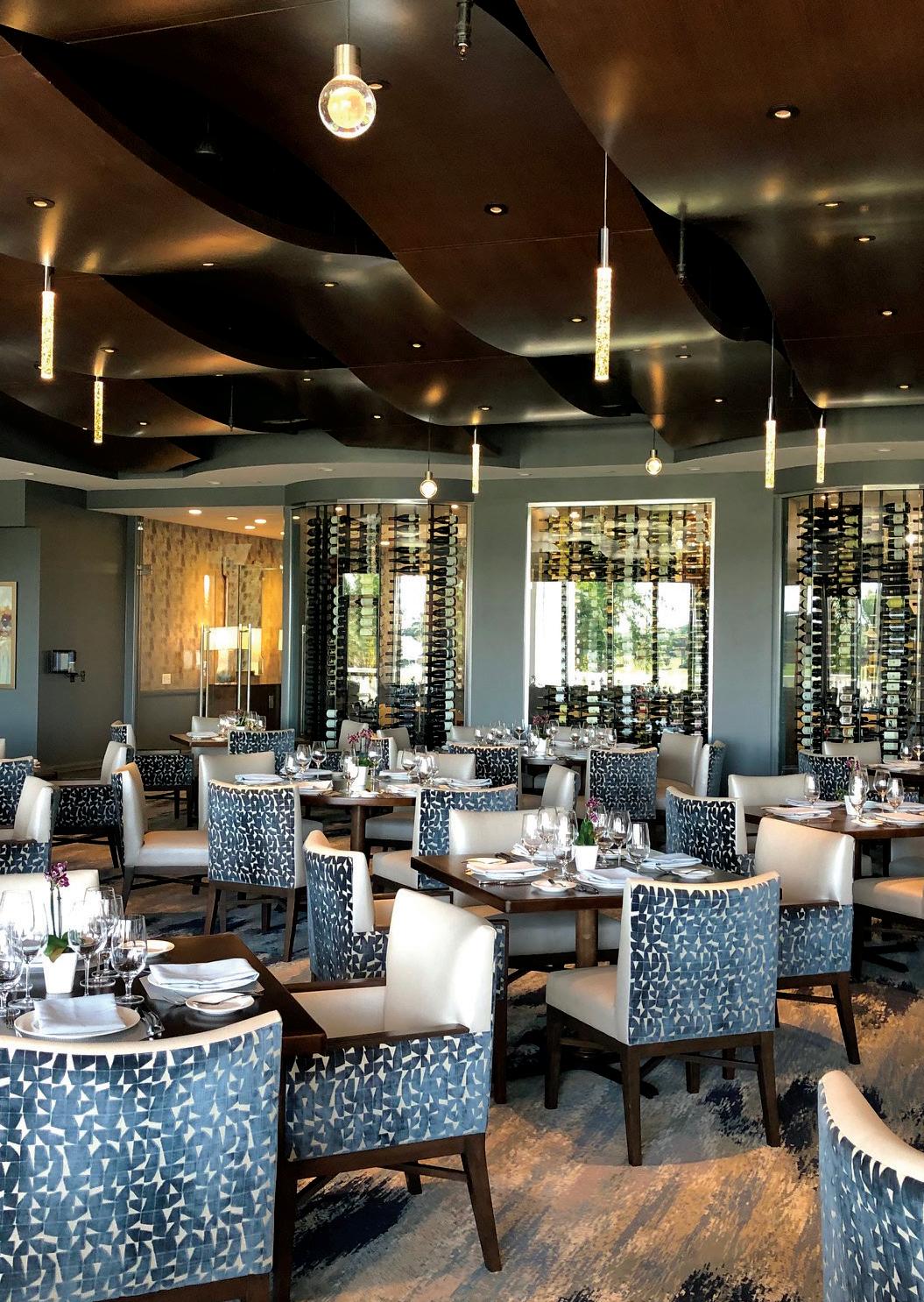 Flavours at Wycliffe Golf & Country Club
Image courtesy Wycliffe G & CC
Flavours at Wycliffe Golf & Country Club
Image courtesy Wycliffe G & CC
GK: How did the membership feel about the plans?
The membership was excited about what the future could be, and it was nice to work for them. We had all these drawings to help them visualize the end result and there was communication throughout the entire process.
GK: You have an open-door policy here for members and staff, tell us about that.
I have always encouraged my staff and members to share feedback with me. We have a select group of members that sit on a committee and we meet monthly to get feedback, good or bad, from the rest of the membership. It helps us immensely.
I was told a long time ago when I started this business, I’m not cooking for myself, I am cooking for the members and their guests. I encourage my team to get out there to learn what the members want and listen to what they have to say. We have over 1,900 members. I know I can’t cater to every single one of them with every single dish, but I do have a policy that if they give me notice, I will do my best to help them in any way I can. If they have a special request and give me 24 hours, I’ll make it happen.
GK: Tell us how you balance simple foods, buffets, banquets, and fine dining.
Many times, members want simple food when they get off the golf course or tennis courts. They want a quick bite before they go home and relax. They also want significant events, and these change all the time. We can do a music concert one night, and the next morning a card party for a women’s group. It’s always something different, and we must continually evolve to impress them each day.
GK: What is your take on farm-to-table?
We’ve created four farm-to-table dinners, which started in 2019. Farm-to-table to me is using ingredients that are locally caught or grown. Palm Beach County doesn’t have many farms for beef, but I can find seafood in abundance. I have locally harvested honey from hives about two miles up the road. There are many different farms that we can go to for freshly grown
lettuce, a lot of them are hydroponic lettuce. I was even able to find locally grown fruits and vegetables. I tell the members that 85% I can source locally, but the rest is not available, and I source from very reliable farms out of state or internationally, depending on the product.
GK: Tell us about the charity work you are involved with.
We give back by doing what we know, and that is cooking. A lot of chefs, through programs such as the American Culinary Federation (ACF), work with various charitable events, and we’re able to do a lot as a group.
One stand-out event is the Culinary Creations Dinner that Chef Jeff Simms from The Breakers puts together. There are approximately 60 or 70 chefs, and we each make one plate. Each table seats ten, and every dish is different, we do about five or six courses.
I get to give back by doing what I love. I encourage my staff to get involved as well; I believe it is fundamental to give back to the community that has raised you.
GK: What is your advice to purveyors that wish to work with Wycliffe or other area golf and country clubs?
I’ve had a lot of vendors come in and try to sell me things or to use their products. I’ve been in this business for about 30 years, and I have purveyors that I know I can trust, the owners
19
Wycliffe Golf & Country Club
“I’m not cooking for myself I am cooking for the members and their guests. I encourage my team to get out there, and learn what the members want, listen to what they have to say.”
are still the same owners. New food businesses are being started every day, but for me it’s about trust and consistency. It needs to be a mutual partnership.
I prefer to do business directly with the farmers, if they grow the tomatoes, they have accountability and a passion, to ensure they are delivering on their promise of quality ingredients.
GK: How important is saucing in creating your menus?
Only certain dishes need a sauce. The sauce should accompany the other ingredients, not just to cover the food. It should be used as a garnish on the plate and help enhance the flavor
GK: Where do you want to take the culinary scene at Wycliffe in the future?
The beauty of working in a country club environment is that there is no choice but to be evolutionary in everything that we do- from a culinary standpoint and beyond. We cater to the same audience, day in and day out, so becoming complacent just isn’t in the cards. As for the future of culinary scene – we listen to our members, we educate ourselves on what is hot in the market outside the gates and we do the very best we can to maintain satisfaction and keep our members inside the Club.
of the dish. There are a lot of different sauces that we can create, but there’s also relishes, compotes and aioli’s that you can add to a dish to make it enjoyable.
GK: Tell us about your use of technology here?
We just started with a new Wycliffe app and I had access to it prior to the member launch. I admit, I’m not the most tech-savvy guy, but I found it super easy to use! What I love about it is for member identification; it helps me put a name to a face, so to speak. We’re able to post all our menus, upcoming events or schedule changes. There’s a great push notification feature that only adds to our ability to communicate with them.
Golf Kitchen Magazine 20
“The sauce should accompany the other ingredients, not just to cover the food. It should be used as a garnish on the plate and help enhance the flavor of the dish.”
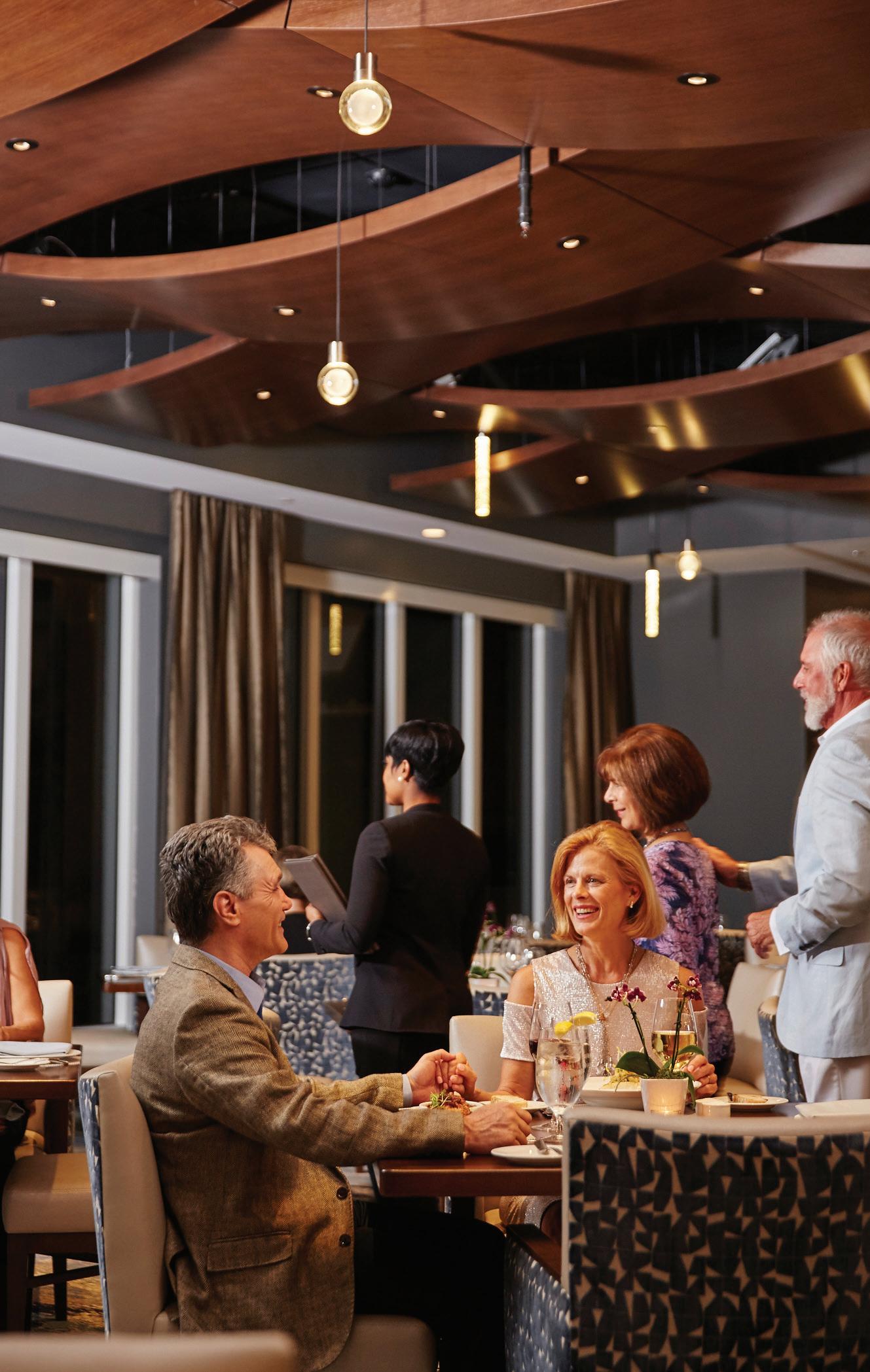 Flavours at Wycliffe Golf & Country Club
Image courtesy Wycliffe G & CC
Flavours at Wycliffe Golf & Country Club
Image courtesy Wycliffe G & CC
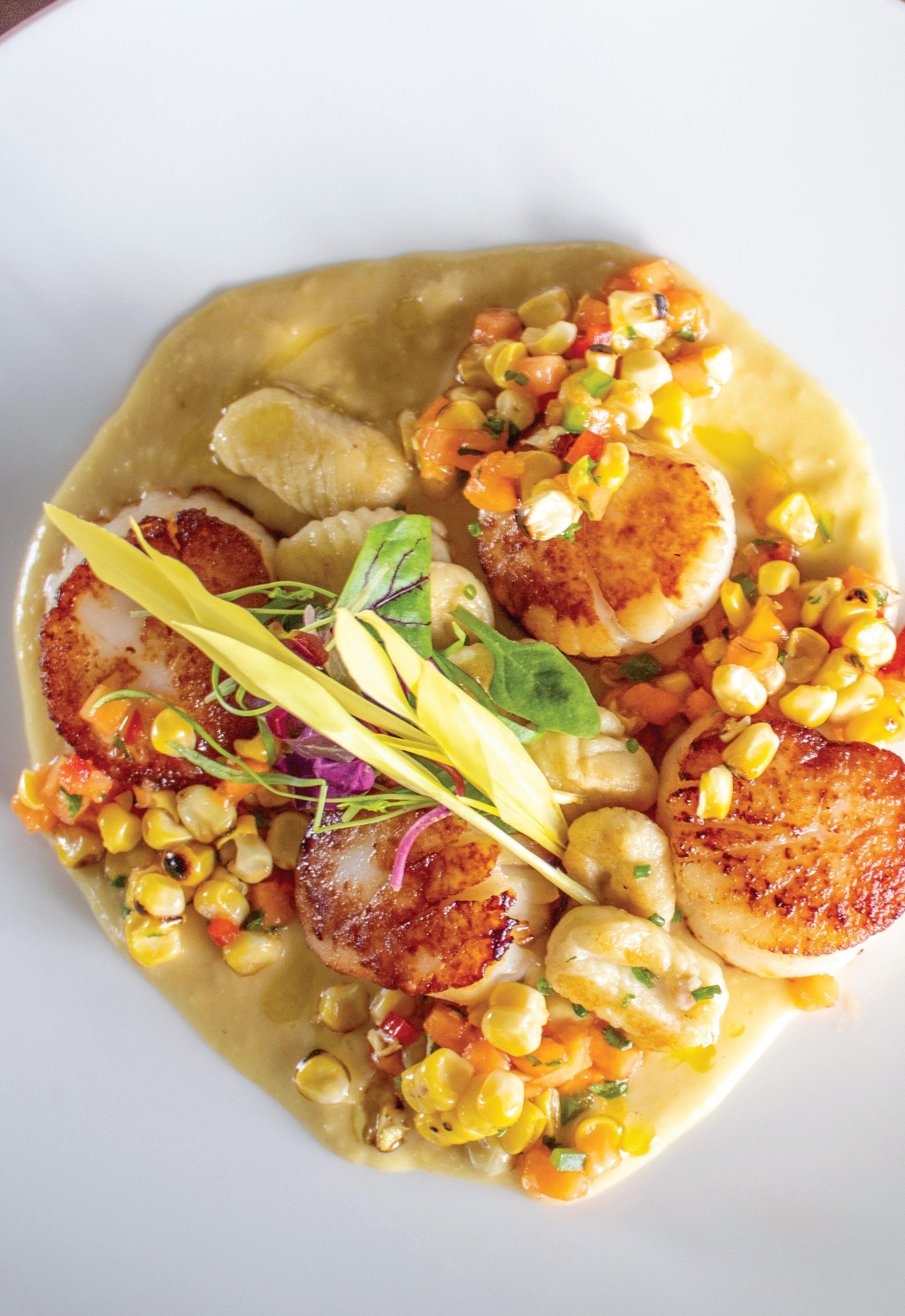
SCALLOPS with Ricotta Gnocchi, Sweet Corn Purée and Corn Papaya Relish

Yields 4
Ingredients
Sautéed Scallops
• 16 U10 Scallops
• Salt and Pepper (to taste)
• 1 Tablespoon Olive Oil
Sweet Corn Purée
• 4 cobs Yellow Corn (cut off cob)
• 2 cups Chicken Stock
• 1/2 large Onion (diced)
• Salt and Pepper (to taste)
• 1 Potato (peeled and diced)
• 1 Tablespoon Olive Oil
Corn Papaya Relish
• 1/2 cup Corn (cooked and cut off the cob )
• 1/2 cup Papaya (diced small)
• 1/4 Red Pepper (diced small)
• 1 Tablespoon Parsley (chopped)
• Olive Oil
• Salt and Pepper (to taste)
Ricotta Gnocchi
• 12-14 ounces Potatoes
• Ricotta Cheese
• 1 cup Flour
• 2 Eggs
Garnish
• Corn Shoots
• Extra Virgin Olive oil
23 Wycliffe Golf & Country Club
RECIPE BY CHRISTOPHER PARK
Preparation
Sautéed Scallops
Heat a sauté pan with oil. When hot, season the scallops and carefully place them in the pan.
Cook for 3 minutes and then turn, cook for 3 minutes and remove from heat.
Sweet Corn Purée
In a frying pan, sauté the onion in olive oil until tender. Add the corn, potato and chicken stock. Cook until potatoes are tender. Drain the Chicken stock and keep for later.
Place the corn, potatoes and onions in blender adding a little of the stock. Purée until smooth and add more liquid to get to desired thickness. Season to taste.
In a bowl mix all of the ingredients together and season with salt and pepper. Let rest for 1/2 hour before serving.
Ricotta Gnocchi
In a large saucepot,boil the potatoes until very tender. Drain. While the potato is warm press through a potato ricer. Chef Note: This should make 2 cups.
In a mixing bowl, mix the potatoes and salt together. Fold in the flour until the dough holds together but is not sticky. If sticky add more flour.
Divide into six equal pieces. Roll dough out into 1/2 inch logs. Cut into 3/4 inch pieces. Dredge flour on top to avoid the dough becoming sticky. Use a fork or a gnocchi ridger to seal.
Place gnocchi in boiling salted water until they float. Remove with spider or slotted spoon.
Serve immediately.
Wine Match
Sanford, Santa Rita Hills, California, 2016
 Corn Papaya Relish
Corn Papaya Relish
Golf Kitchen Magazine 24
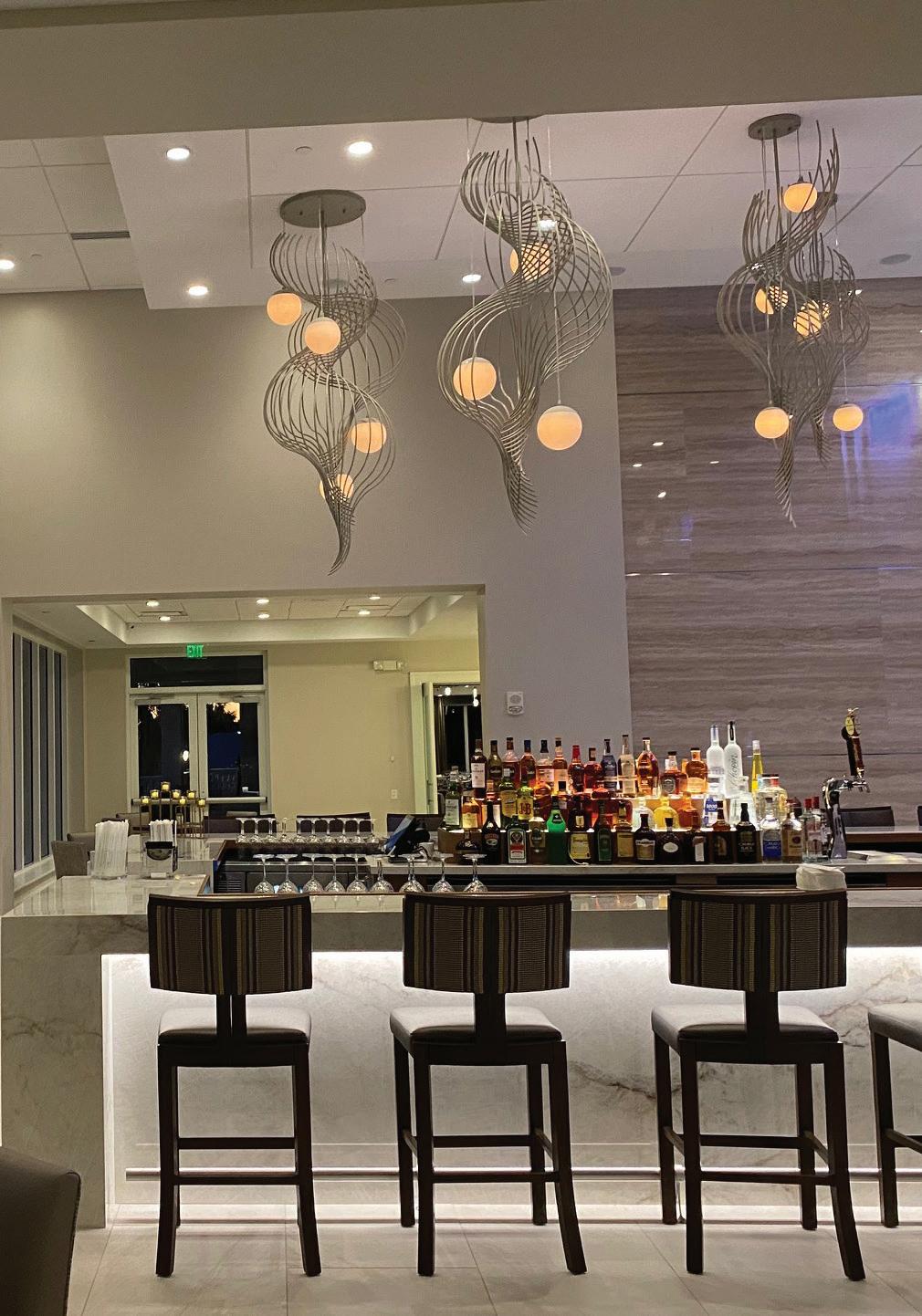 The Cliffe at Wycliffe Golf & Country Club
Image courtesy Wycliffe G & CC
The Cliffe at Wycliffe Golf & Country Club
Image courtesy Wycliffe G & CC

GRILLED LAMB CHOPS with Fingerling Potato Cake and Julienne
Zucchini
Yields 2
Ingredients
Seared Lamb Chop

• 3 Lamb Chops (2 ounces each, fat removed)
• 1 teaspoon Garlic (chopped)
• 1 teaspoon Thyme (chopped)
• Salt and Pepper (to taste)
• Olive Oil
Pan Sauce
• Wine
• 1 cup Beef Stock
• 1 Tablespoon Butter
Fingerling Potato Cake
• 1 pound Fingerling Potatoes
• 1 teaspoon Parsley
• 1 teaspoon Chives
• 1 teaspoon Garlic
• Dijon Mustard
• Olive Oil
• Salt and Pepper
Zucchini Spaghetti
• 2 Zucchini (slice on julienne setting on a mandolin the length of the zucchini)
• 1 Tablespoon Butter
• Salt and Pepper (to taste)
Garnish
• Assorted Baby Vegetables
• Butter
• Salt and pepper
27 Wycliffe Golf & Country Club
RECIPE BY CHRISTOPHER PARK
Preparation
Seared Lamb Chops
Season the lamb with Garlic, thyme, salt and pepper. Heat a sauté pan and add olive oil. Gently place the lamb in sauté pan and cook on each side for 4 minutes.
Pan Sauce
Deglaze the pan with wine and reduce until dry. Add 1 cup beef stock and reduce by half. Finish with 1 Tablespoon of butter. Reserve.
Fingerling Potato Cake
In a saucepot, boil the Fingerling potatoes in water until tender. Remove from water and place in avbowl and add the Dijon mustard, olive oil, parsley, chives and garlic and mix together.
Season with salt and pepper.
Shape in a round mold about 1 inch thick. Sauté in a pan with a little olive oil until gold brown. Place in oven at 350°F for 7 minutes.
Zucchini Spaghetti
Melt the butter in a sauté pan. Add the julienne zucchini and sauté until tender. Season with salt and pepper to taste.
Garnish
Blanch the assorted baby vegetables in salted boiling water until tender than sauté in pan with butter and salt and pepper.
Assembly
Place the fingerling potato cake into the center of the plate. Top with the zucchini. Place the lamb around the cake with the bone resting against each other. Drizzle with pan sauce. Garnish with the baby vegetables.
Wine Match
Penfolds Shiraz Bin 389 2016

Golf Kitchen Magazine 28
 The back of the clubhouse at Wycliffe Golf & Country Club Image courtesy Wycliffe G & CC
The back of the clubhouse at Wycliffe Golf & Country Club Image courtesy Wycliffe G & CC
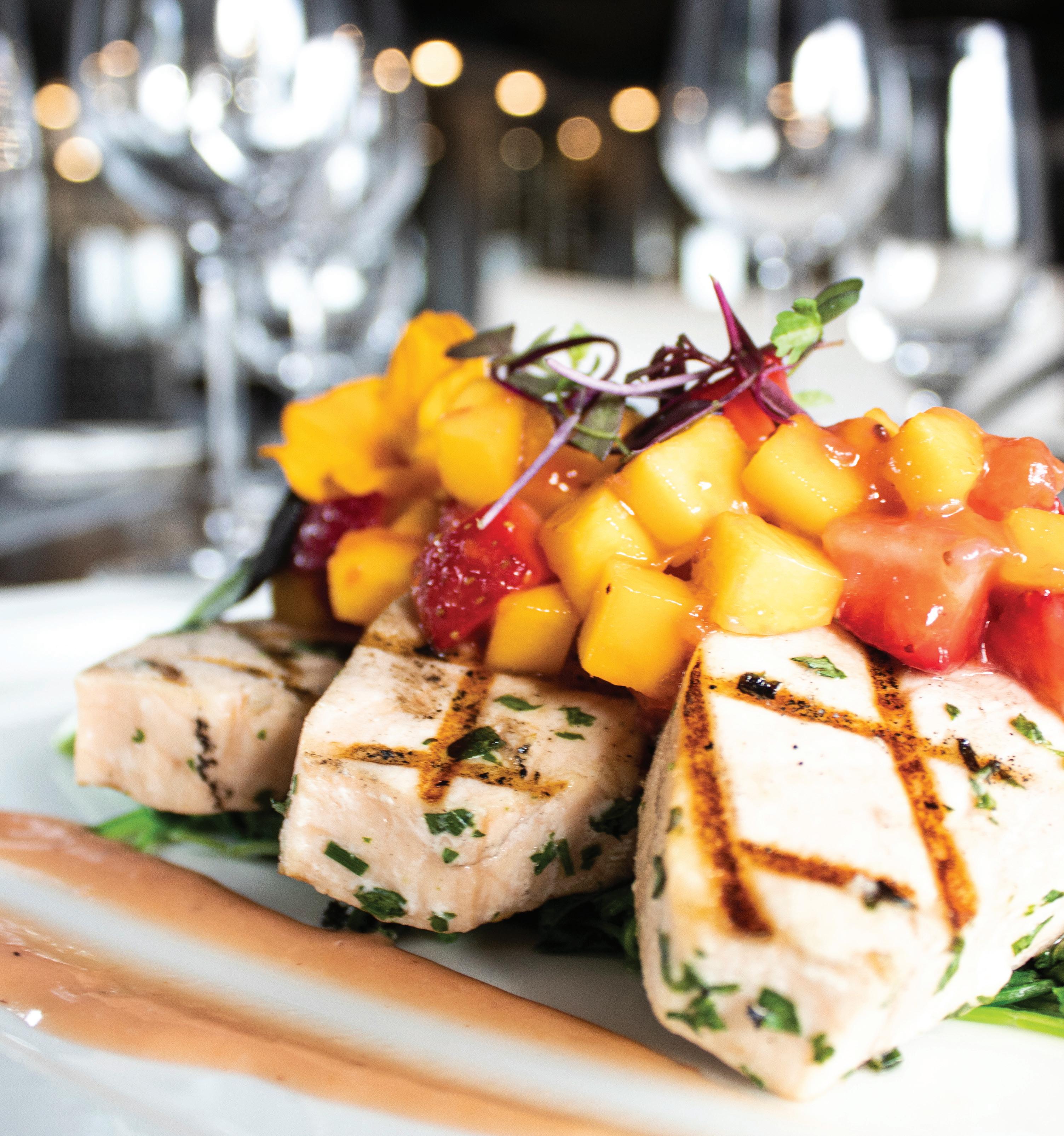
Golf Kitchen Magazine 30
RECIPE BY CHRISTOPHER PARK
Pumpkin Swordfish with Strawberry and Mango Vinaigrette and Wilted Arugula
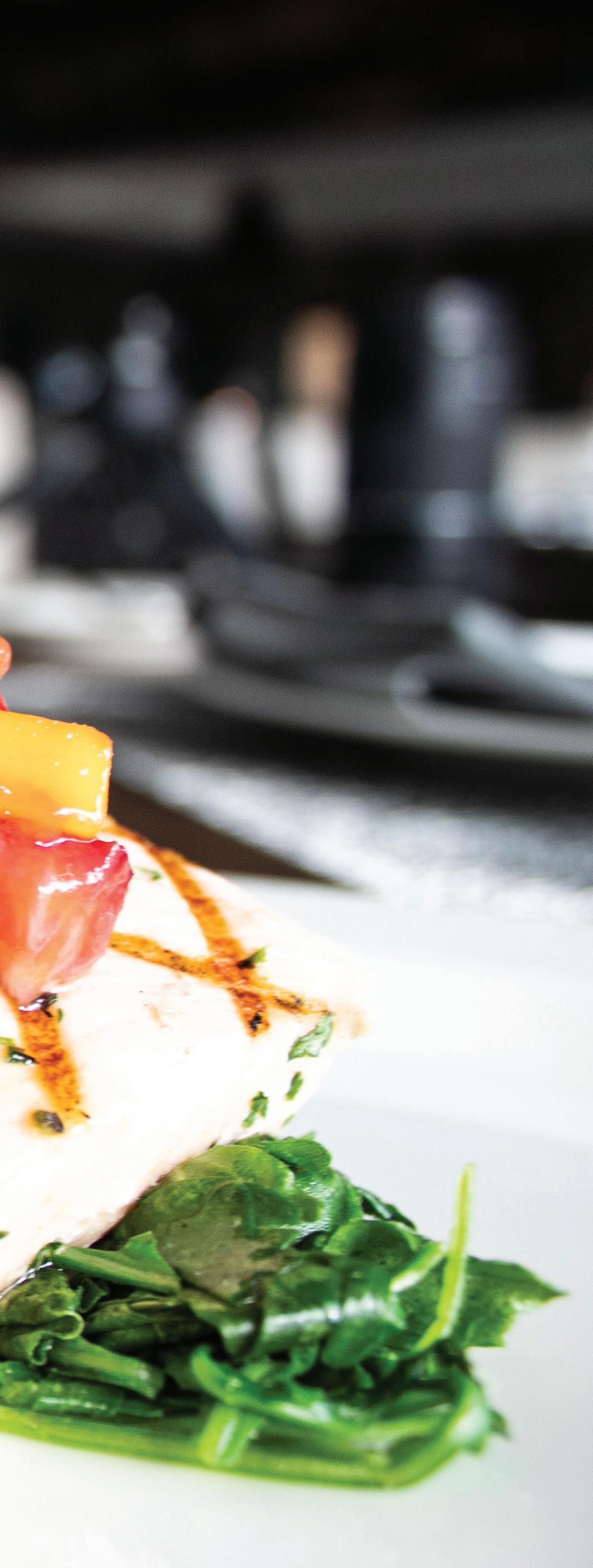
Serves 4
Ingredients
Pumpkin Swordfish
• 1.5 pounds Pumpkin Swordfish (cut into 2 ounce pieces)
• 1 Tablespoon Garlic
• 2 Tablespoons Olive Oil
• Zest of 1 Lemon
• 1 teaspoon Thyme
• Salt and Pepper
Strawberry Mango Preserved
• 2 cups Strawberries (diced)
• 3 cups Mango (diced)
• 1/2 cup Sugar
• 1/4 cup White Balsamic Vinegar
Strawberry Mango Vinaigrette
• 1 teaspoon Dijon Mustard
• 1 cup Salad Oil
• 2 Tablespoons White Balsamic Vinegar
• 1 cup Strawberry Mango Preserved (see recipe above)
• Salt & Pepper
Strawberry Mango Relish
• 1 cup Mango (diced)
• 1 cup Strawberries (diced)
• 3 ounces Strawberry Mango Preserved (see recipe above)
Wilted Arugula
• 5 ounces Arugula
• 1 Tablespoon Olive Oil
• Salt and Pepper (to taste)
Garnish
• Micro Greens
• Micro Flowers
Wycliffe Golf & Country Club 31
Preparation
Pumpkin Swordfish
Mix all the ingredients together in a mixing bowl and marinate for 3o minutes.
Place on a grill and cook for 4 minutes per side. Let rest.

Strawberry Mango Preserved
Sauté the mango, strawberries and sugar on a low heat until they break down, stirring consistently. Add the white balsamic vinegar and simmer for 30 minutes. Let cool.
Strawberry Mango Vinaigrette
Add the strawberry mango preserved, mustard and vinegar into a blender. While on a low speed slowly add the oil until smooth. Season to taste.
Strawberry Mango Relish
In a mixing bowl, mix all of the ingredients together.
Wilted Arugula
Heat a sauté pan with oil and wilt the arugula for a few minutes. Season to taste.
Assembly
Place the arugula in a straight line in the middle of the plate.
Top with three pieces of swordfish and cover with Strawberry mango relish. Swipe the plate with the Strawberry mango vinaigrette.
Garnish with micro greens and micro flowers.
Wine Match
Torre La Moreira, 2018
Golf Kitchen Magazine 32
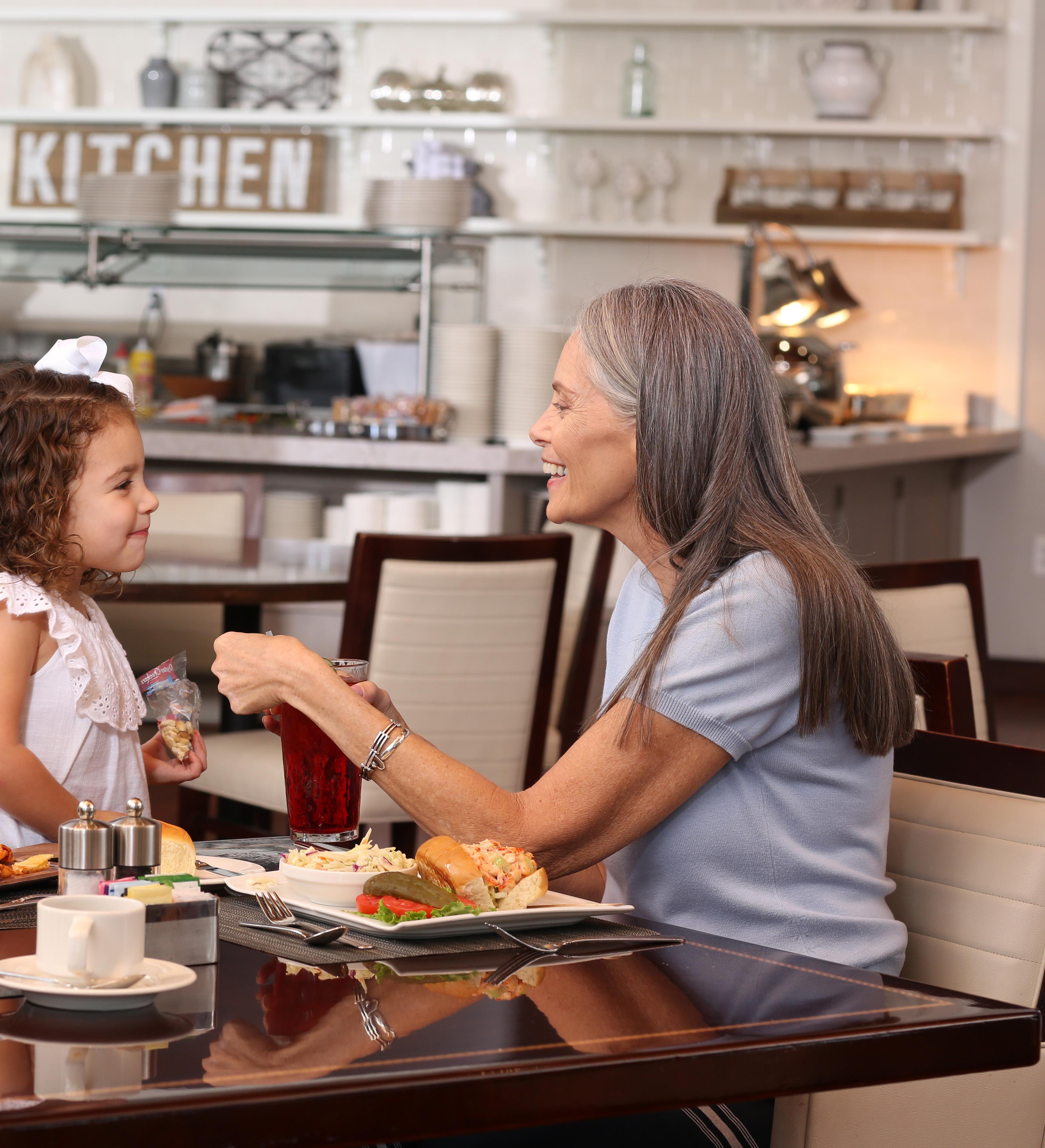 The Grille at Wycliffe Golf & Country Club Image courtesy Wycliffe G & CC
The Grille at Wycliffe Golf & Country Club Image courtesy Wycliffe G & CC
RECIPE BY CALLIE MEYER, EXECUTIVE PASTRY
CHEF AT WYCLIFFE GOLF AND COUNTRY CLUB
CHOCOLATE KAHLUA PETITE GATEAU
Yields 1
Ingredients
Chocolate Mousse

• 1 pound Cocoa Barry 58% or higher
• 1 quart Heavy Cream (whipped)
• 4 ounces of Egg Whites
• 2-1/2 ounces Egg Yolk
• 4 ounces Hot Coffee
• 2-1/2 ounces Sugar
Kahlúa Caramel Mousse
• 8 ounces Barry Zephyr Caramel 35%
• 4 ounces Heavy Cream
• 4 ounces Heavy Cream (whipped)
• 1 ounce Kahlúa
• 1 Tablespoon Coffee Extract
Chocolate Mirror Glaze
• 7 ounces Water
• 7 ounces Heavy Cream
• 1/3 cup Cocoa Powder (extra brute)
• 4 leaves Silver Gelatin (bloomed)
Hazelnut Dacquoise
• 5-1/2 ounces Hazelnut Flour
• 6 ounces Powdered Sugar
• 6 Egg Whites
• 2 ounces Sugar
• 1/4 teaspoon Cream of Tartar
• 6 ounces Melted Tempered Chocolate
• 5 ounces Feuilletine
Additional Items for Plating
• Fresh Raspberries
• Micro Mint
• Brownies (sliced thin and dehydrated)A
Golf Kitchen Magazine 34
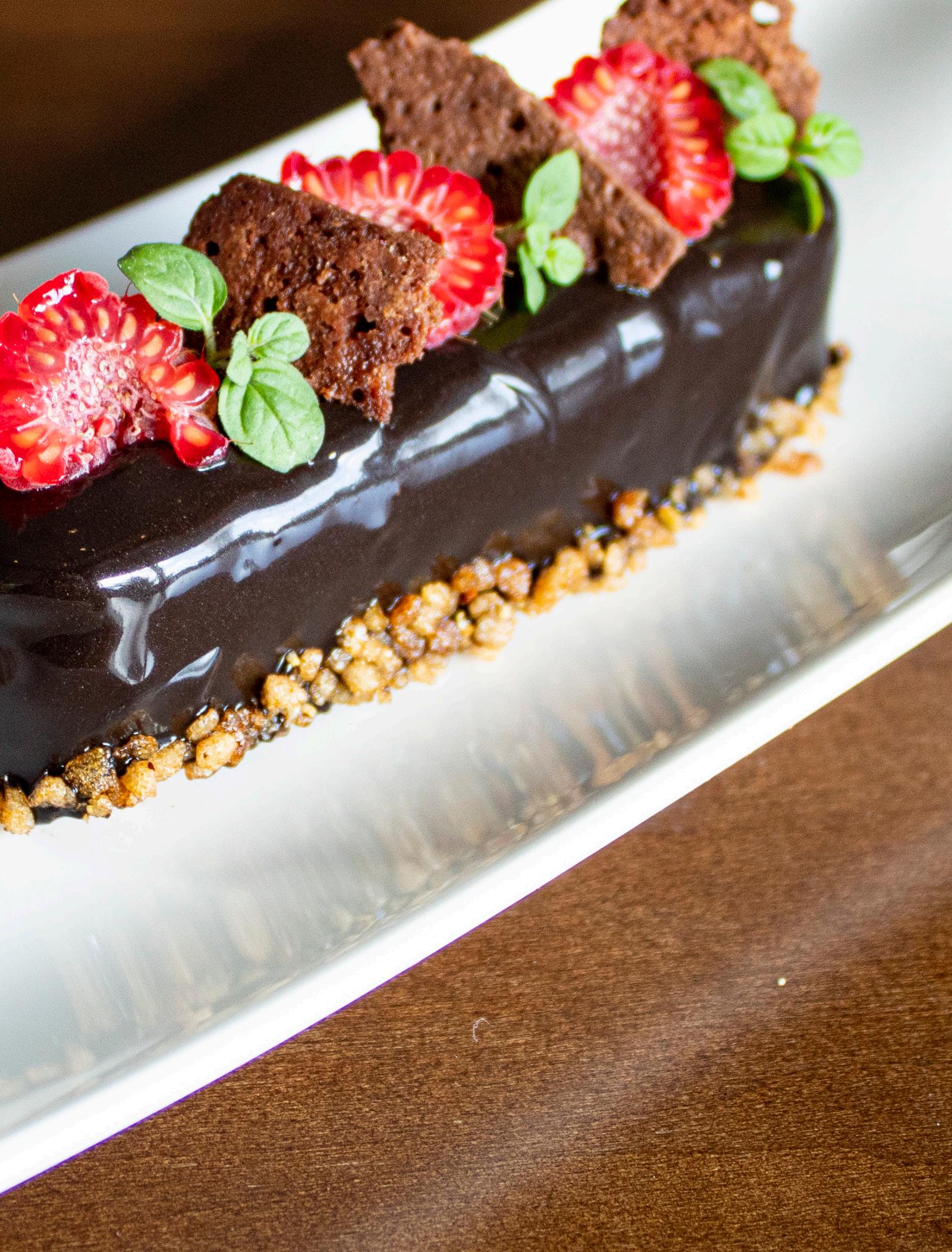
 The Veranda at Wycliffe Golf & Country Club
The Veranda at Wycliffe Golf & Country Club
Golf Kitchen Magazine 36
Image courtesy Wycliffe G & CC
Preparation
Chocolate Mousse
Melt chocolate over a double boiler and remove from stove. In a separate bowl whip the egg yolks until thick then add in the coffee and egg mixture and pour in the the melted chocolate. In a another bowl, whip the egg whites and sugar and fold into the chocolate mixture.
Finally, fold in the whipped cream in three stages.
Kahlúa Caramel Mousse
Bring 4 ounces of cream to a simmer and pour over the Zephyr caramel chocolate.
In a bowl whip the cream with 1 ounce of Kahlúa. Fold the Kahlúa whipped cream into the Zephyr caramel mixture. Place into piping bag with a small star tip.
Chocolate Mirror Glaze
Bring water, heavy cream and cocoa powder to a simmer. Let the chocolate mixture cool slightly, and add the bloomed gelatin. Chill.
Hazelnut Dacquoise
Sift flour and powdered sugar and set aside. Whip egg whites, sugar and cream of tartar to soft peaks. Gently fold the flour mixture into the egg whites. Spread evenly on a half sheet tray. Bake at 350°F about 10 minutes, or until it springs back. When cool, mix with the Feuilletine and tempered chocolate and spread a thin layer over the Dacquoise. Using Silkomart Fashion Eclair mold inside cutter, punch out 8 pieces.
Assembly
Fill Silkomart Fashion Eclair mold half way with chocolate mousse, followed by a thin layer of Kahlúa caramel mousse.
Add the hazelnut Dacquoise insert. Fill the remaining portion of the mold with the chocolate mousse. Freeze. Unmold. Warm the mirror glaze and pour it over the frozen mousse on a wire rack and let the glaze set.
Plate with the remaining Kahlúa Caramel mousse, fresh raspberries, brownie crisps and micro mint.
Wine Match
Dow’s 10 year Tawny Port

Wycliffe Golf & Country Club 37
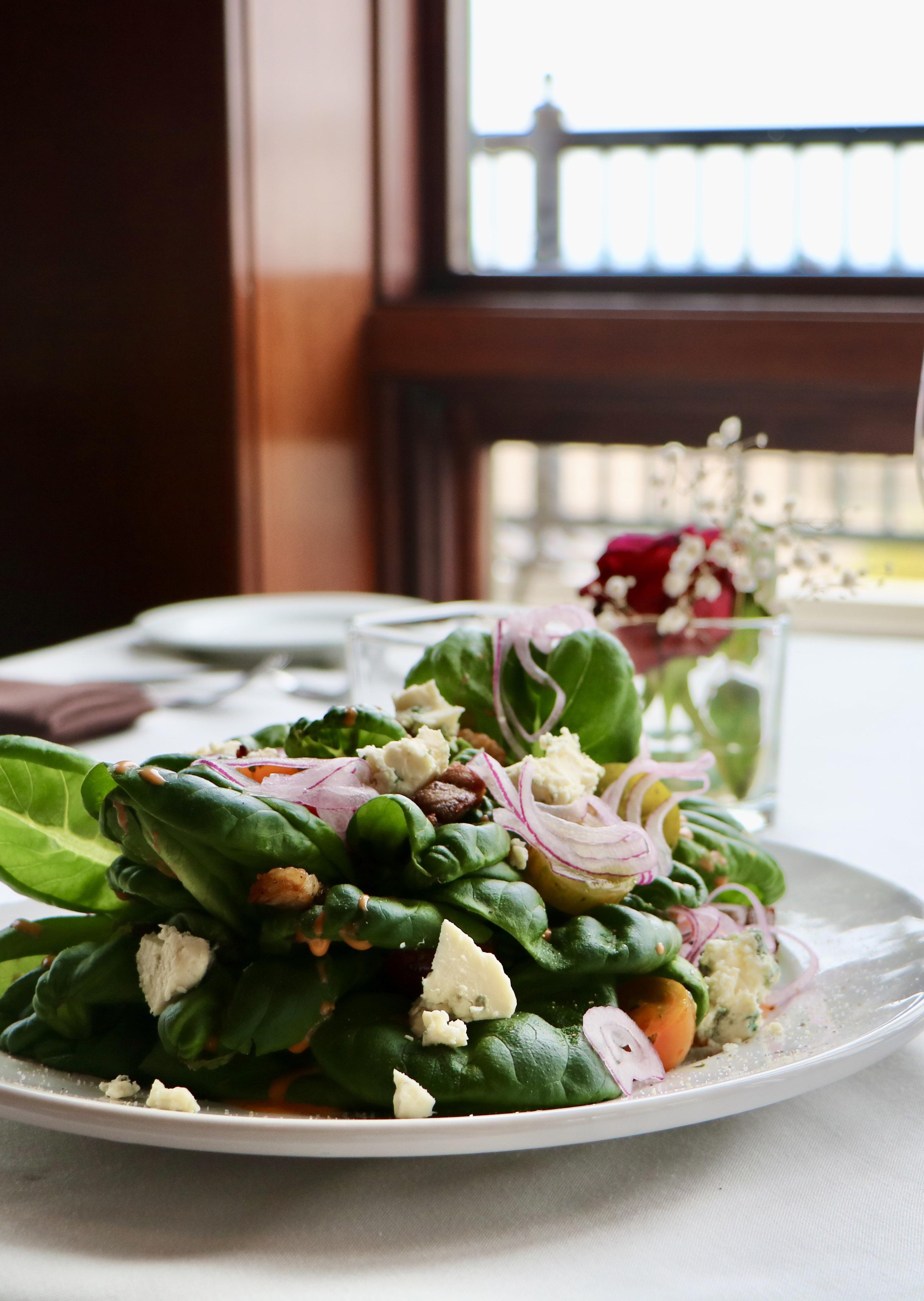 Image courtesy of The Madison Club Madison, Wisconsin, USA
Image courtesy of The Madison Club Madison, Wisconsin, USA
A Fresh TAke on Club Dining
 by Alex Tyink
by Alex Tyink
There is nothing quite like working with freshly harvested produce. You can distinctly smell, feel and see the difference in quality - there is an unequivocal vibrance to the product. From fragrant, sweet and peppery basil to crisp, succulent romaine, you cannot help but notice the abundance of flavor in each bite.
Now, imagine if you were able to have year-round access to this quality produce steps away from your kitchen. Within minutes, you could harvest, prepare and serve delicious food to your members. This might sound a bit like a culinary fantasy, but in reality, it is achievable when growing fresh produce hydroponically in a controlled environment. Growing produce where you cook and dine gives you complete control over supply chain, quality and freshness.
An exceptional dining experience should be the highlight of the club experience for members. Diners are growing ever more concerned with the nutritional value and quality of their food. Offering the best ingredients year-round enables your culinary team to continuously meet and exceed their expectations. This is especially important when a club is looking to attract new members. Interest in innovative and sustainable culinary options provides a new opportunity for business growth.
Growing produce hydroponically makes good business sense. Through recent technological advancements, hydroponic systems are affordable and have minimal operational expenses. Advancements in water use and lighting makes growing hydroponically the most efficient type of farming for leafy greens. Furthermore, product waste is significantly decreased due to the extended shelf life. Leafy greens are not sitting on trucks for days during transport, only to go bad within a few days of arriving. Produce stays fresher longer, giving your culinary team the opportunity to use every harvest in its entirety. Having this level of control over your produce elevates your culinary operation and delights and engages your members in new and exciting ways.
Growing hydroponically is nothing new for humanity. In fact, early applications can be traced back to Egyptian civilizations, the Aztecs of Central America and even the legendary Hanging Gardens of Babylon. With its ancient roots, modern hydroponics provides solutions to some of our biggest agricultural challenges.
39 Fork Farms

In the United States, leaf lettuce is highly susceptible to contamination, weather and transportation disruptions. Up to 99% of lettuce is grown in California and Arizona, with production concentrated in just a few select regions. Over the last five years, unseasonably cold weather, drought, flooding and foodborne illness outbreaks have caused numerous nationwide recalls of lettuce products. Fortunately, local, indoor hydroponic food production is a cost-effective solution to these issues. Application of hydroponics is simple. The right amount of nutrients, combined with pH balanced water and the correct amount of light, results in consistent yields of highly nutritious leafy greens and other produce such as tomatoes, cucumbers and strawberries.
The design of any hydroponic system must meet specific space requirements, budgetary considerations and labor availability. That is why Fork Farms created the Flex Farm. When it comes to hydroponic growing, the Flex Farm is in a league of its own. The Flex Farm optimizes energy and labor efficiency, making it one of the easiest and most cost-effective hydroponic systems on the planet.
Flex Farms are fully self-contained hydroponic growing systems that are safe, simple and versatile. They are designed to protect against agriculture based-food safety concerns without using any herbicides or pesticides. With just one mechanical part, minimal maintenance is required. Flex Farms are also portable and only need a standard electrical outlet and less than 10 square feet of space - about the same amount of space required for a standard home refrigerator.
Anyone can unleash the power of fresh food with a Flex Farm. They cost less than $1.50 a day to operate and require minimal labor - about 2-3 hours a month total. In 28 days, you can grow more than 20 pounds of leafy greens. That’s more than 3,400 individual plants in one year. Compared to traditional agriculture, Flex Farms eliminate food miles and waste, grow 45 times more produce and require 97% less water. Best part, no heavy equipment or green thumb required!

Clubs across the United States and internationally are seeking ways to attract and retain members. Innovation in the food and beverage space provides a unique opportunity to add value beyond the traditional club offerings. Club diners are becoming more conscious about healthy eating and high-quality ingredients. Growing food hydroponically provides clubs the opportunity to engage members in fresh dining experiences.
If you are interested in learning more about how Flex Farms can bring innovation into your culinary and dining experience, contact Fork Farms at:
Direct: 920.515.0730
Toll-Free: 877.886.7736
Email: info@forkfarms.com
Fork Farms 41
Addison Reserve Delray Beach Florida


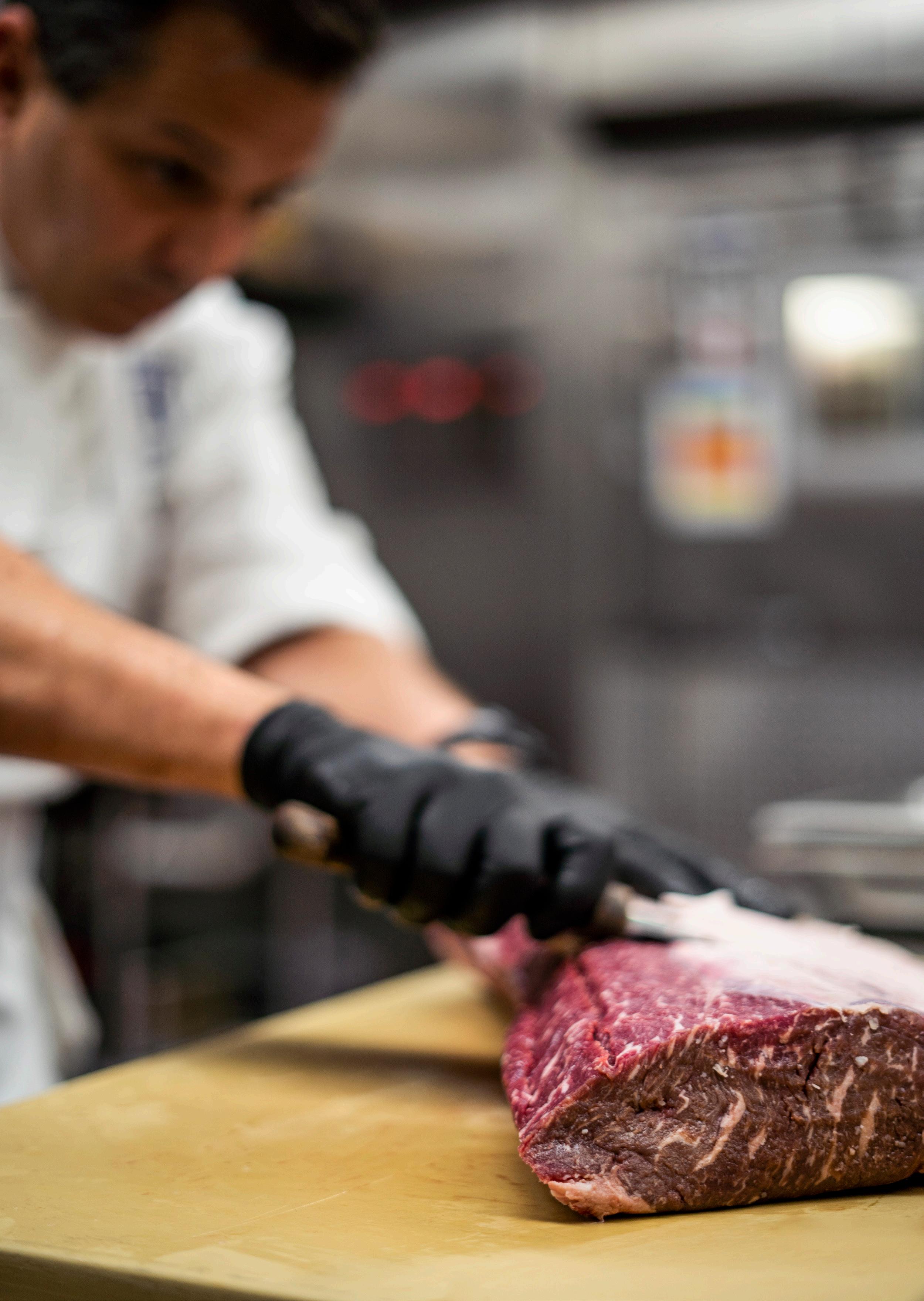 Peter Zoole prepping for his Underground Club Dinner
Image by Gideon Heller
Peter Zoole prepping for his Underground Club Dinner
Image by Gideon Heller
THE UNDERGROUND CLUB PETER ZOOLE |
EXECUTIVE CHEF
Golf Kitchen asks Chef Zoole how he creates his menu for the first exclusive, once-a-year Underground Club dinner. ~
Diana DeLucia
GK: How do you decide on a menu for your Underground dining event at Addison Reserve? Tell us about your process.
First, I determine which kitchen we will be using and what season we are in. This information assists me in establishing the number of guests and product availability, and then I can assess the number of courses I need to create and in what order they will appear.
Tasting menus need to be progressive with flavors - each course building in strength of flavors. For example, I start with cold, subtle flavors and build throughout the dinner. At this point, I have an outline, for example, light chilled shellfish, vegetable course, fish course, poultry, meat, etc. This is followed with a “brainstorm”. I do this to get the creative juices flowing. I may draw on dishes or parts of recipes that I have seen or created in the past or create entirely new dishes that I have been wanting to try.
GK: Is there typically a theme associated with the dinner?
Generally, there is no theme. Unless a member specifically requests one.
GK: Is pastry an afterthought or a part of the entire vision? Elaborate on that process.
Pastry courses are not an afterthought. I work closely with Chef Dana Ianelli for our menus to make sense. Dana is fantastic and often helps me with the brainstorming process.
GK: How much do you work with the Sommelier when creating your menu?
Once we get the menus nailed down, I share flavor details with our wine people. They then
work to pair wines with courses that they think would be the best fit. Of course, what sounds good on paper often does not work, so we do a tasting before the event.
GK: What role do the members have, if any, in the menu creation? Are they happy to be surprised?
If a tasting dinner is specifically requested by a member, then they play an important role in menu planning. I always try to get a feel of what they are looking for, including likes and dislikes.
GK: How do you source your purveyors, and are they the same or ever-changing?
My role here at Addison Reserve as Executive Chef is new. Most, if not all, of our purveyors that we work with have a long, well-established relationship.
GK: Do you think purveyors need to stay focused on quality ongoing, not just at first POS? Does it annoy you when they deliver anything outside of your original agreement? Share your advice to purveyors, if any.
Just like the saying that a Chef is only as good as the last meal he served, purveyors are only as good as their previous delivery. Customer service and consistent quality are paramount. I will let them know right away if products provided or customer service is substandard.
GK: How much preparation goes into executing a successful 9-course dinner, and what are some of the biggest challenges you face leading up to the dinner service?
Preparation is everything in order for any dinner to go smoothly. Some major challenges that we face are timing and execution. Timing for deliveries, as we want everything as fresh as possible, timing of prep, as things cannot
Addison Reserve Country Club 45
be made too far in advance. Proper execution cannot be accomplished without teamwork. I cannot possibly prepare and plate these dinners on my own. From my Sous Chefs to our cooks to our steward team, we all must work together in order to be successful.
GK: What else is essential during the smooth execution of a dinner like this?
Planning and teamwork.
GK: How do you ensure the guests enjoy each course and are not overwhelmed by the amount of food?
I carefully plan a progression of flavors that build on the previous course. Consideration definitely must be given to portion size for our members to enjoy their meals.
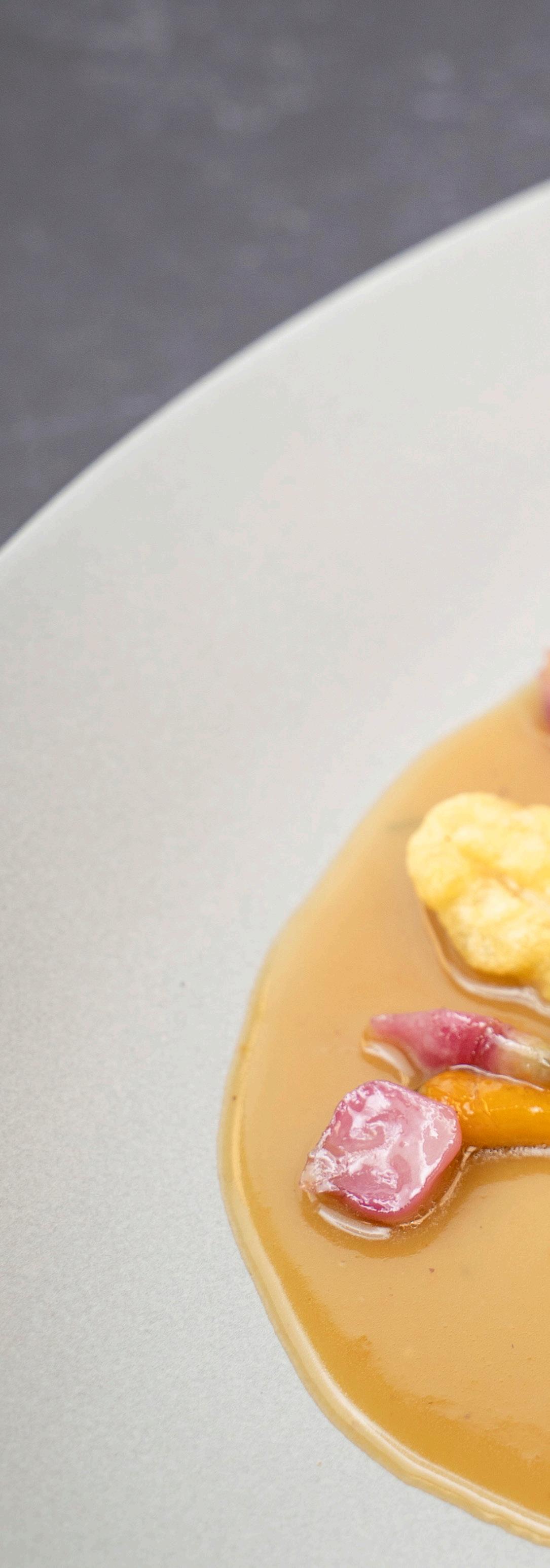
GK: Demand must be great for this unique event; how are members chosen, and how often do you offer this event each season?
We only offer our underground club event once a year. We do, however, offer Chef tasting dinners monthly during high season. For these dinners, we first take reservations and then do a “lottery” to determine our final guests.
GK: After the success of the event, what is the process of doing another?
Back to the drawing board!
GK: What were the members’ responses to this unique event?
Our members truly enjoyed this unique experience.
See pages 49 and 50 for some member experiences.
Tempura of Abalone with Glazed Micro Veggies
Image by Gideon Heller
Golf Kitchen Magazine 46
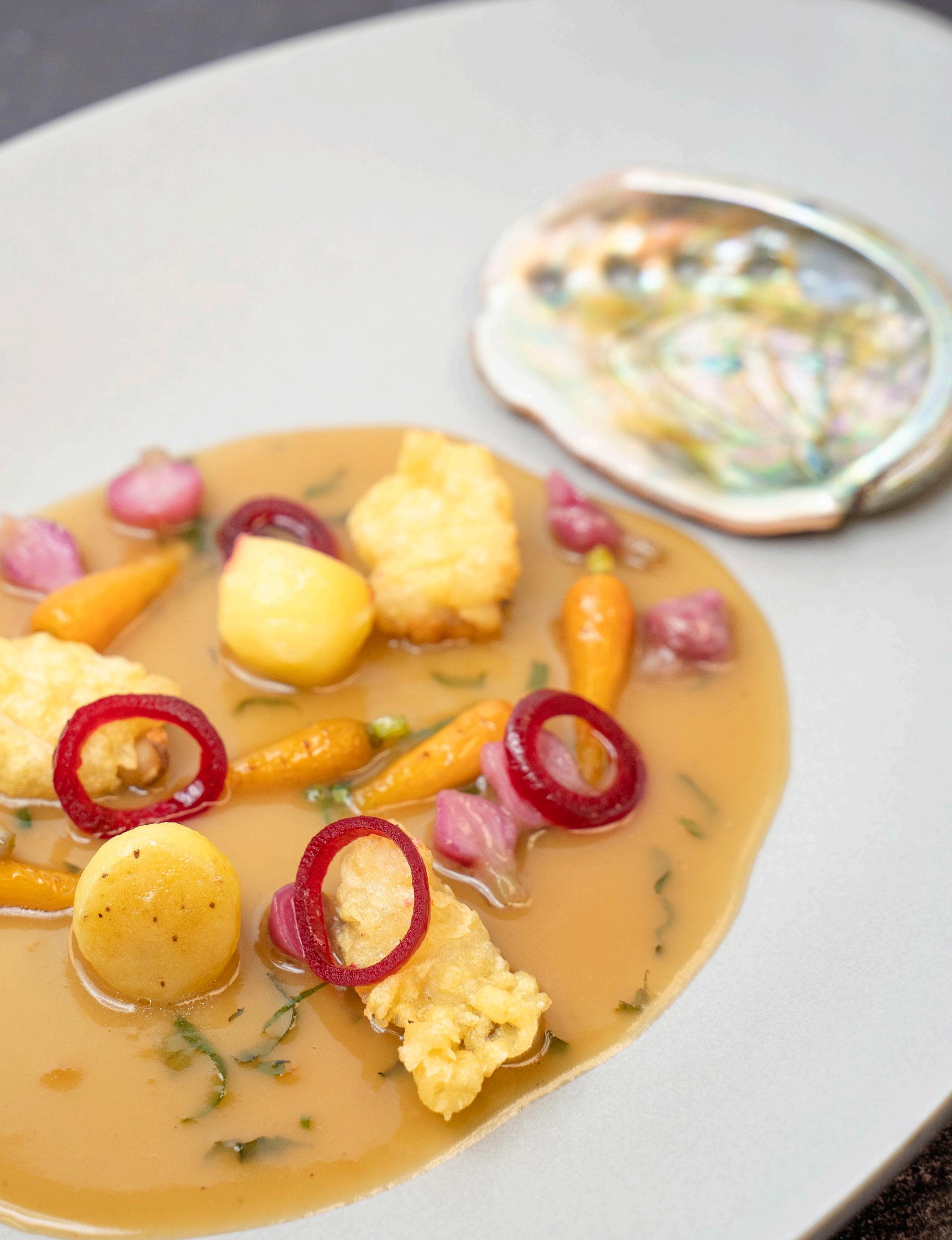
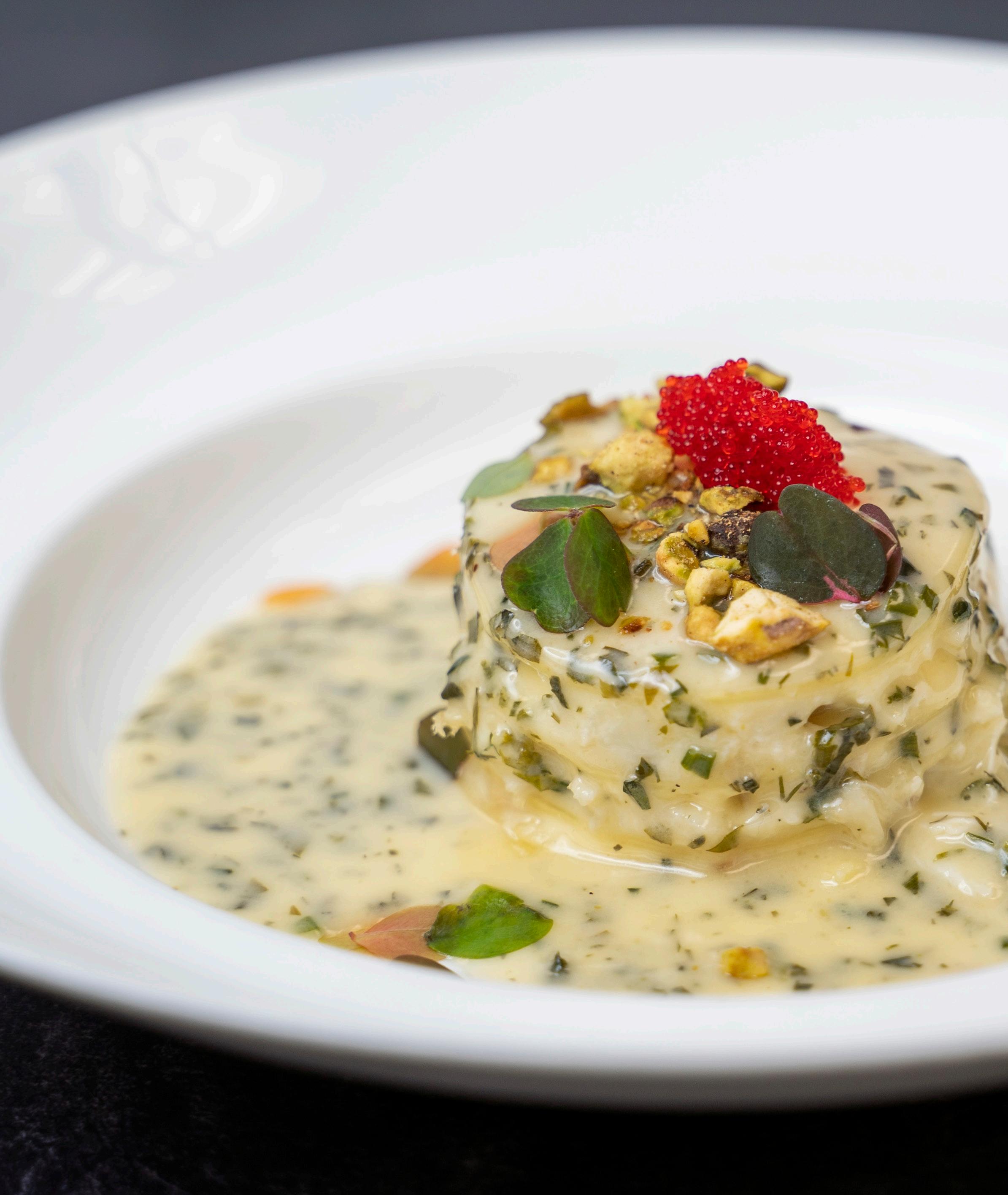 Lasagnette of Bleu Crab with Buerre Nantais and Pistachio
Image by Gideon Heller
Lasagnette of Bleu Crab with Buerre Nantais and Pistachio
Image by Gideon Heller
Member Experience
“Betsy and I had a wonderful time at the underground dinner. The description of every course by Chef Peter, Chef Dana and Katie was both informative and interesting. We were going over the menu to pick our favorite, and could not decide as each course and pairing was absolutely delicious. We are hard pressed to pick our favorite. That being said, the courses that stand out in our memory are the Foie Gras & Ahi Mosaic, the A5 Coeur et Spinalis and the Herbed Melon Beehive dessert. However, this would be unfair to the other dishes because we also loved the Uni-butter Soufflé and the Lasagnette of Crab… Each presentation was beautiful and the taste was outstanding.”
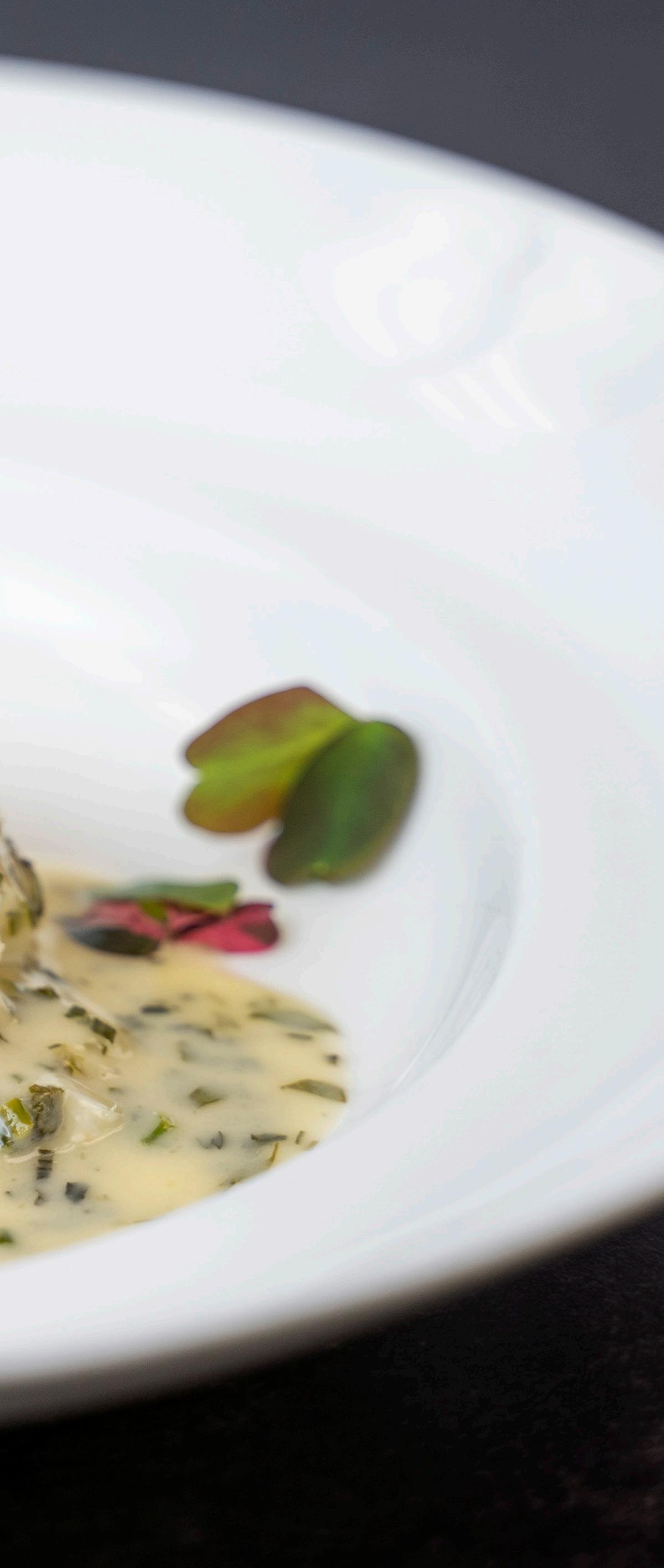 Randy and Betsy Haberman
Randy and Betsy Haberman
Addison Reserve Country Club 49
Member Experience
“Barry and I have attended several Vault dinners in the past several years and thought this experience was as good as, and in some ways even better.

We were with a really fun group of members and the staff were amazing! We loved watching the team in the kitchen put the incredible dishes together and the pride Chef Peter had in explaining each course. Katie was so knowledgeable about all the wine pairings and loved watching our reaction to each one.
It was hard to choose a favorite dish because they were all so different and special on their own. Dana totally outdid herself on two desserts. The Herbed Melon Beehive was a true work of art and delicious as well. A+ to the entire Addison Staff for fabulous service and an unforgettable evening! We cannot wait to do it again.”
Marlene Green
 Orange Dulce with Gianduja Cremeux, Bitter Orange, Passion Mango Sorbet
Image by Gideon Heller
Orange Dulce with Gianduja Cremeux, Bitter Orange, Passion Mango Sorbet
Image by Gideon Heller
 Image by Michael J. Fiedler
Fernando Silva
A Sommerlier & Artist at GlenArbor Golf Club
Image by Michael J. Fiedler
Fernando Silva
A Sommerlier & Artist at GlenArbor Golf Club

 “The Golf Swing TAngo”
by Fernando Silva
“The Golf Swing TAngo”
by Fernando Silva
Fernando Silva A Sommerlier & Artist
Fernando Silva is the Sommelier and Wine Director at GlenArbor Golf Club in Bedford Hills, New York. Silva grew up in Argentina. After working on cruise ships in the late ’90s, he decided that hospitality was going to be his lifetime career. Between the years 2003 and 2004, after some tumultuous years in Argentina, Silva left the country for Europe. He spent time in England and Spain; He worked in Brazil in bars and restaurants. During his travels, he was exposed to many different European cultures. Coming from Latin America, he was barely a social drinker, but in Europe, he discovered the many types of wines that changed his palate and sparked his interest. By the end of 2004, he immigrated to America and secured a job at BallenIsles Country Club in Palm Beach Gardens, Florida.
One evening, while working as a head waiter at BallenIsles, he was assigned to a VIP table during his dinner shift, little did he know that this table would change his destiny. Silva made a good impression on his guest Tom Lichtenstein who at the time was the General Manager at the new GlenArbor Golf Club in Bedford Hills, New York and the following day Lichtenstein asked BallenIsles if he could make Silva an offer to come and work for GlenArbor. A month later, Silva moved to Bedford Hills, New York, to join the team.
Silva attended English classes at Pleasantville University, Bedford Road, Pleasantville, New York; this helped him to progress quickly in his career. Silva is a people person and not intimidated by anyone. After about a year of working various roles at the club, the owner Mr. Grant Gregory struck up a conversation with
him, “what do you want to do with your life? How do you see yourself?” he said as he looked Silva straight in the eye. “I don’t know yet, but I need help to stay in the USA,” replied Silva. They spoke about his love of fine wines and his European travels. Mr. Gregory, impressed by Silva’s passion, stated, “I am going to sponsor you and assist with your Green Card application; I see some potential in you,” he said. Silva was ecstatic.
The road was not easy to comply with the Green Card process. Silva had to leave the USA for a year, and during this period, he traveled to Germany, he stayed in Munich and Hamburg, where he began painting professionally, and then he moved back to Buenos Aires for a few months. In 2012, the timing was right, and he returned to America and his beloved GlenArbor.
A tragic and triumphant two days.
In 2014, not long after his return, the staff quarters at GlenArbor burned down in a fire while Silva was preparing his first art exhibit in a New York Gallery; in the midst of such a stressful and near death experience, Silva made countless calls to the 911 operator and notified the other managers. He called Morgan Gregory who was the only representative of the club to arrive and assist the fire fighters.
Silva lost half of his artwork but thankfully escaped from the fire. The morning after, he received a letter from the Immigration and Naturalization Service (INS) announcing that his Green Card had been approved! It was a very emotional time, one of grief and one of celebration.
55
GlenArbor Golf Club 55
Today Fernando Silva is in his 15th year at GlenArbor, and after an exhausting and challenging course load, he has passed the certification with the Court of Master Sommeliers. It’s a rarity to find candidates for the Master Sommeliers courses and accreditations in the world of golf and country clubs. That function is usually between a food and beverage manager or through a board member who is the wine connoisseur of the group. It was gratifying both for Silva and the club.
After many years, Silva has developed a strong, family-like bond with the Gregory family, the staff, and the membership. They have come to rely on his expertise and are proud of him. He sits in on many New York Wine tastings and seminars and immerses himself completely. The wine cellars are forever changing at GlenArbor; the membership is not only golf-centric but food and wine-focused as well.
Silva works closely with Michael Ruggiero, the Executive Chef pairing menu items with his wine selections, “it’s a delicate balance,” he explains. “There are two main functions. One is entertaining, and the other is to compliment the food. I must carefully select the wine to ensure it is friendly with the menu. It can’t overpower the flavors of the food.”
During the offseason, GlenArbor allows Silva to travel to wine regions in Europe and California. This provides valuable opportunities for Silva to research and organize different wine experiences for the members. Still, he has a particular interest in French wines, of which you will find many in the GlenArbor cellars.
Each year GlenArbor hosts some of the most exclusive and prestigious culinary events in Westchester. Driven by the vision and entrepreneurial spirit of Morgan Gregory, GlenArbor’s President, Silva has the chance to showcase his flair as a sommelier: The Gary Player GlenArbor Golf Club 55 Invitational, The Golf Kitchen Culinary Excellence Awards, now in its third year, and the well-attended Traditions in Wine Excellence Awards. Well-known personalities of the wine world are honored at the event,
including Mr. Laurent Drouhin from Maison Joseph Drouhin in 2018, and Mr. Jean Charles Boisset, in 2019. Wine Enthusiast CEO Adam Strum and his wife attended the event last year.
An Artist and a Sommelier.
Silva’s passion I discovered is not just for wines, more a combination of art and wine. I was utterly fascinated by his many talents. “I consider myself an Artist and a bit of a story teller as well as an entertainer, I am very passionate about life, and I love being around people,” he explained. I asked Silva how he found his painting style. He stated, “I combine both painting and wine; I will sit in my studio with a glass of red, and suddenly I find myself consider myself an Artist and a bit of a story teller as well as an entertainer, I am very passionate about life, and I love being around people,” he explained. I asked Silva how he discovered his painting style. He stated, “I combine both painting and wine; I will sit in my studio with a glass of red, and suddenly I find myself in a trance creating a new piece of artwork. Sometimes I will throw the wine onto the canvas and mix it into the paints. It is very colorful and dramatic!”
Silva has recently begun to showcase both of his talents via social media videos on his Instagram page @artbyfersilva
For inquiries about purchasing a Fernando Silva one of a kind painting, please email: jfs0234@ gmail.com
by Diana DeLucia
Golf Kitchen Golf Kitchen Magazine 56

GlenArbor Golf Club 57
Image by Michael J. Fiedler

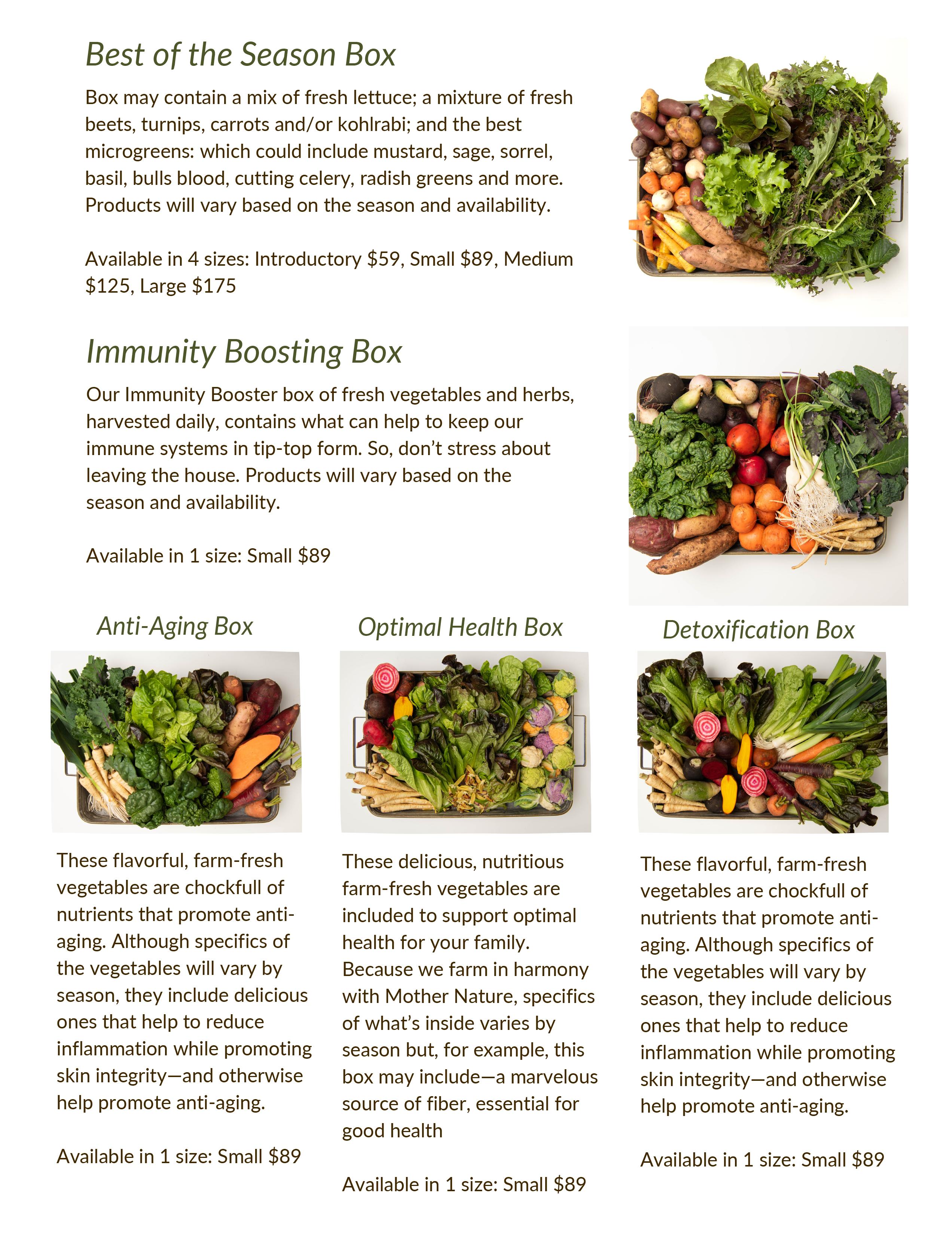
Liberty National Golf Club New Jersey
 The clubhouse from the 18th hole Image courtesy Liberty National Golf Club
The clubhouse from the 18th hole Image courtesy Liberty National Golf Club

Shaun C. Lewis Executive Chef & Assistant
General Manager
Liberty National Golf Club in New Jersey has been on my wish list to feature in Golf Kitchen projects for ten years. It’s now 2020, and the timing is right. Shaun C. Lewis has been at Liberty National for almost eleven years and holds the Executive Chef and Assistant General Manager titles. He is a dynamic chef and enjoys learning new skills with voracity. ~
Diana DeLucia
GK: Tell us when you developed a passion for cooking.
From a young age, I think we are all fascinated with fire. We are told not to go near it, not to touch it, that it is dangerous. I think it’s a very primal instinct to be drawn to it. My grandfather owned The Fireside Bar & Grill on Broadway in Newburgh, New York. I would enjoy being by his side, hanging around the bar, helping out, especially during the summers. I had to be about six or seven years old. I remember a big cast iron grill out back; the coal burning, the top lined with different meats, sausages, corn, bluefish. So, I was always fascinated by cooking. When I was younger, it was watching my relatives cook and that great experience of cooking outdoors. Coming from an entire family of great cooks that are predominantly Italian, every Sunday was somewhat celebratory. We would have multiple dining tables for extended family, and on Christmas Eve, we were cooking for about 50 people!
My first interaction with professional cooking was with pizza. It is so accessible to observe; everything is right there in front of you. In my hometown, there was a pizzeria, and I would persistently ask the owners if I could work
there. After months of pestering them, they promised that when I was tall enough to reach over the counter, they would give me a job. Soon after, the pizzeria changed hands. When the new owners arrived, I told them about the job that was promised, and they obliged. At 12 years of age, I landed my first gig at Nancy’s Pizzeria and was ready to develop my cooking skills. I excelled, and by the time I was 16, I was propositioned by other establishments in surrounding towns to work for them. I was a workhorse and had developed a skill. I had discovered the great satisfaction of caring for customers and providing exceptional service, even at that level. I worked there throughout high school and would continue during college breaks.
After high school, going into the culinary field seemed like a very natural decision. In 1988, I enrolled at the Culinary Institute of America (CIA). I was excited to learn and immerse myself in the world of cooking; this was before the beginning of the Food Network when there was no sensationalism or novelty aspect to the culinary field at all. I simply wanted to become a well trained culinary mercenary! The Culinary Institute of America taught me professionalism, discipline, leadership, and provided me with an excellent culinary foundation to build upon.
While attending, the Director of the McCann Student Center, John Campbell, asked me to work at the Pizzeria on campus. I was very familiar with the pizza business, and I quickly said yes. Whenever they called upon me to cover a shift, I would jump on it. Mr. Campbell was very appreciative of my dedication. Upon graduation, he had arranged a few Stagier positions for me at The Water Club, The River
Golf Kitchen Magazine 62
INTERVIEW
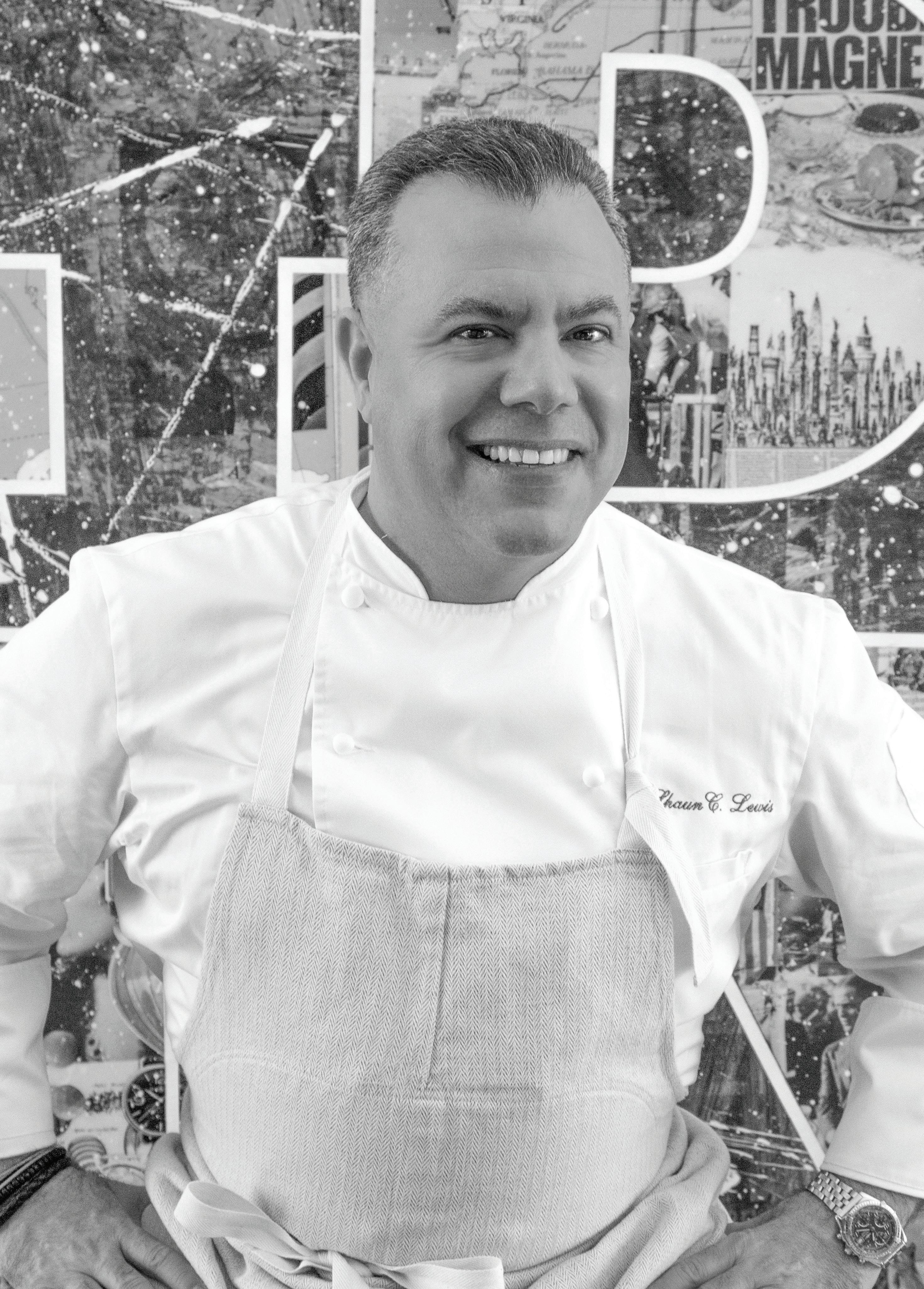


Golf Kitchen Golf Kitchen Magazine 64
The view from the 14th hole.
Image courtesy Liberty National Golf Club.
The club and skyline.
Image courtesy Liberty National Golf Club.
Café, and Aureole in New York City. During that time, a position opened up at The Pierre Hotel (where I completed my apprenticeship), and I accepted the job. I stayed there for an accumulative six years and had worked every possible culinary position in the operation. I had forged a solid foundation in classical French cuisine and the Brigade System.
My final position was Tournant, which meant I could be placed on any station at any time and execute service as better as any. This was crucial because due to union regulations, Sous Chefs could not work the line. I was ready to move forward and become Sous Chef.
I was offered quite a few positions and decided to go with Interstate Hotels on Long Island. They immediately sent me to Nantucket as Task Force Chef for the White Elephant. I loved my time there. The people, the amazing fishing, and local produce were phenomenal. I returned after a season to work on Long Island for the Winter and was then asked to task force out in Martha’s Vineyard at the Harbor View Hotel. I think I said yes before the GM completed his sentence! I love the Cape and Martha’s Vineyard, which was just as unique as Nantucket. A year later, I was asked to return as the Executive Chef at The Inn at Great Neck, and I stayed there for about two years.
I had my heart set on opening a restaurant, nothing pretentious, just great solid American food with a focus on local ingredients. I opened Mae Browne’s in Huntington, New York, and we were focused on creating the highest quality dining experience. We were reviewed within a few days and received two stars from the NY Times. While most were very pleased with this, I wasn’t motivated by stars or accolades; I was focused on great food and excellent service every day. My philosophy is still the same today.
I was offered a share of Mae Browne’s, but I politely declined. I was starting a family and knew that my time to explore other options were running short. I mulled over opening my own restaurant, but then my father in law said to me, “There’s a chef that wants to meet you.” I was introduced to Nino Procacci, who was a retired Executive Chef from Old Westbury Golf and Country Club in Old Westbury, New York. Chef Nino took me to meet Chefs Nicholas
Carlone and Peter Fischl. I had preconceived ideas of what club cuisine would be like, but it turned out to be nothing like what I expected. I was hooked. Together with Martel Meyer, we created a new standard in Club cuisine and private events.
At Old Westbury, we embraced traditional club cuisine, although we did push boundaries, and the food scene was evolving very quickly. I got to interact with the members a lot, and I enjoyed forging those relationships through hospitality. I had a captive audience and was shooting for an outstanding performance every day. Old Westbury was very special to me in many ways.
After about four years, I was offered the Executive Chef position at Woodcrest Golf Club in Syosset, New York, a very charming-family oriented club that was looking to update its food and beverage program. I loved the challenge and the members. Sous Vide and Molecular Gastronomy were on the forefront of modern cooking and was poorly criticized by established and well-respected chefs. I knew that I needed to form my own opinion and began to focus on these techniques. Soon I was taking courses at the French Culinary Institute with David Arnold and with Alexander Talbot of Ideas in Food. Learning and growing at an accelerated rate, I needed an outlet for this type of cooking and began staging again.
GK: How did you end up at Liberty National?
I received a call from Martel Meyer (Old Westbury). Martel had accepted the GM position at Liberty National Golf Club a year earlier. Martel said, “We just opened the new clubhouse, and I need you to come and see it.” I had just declined an opportunity in New Jersey and was apprehensive to consider another. I had told Martel that I was not looking to relocate. “Just come over to visit, that’s all I’m asking you to do.”
On a stormy spring day in 2009, I took the ride out from Long Island. I distinctly remember an 18 wheeler clipped my trucks side view mirror. “Welcome to New Jersey!” I thought to myself. I pulled into Liberty National, and in the dense fog and chilly rain stood this modern steel and glass clubhouse. Peering through the mist in the distance, stood Lady Liberty. Even on a dreary,
Liberty National Golf Club 65
grey day, this place was stunning. I fell in love with the club, what it represented, what it meant for golf, and private clubs, and the potential history we could create here.

There were very high expectations and within 48 hours, I had CBS interviewing me in the kitchen on what it’s like to work at Liberty. I had not even touched a knife yet! My first interaction with food and staff is caught in the video “Lady Liberty Awaits”.
In the first month, we catered Paul and Phyllis Fireman’s Anniversary Celebration and two months later, The Barclays tournament. I had my dream position and culinary freedom. This suited me well as I enjoy creativity and surround myself with talented-creative types. Getting to know our members and collaborating with them on menu ideas is the true evolution of a club’s cuisine.
GK: You had the PGA Tour event rather early in the club’s establishment, tell us about that experience.
I had to change all the menus for the PGA Tour event as they simply weren’t mine. Our Club membership was probably about 60 members
but we were gearing up to cater for about 2,000 covers a day in three different locations on the property. We had two satellite kitchens, and it was unlike anything I’ve ever done. I had a great team and still do! Due to the success of the tournament, we did three more after that, 2013 Barclays, 2017 Presidents Cup, and 2019 The Northern Trust event.
GK: Tell us about your relationship with the members.
The relationship I have with our membership is a very special. Lady Liberty may have enticed me to come here, but it is the Liberty membership that keeps me going. After 11 years, I feel blessed to have forged such great friendships and see families grow.
When I arrived in 2009, we were doing tasting menus and Michelin Star geared cuisine. It was all over the top and exciting, and we were creating the culture. One thing I’ve said consistently over the years is that my cuisine is a reflection of the member’s desire.
GK: Do any celebrities frequent here?
We get a lot of celebrities, politicians and
Golf Kitchen Magazine 66
The view of One World Trade Center. Image courtesy Liberty National Golf Club.
sports figures here and some are members. My philosophy, however, is every one that walks through Liberty’s doors is a celebrity. They are all treated the same. When we do have someone that is “celebrity” in the dining room, my focus is on the other members and my staff. I want to ensure all members receive the same level of attention and service as anyone else.
One story I will share is when Martel Meyer said to me the night before, “Alice Cooper’s coming in tomorrow. Alice’s agent is a food guy, do you think you could talk to him?” I said, “Sure, my pleasure.” The next day I came into work, and I had recently returned from Alinea in Chicago, where I staged with my sous chef. One of my inspirations from there was the Truffle Explosion.
Alice Cooper and Shep Gordon, who is Alice’s manager, were in the dining room and had already ordered turkey burgers. I had offered them my truffle explosions. I set them on the table and explained what I had created. Alice says, “you have to talk to Shep. He is a big food guy”. I had a conversation with Shep about food and chefs, and I could tell how knowledgeable he was, he knew who Frédy Girardet was. Most cooks have never heard of him; I was impressed.
After learning about Shep’s incredible career, I said to him, “You’re probably the one person that I could thank for elevating my craft. By launching many culinary careers and the Food Network, many of us have better work conditions better pay, and we are celebrated. Shep said to me, “You know that Turkey burger that you made us? You will be making that your entire life. I thought to myself, “God, help me. Where are you going with this Shep?” He explains, this is the best turkey burger he’s ever had. You make it in house, cook it sous vide. It is amazing!” He said, “You can make your Truffle Explosions and all of your different special things, but you will always need to play your hits. That Turkey Burger is a hit! When Alice puts on a concert, he could sing with Johnny Depp and the Hollywood Vampires, or sing a new song, but he still has to play his hits. Chefs are no different. You put on your uniform, and you go out and perform your hits. I didn’t do anything but shine a light on chefs. I am proud to have done that.”
If you are a chef and haven’t seen the documentary Supernmensch, flog yourself, then rent it on Netflix.
GK: Tell us about your cocktail program?
In 2007 I was at the French Culinary Institute studying sous vide and learning modern cooking techniques with Dave Arnold. We were applying a lot of these techniques to spirits and cocktails as well as food. These were all applications to enhance a cocktail program, however, the Long Island Country Club scene wasn’t ready for it yet. Once I arrived at Liberty National, I knew I would be able to showcase these techniques and build upon them. Over the years, I have been gradually enhancing our cocktail menu. In the Summer of 2013, I was hosting a Celebrity Golf event and took notice
of celebrated mixologists Tony Abou-Ganim and Charlotte Voisey. I was so impressed by the attention to detail in their work and focus on fresh ingredients. It inspired me to dedicate more time and energy to the world of spirits. The craft of Mixology became of great interest to me. Balancing time between my passions has always been the greatest challenge for me.
It’s not uncommon to see me behind the bar experimenting with my techniques and at the same time, studying wine and seeking my Sommelier Certification through the Court of Master Sommeliers. Flavors, textures, service; my vortex is spinning….
Behind the bar is the ultimate open kitchen. The guest gets to watch you prepare their cocktail from start to finish, and you get to experience their reaction, up real close. It is intimate and very telling.
In 2019 I was asked by the PGA Tour to create
Liberty National Golf Club 67
“Balancing time between my passions has always been the greatest challenge for me.”

Golf Kitchen Magazine 68
Katrina Krynicki, Bartender at Liberty National Golf Club holds the “Feathered Indians” cocktail.
Image by Shaun C. Lewis

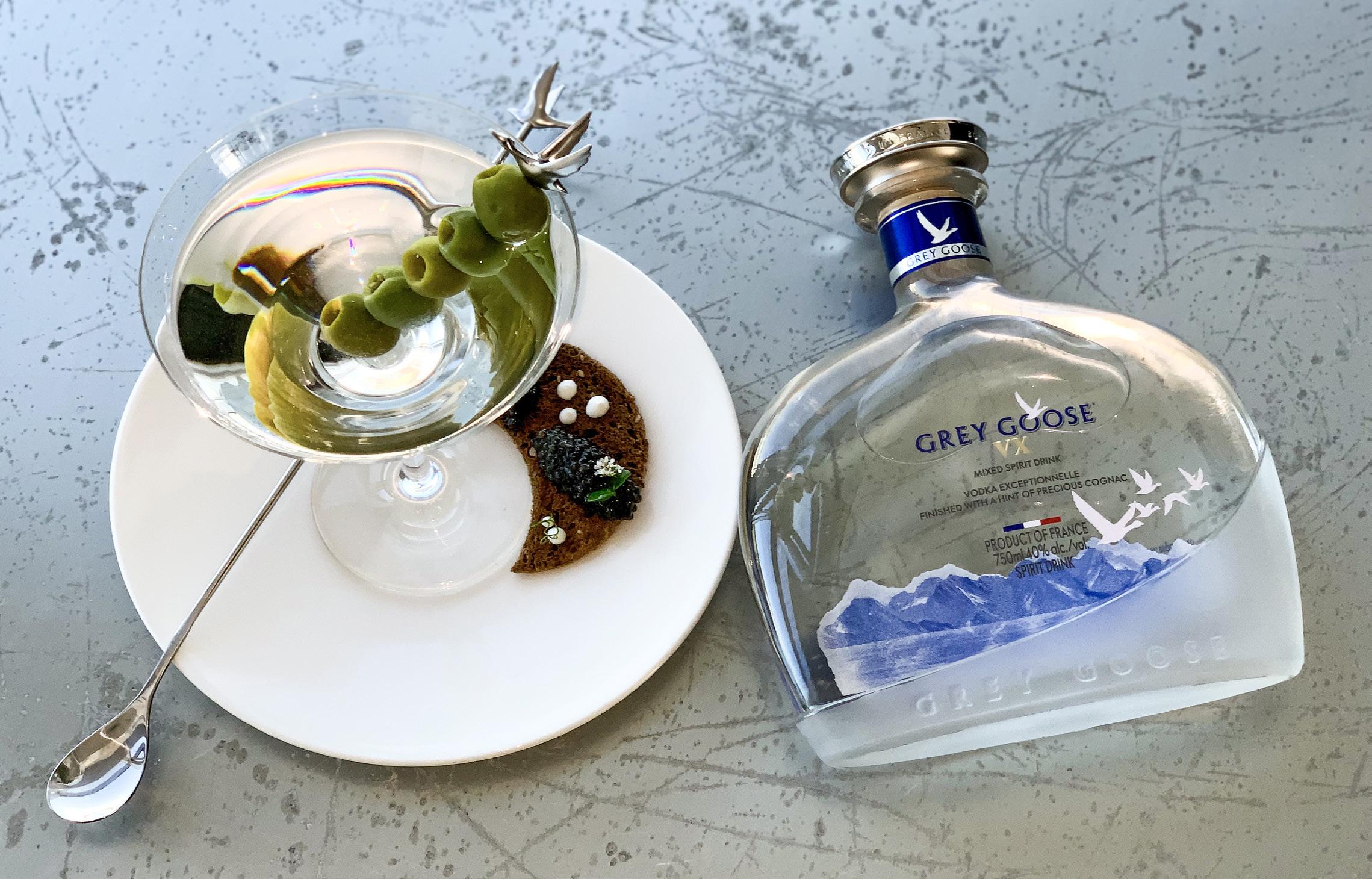 Harvest Moon
Image by Shaun C. Lewis
Grey Goose VX Martini
Image by Shaun C. Lewis
Harvest Moon
Image by Shaun C. Lewis
Grey Goose VX Martini
Image by Shaun C. Lewis
a luxe - VIP experience for the Liberty Club at The Northern Trust. My response was Chef & Chic. I created this culinary and cocktail experience that paired food and cocktails together beautifully, and it played out right in front of our guests in an outdoor bar setting. Chef & Chic has since grown, and my focus is on charitable events. I am currently working on a curriculum for Modern Mixology, which will demonstrate a lot of these techniques in tandem with talented Mixologists.
GK: You mentioned charitable events, which are you involved with?
I am very proud to serve on the Board at the Liberty Humane Society in Jersey City. This is a fantastic community, and its growing so quickly. It’s very gratifying to serve such beautiful pets and their people!
always approached operations from an environmentally conscious standpoint. We use compostable take out containers, recycling, and the use of fabric bags instead of plastic. More recently, I started beekeeping at Liberty for pollination and population reasons. Hopefully, we will harvest honey this year. We are also looking into composting onsite.
GK: Paul Fireman stated that Liberty Nationals’ great expense was treating the site it was built on. How do you approach the focus on being “green-friendly”?
The history of Liberty’s property is quite unique. Paul Fireman had the foresight to purchase land that nobody wanted and had the resources to properly treat the land so it would be viable for generations to come. It has made such an impact on this community and the world of golf.
Since opening the clubhouse in 2009, we have
Golf Kitchen Magazine 70
“Behind the bar is the ultimate open kitchen. The guest gets to watch you prepare their cocktail from start to finish, and you get to experience their reaction, up real close. It is intimate and very telling.”
 The outdoor terrace.
Image courtesy Liberty National Golf Club
The outdoor terrace.
Image courtesy Liberty National Golf Club

Golf Kitchen Magazine 72
RECIPE BY SHAUN C. LEWIS
TRUFFLE MACARON
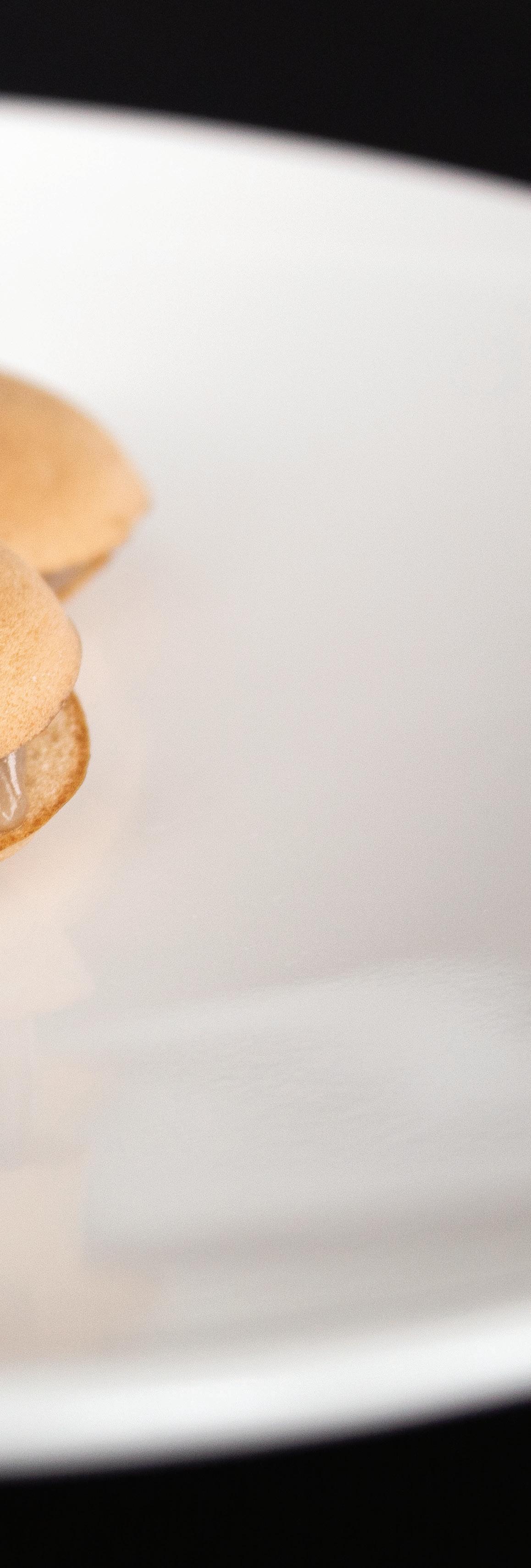
Serves 1
Ingredients
• 390 milliliters Truffle Stock
• 7 grams Methocel F50
• 3 grams Xantham Gum
• Salt and Pepper (to taste)
Chef Note: METHOCEL™ F50 is a water-soluble polymer derived from cellulose. Methocel is a high purity, non-ionic cellulose ether, and performs as a rheology modifier, further it functions as a suspending aid, stabilizer, surfactants, lubricants, protective colloids, and emulsifiers.
Truffle “Ganache
• 350 milliliters Truffle Stock
• 10 drops Truffle Aroma
• 8 grams Gellan Gum
• Salt and Pepper (to taste)
Preparation
Season your truffle stock to taste.
In a blender, shear in Methocel F50 and allow to hydrate overnight. Put the mixture into a table top blender and whip in the xantham gum. Continue to whip until it forms moderately stiff peaks.
Transfer to a pastry bag fitted with a round tip and form macarons on a dehydrator sheet.
Dehydrate at 54.5°C for eight hours.
Truffle “Ganache”
Season the truffle stock and in a blender shear in the Gellan Gum. Transfer to a saucepot and bring to a simmer while stirring continuously, allow to simmer for one minute. Transfer to a container.
Allow to cool and set.
Transfer to a blender and purée, adjusting consistency and seasoning.
Assembly
Place the truffle ganache in a pastry bag with a round tip and pipe in between one macaron and top with another macaron.
Serve immediately.
Liberty National Golf Club 73
 RECIPE BY SHAUN C. LEWIS
RECIPE BY SHAUN C. LEWIS
55* KOBE FILET of BEEF with Rainbow Chard, Sweet Potato Gnocchi & Romanesco Cauliflower
Serves 2
Ingredients
Beef
• Two 9 ounce portions of center cut Kobe Filet
• 2 ounces Garlic and Thyme infused Olive Oil
Sweet potato Gnocchi
• 2 medium Sweet Potatoes
• 2 cups All Purpose Flour
• 1 Egg

• 1 Egg Yolk
• 1 cup Pecorino Romano
• Fresh Nutmeg
• Salt and Pepper to taste)
Cauliflower
• 4 heads Baby Romanesco Cauliflower
• 6 cloves Garlic
• 1 cup Chicken Stock
• 4 sprigs Thyme
Swiss Chard
• 1 bunch Rainbow Chard (cleaned)
• 1 Shallot (minced)
• 1 clove Garlic (smashed)
• 1 Tablespoon Butter
• 1 teaspoon Olive Oil
Liberty National Golf Club 75
Preparation

Beef
Cryovac the filets with olive oil and cook at 55°C in a water circulator for 2 1/2 hours.
Chill in icewater for one hour and refrigerate overnight.
Sweet Potato Gnocchi
Bake the sweet potatoes for 45 minutes and immediately scoop out the flesh and purée in a food processor. Season the purée with salt and wrap in cheese cloth and hold in a strainer overnight.
The following day let the purée come to room temperature and mix in the eggs, cheese, nutmeg and pepper. Slowly add the flour until a tacky, but not wet dough forms.
Roll out dough into 1/2 inch cylindrical logs and cut into 0.33 inch pieces.
Roll the pieces off of a floured fork to create a gnocchi and place on sheet pan with parchment paper to freeze overnight.
Cauliflower
Trim and cut the cauliflower to the desired shape.
Separately, roast the garlic and the thyme.
Simmer the chicken stock for about 20 minutes and add the roasted garlic and thyme.
Chill the stock together with cauliflower in the Cryovac. Cook at 82.5°C for 25 minutes.
Chill in icewater for 45 minutes and reserve.
Swiss-chard
Sweat the shallots and garlic in olive oil until translucent then add the Swiss chard.
Toss and sauté until tender, add the butter and season with salt and pepper.
Assembly
Retherm the beef and cauliflower and perspective water baths at the temperature they were cooked. Meanwhile, poach the gnocchi in simmering salted water. When done strain and the toss with extra-virgin olive oil and adjust the seasoning.
Remove the beef from the Cryovac and season liberally with salt and cracked pepper.
Sear the meat on both sides in cast iron skillet, then let rest for three minutes, then slice horizontally in half.
Remove the cauliflower from the Cryovac and allow the liquid to drain off.
Assemble a plate with Swiss chard directly under the beef and finish with bordelaise sauce, citrus Coriander blooms, tahoon cress and Maldon sea salt.
Golf Kitchen Magazine 76
 The City View Terrace (CVT) Image courtesy Liberty National Golf Club
The City View Terrace (CVT) Image courtesy Liberty National Golf Club
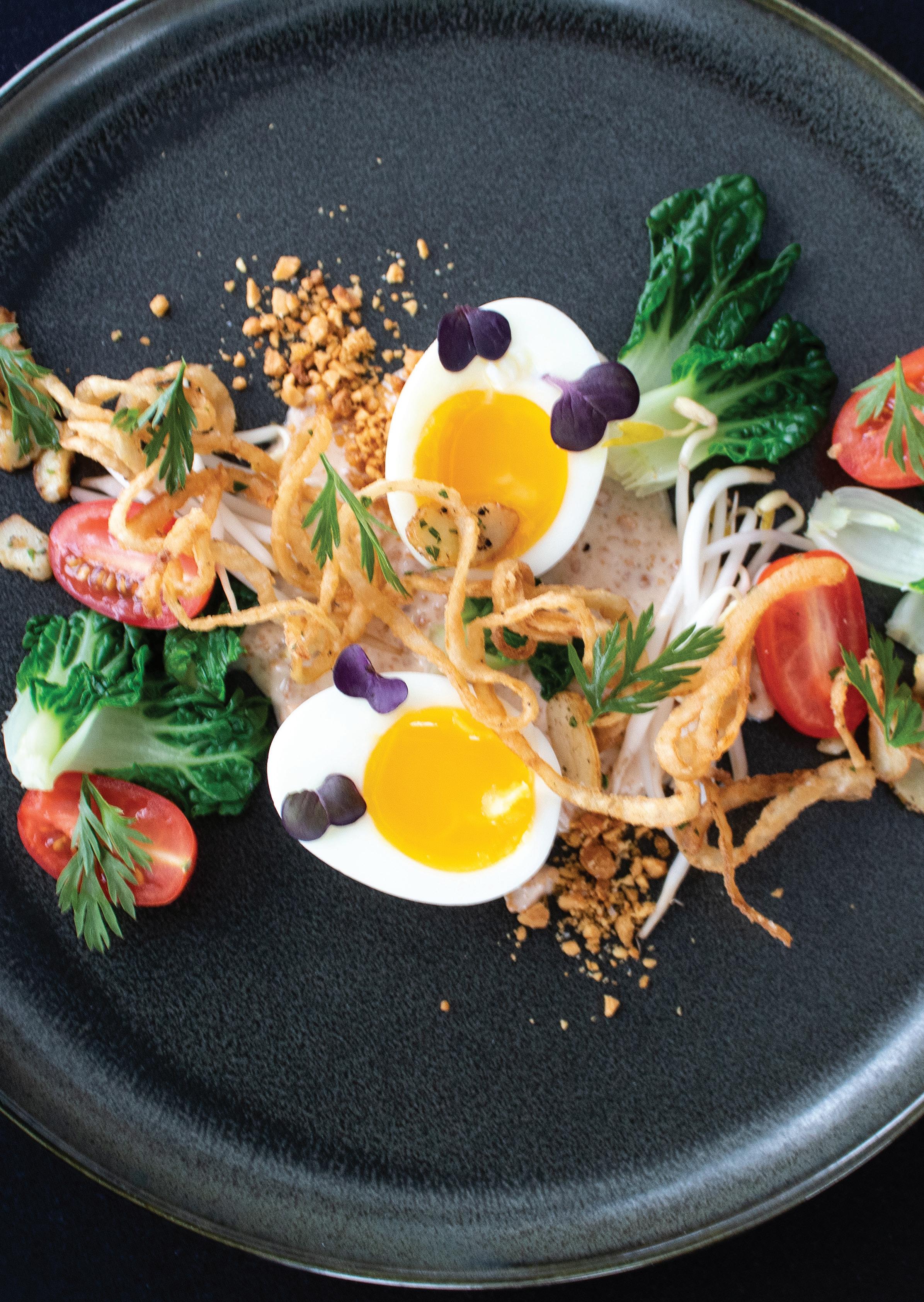 RECIPE BY SHAUN C. LEWIS
RECIPE BY SHAUN C. LEWIS
PETJIL
Serves 1
Ingredients
• 1 Egg (soft boiled)
• 1 head of Baby Bok Choy (blanched)
• 2 Cherry Tomatoes (cut in half)
• 2 ounces Bean Sprout (lightly blanched)
• 1 Shallot (crispy fried)
• 3 leaves Cilantro
• Peanut Sauce (see recipe)
Peanut Sauce
• 2 cups Peanuts (skinless)
• 3 cloves garlic, peeled
• 2 Birds Eye Chili (seeded - for spicier sauce leave the seeds)
• 1/2 inch Ginger (peeled)
• 1 teaspoon Tamarind Paste
• 1/2 Lime (juiced)
• 2 Tablespoons Palm Sugar (or brown sugar)
• 1 teaspoon Salt
• 3/4 cup Water
• 1/4 cup Coconut Milk
Garnish
• Micro Cilantro
• Roasted Peanuts (chopped)
Preparation
Peanut Sauce
Roast the peanuts in an oven, or saute on a stove top. Set aside to cool.
Saute the garlic, chili and ginger until lightly brown and then blend in a food processor. Add the peanuts and pulse leaving some peanuts pieces intact.
Add the tamarind paste, lime juice, palm sugar, salt and pulse lightly again.
Put 3/4 of the peanut mixture into a pot with the rest of the ingredients and cook until thick.
Assembly
Spread a thin layer of the peanut sauce along the bottom of the plate. Start building your salad with the bok choy and cilantro leaves and dollop more peanut sauce between the layers. Lightly season the greens and vegetables as you go.

Place the tomatoes on top followed by the crispy shallots. Top with the beans sprouts and soft poached egg.
Garnish with micro cilantro and chopped toasted peanuts.
Liberty National Golf Club 79

 The main dining room.
Image courtesy of Liberty National Golf Club.
The main dining room.
Image courtesy of Liberty National Golf Club.
 RECIPE BY SHAUN C. LEWIS
RECIPE BY SHAUN C. LEWIS
FLAVORS OF PINK COCONUT
Serves 4
Ingredients
Coconut Foam
• 750 mlliliters Coconut Milk
• 250 milliliters Coconut Water
• 12 sheets Gelatin
• I Tablespoon Glucose
Coconut Gel
• 1 liter Coconut Water
• 12 sheets Gelatin
Lemongrass and Coconut Sorbet
• 26 ounces High Fat Coconut Milk
• 4 stalks Lemongrass (sliced)
• 6 Kaffir Lime Leaves
• 2 ounces Ginger (peeled and sliced)
• 8 ounces Coconut Water
• 4 ounces Sugar
• 2 Tablespoons Glucose
Coconut Lime Tart
• 2-1/2 cups Oats
• 3 Tablespoons +1/2 cup Sugar

• 4 Tablespoons Butter
• 14 ounces High Fat Coconut Milk
• 2 Tablespoons Glucose
• 3/4 cup Lime Juice
• 4 Egg Yolks
Preparation
Coconut Foam
Bloom the gelatin in ice water while bringing the coconut milk, coconut water and glucose to a simmer. Squeeze the water from gelatin and add to mixture. Remove and chill slightly.
Pour into ISI containervand add two gas cartridges and chill overnight.
Liberty National Golf Club 83
Coconut Gel
Method bloom the gelatin in ice water while bringing the coconut water to a simmer. Squeeze water from gelatin and add to coconut water. Pour mixture over an acetate sheet in a sheet pan creating a 1/16 inch layer. Chill until solidified and cut desired shapes.
Lemongrass and Coconut Sorbet
Combine the lemongrass, lime leaf, ginger and coconut water in a sauce pot bringing to a boil for two minutes.
Add the sugar and glucose then remove from the heat to cool.
Combine with the coconut milk and put into a Pacojet container and freeze overnight.
Coconut Lime Tart
Pulverize the oats in a food processor and add the 3 Tablespoons of sugar and 4 Tablespoons of melted butter.
Line a greased baking dish with aluminum foil and press the oats inside. Bake for 10 minutes at 350°F.
Remove and cool.
Assembly
Please coconut lime tart on a plate. Place coconut gel circles on the plate in a sporadic pattern. Pipe coconut gel dollops throughout circles.
Dispense coconut form into liquid nitrogen and freeze thoroughly.
While freezing, place a quennel of coconut sorbet a top additional oat crumb that has been toasted.
Remove coconut foam from nitrogen and crack into smaller pieces and arrange on plate.
Golf Kitchen Magazine 84
Khayyan’s collection of wine vinegars are aged and categorized under Crianza, Reserva and Grand Reserva, and are produced from high quality Palomino, Tempranillo, Fino, Oloroso, Moscatel and Pedro Ximenez grapes aged in American Oak barrels in Jerez and Cordoba, Spain. These unique flavors have quickly become a staple ingredient in the kitchens of some of the country's top chefs.

RAISING THE BAR
 by Natalia Fedra Cabrera MerCader
by Natalia Fedra Cabrera MerCader


RAISING THE BAR
Wine vinegar, the least regarded and unappreciated derivative of exquisite table wines is taking the lead in a series of dishes and coming to the front of top bars. Once considered bad wine it is shining as a culinary condiment on its own. Considered the poor man’s juice it is now considered rich, robust and flavorful used in culinary programs and mixologist themed drinks.
Vinegar is essential to brighten the flavor of dishes or used as a base for a sweet-tart salad dressing. As vinegar can give meals that delicious acidity and flare, did you know that it can also provide bar drinks a distinct personality?
Vinegar and alcohol may seem like an unlikely pair; however, mixing the two dates back hundreds of years. Derived from the Arabic word sharab which means “to drink,” shrubs are cocktails made by mixing vinegar syrup with spirits or carbonated water. But while shrubs have been around for hundreds of years, it was only in the last decade that they started trending in bars in North America and Europe. The acidity of vinegar makes a great alternative to bitters in cocktails.
Shrubs also refer to the sweetened vinegar-based syrup used in the cocktails. And in many cases, shrubs are merely known as “drinking vinegars.” Shrub syrups are created by reducing fruit, sugar (or honey), vinegar, and water usually as 1 : 1 : 1 : 1 : 1 ratio and slightly reduce under moderate heat. Once cooked and reduced strain and you have a tangy, fruity syrup that’s perfect for mixing with carbonated water, tonic, and or gin, vodka.
No two vinegars are the same, and even within types, flavors will vary wildly. Vinegars, like citrus, are the acidic counterpart to a base of oils and fats. Their tart pungency acts as a foil to the heavier notes to create a balanced complexity of flavor. The acid will deliver an overall freshness that elevates flavors.
Shrub Recipes You Will Love.
Here are some great shrub recipes you can try at home. Add them to gin or vodka for a fun alcoholic drink. They’re surprisingly easy to make, and you only need 1 oz of shrub syrup to bring a tang to your drink! But if you want a fruity yet tart mocktail instead, add these shrub syrups to a glass filled with ice and club soda. Children find these non alcoholic healthy alternative drinks fun as well.
Blueberry Balsamic Shrub
• 1 cup 50 Year Balsamic Pedro Ximenez Wine Vinegar
• 2 cups Blueberries
• 1 cup Cane Sugar
• 1/4 cup Mint Leaves
• 1 cup Water
Mix the berries and sugar thoroughly in a large bowl with 1 cup of water bring to a simmer. Add mint and 50 Year Balsamic Pedro Ximenez Wine Vinegar let it cool strain into a glass jar. Refrigerate and serve.

Cherry White Balsamic Shrub

• 1 cup Fino 12 Year Aged White Balsamic
• 2 cups pitted and halved Sweet Cherries
• 1 Vanilla Bean, split and seeds scraped
• 1/2 cup Cane Sugar
• 1 cup Water
Mash up the cherries and sugar to create a lumpy paste add water and bring to a simmer. Stir in Fino 12 Year Aged White Balsamic Vinegar, add vanilla bean and cover the mixture and let it steep in the fridge once cool for at least one day. When ready to use, strain the syrup into a jar.
GROWING A FRESHER FUTURE
Elevate your culinary experience with the Flex Farm. Grow more than 20 pounds of fresh, leafy greens in less than a month.
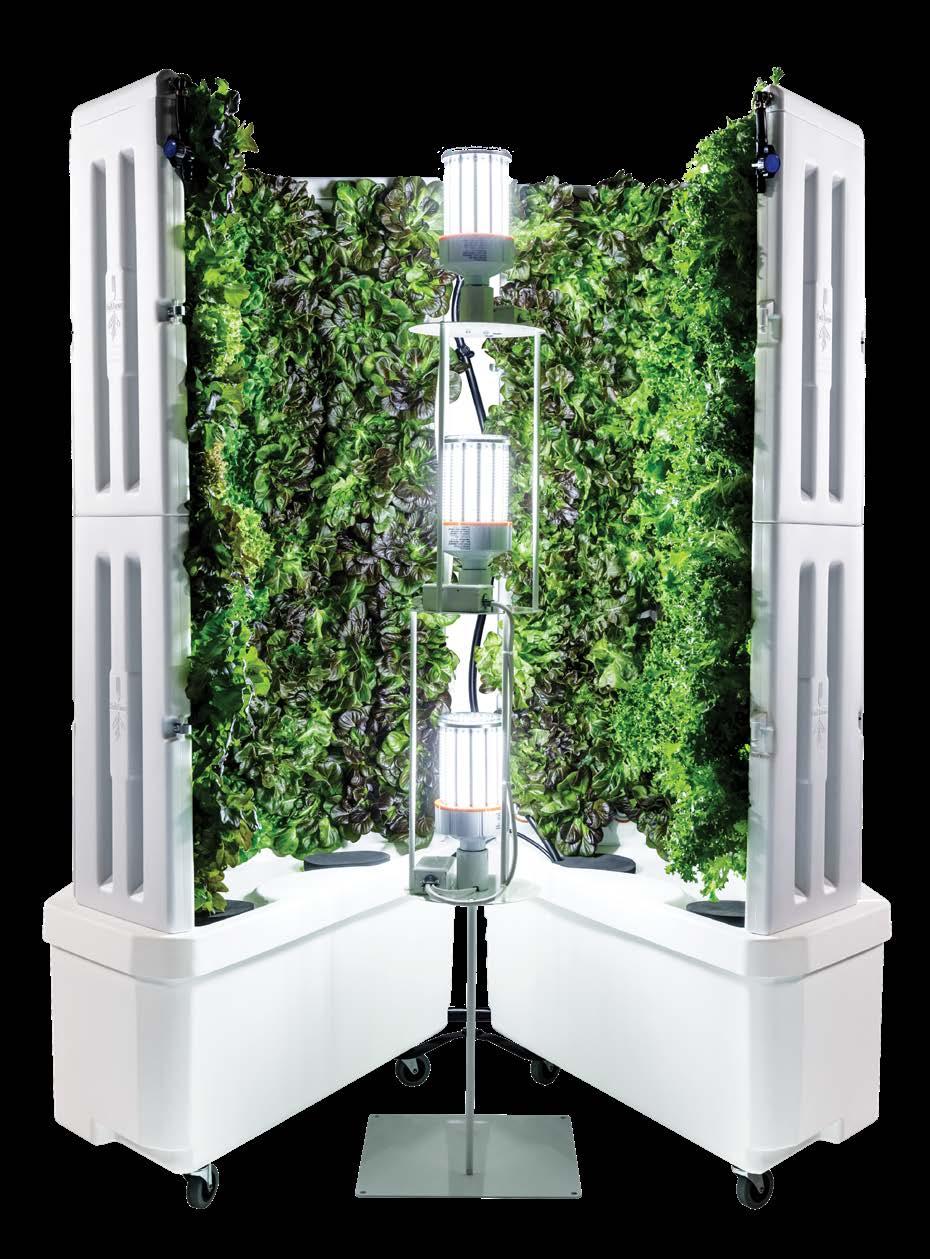
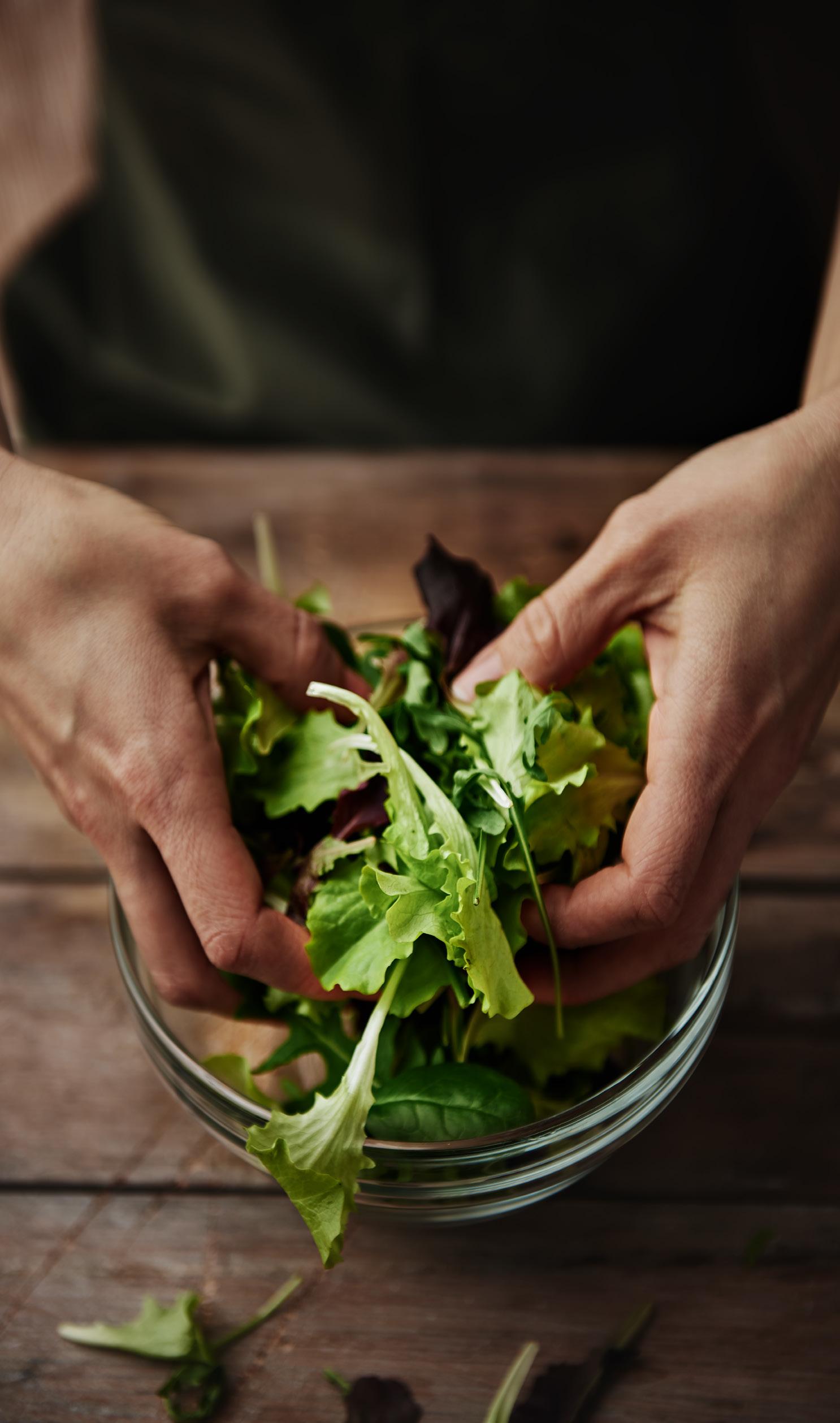
Scalable. Sustainable. Local.

Flex Farm technology is deployable at both small and large-scale and everything in between. It positively impacts neighborhoods, businesses and supply chains in a big way.
Within 2 weeks, the Flex Farm can be on location. Not only is it easy to assemble, but it is also 40% more energy-efficient than all of its competitors and manufactured right here in the USA.
Contact us today to learn more!
info@forkfarms.com 877.886.7736 www.forkfarms.com 101 W Edison Ave, Suite 224 Appleton, WI 54915
Rhubarb Aged Moscatel Shrub

• 6 ounces 15 Year Moscatel Wine Vinegar
• 1 pound Rhubarb
• 3/4 cup Sugar
• 1/2 cup chopped Fresh Basil
• 1 cup ater
Make a syrup by combining the sweet ingredient with water in a saucepan over low heat until the sugar is dissolved. Add the fruit and bring the mixture to a low simmer. Let it cook until the syrup has become the color of the fruit, and the fruit looks very soft and cooked down. Stir in the 15 Year Moscatel Wine Vinegar and bring the mixture just to a simmer again. Strain the mixture into a jar, let cool and keep it in the refrigerator.
Simple and Ready to Serve
To serve, fill a tall glass with ice, pour a splash of the shrub and top it with seltzer water or a shot of alcohol – gin, whiskey or vodka.
Experiment and Make Your Shrubs
Shrubs are made with fresh fruit, vinegar, sugar, water and leafy spices thus allowing freedom to experiment with your favorite fruits and vinegar that are probably already in your kitchen. When it comes to fruit, it’s best to stick with whatever is sweet, ripe and in season.
There are also no strict rules when it comes to what type of vinegar to use; however, you should look for something that has an acidity level of no less than 5%; otherwise the flavor will be weak. You will find that white vinegar has a sharp taste while apple cider vinegar is fruitier and milder. Balsamic vinegar pairs nicely with berries while wine vinegar such as a Moscatel is a bit more superior in character with a bold oak flavor.
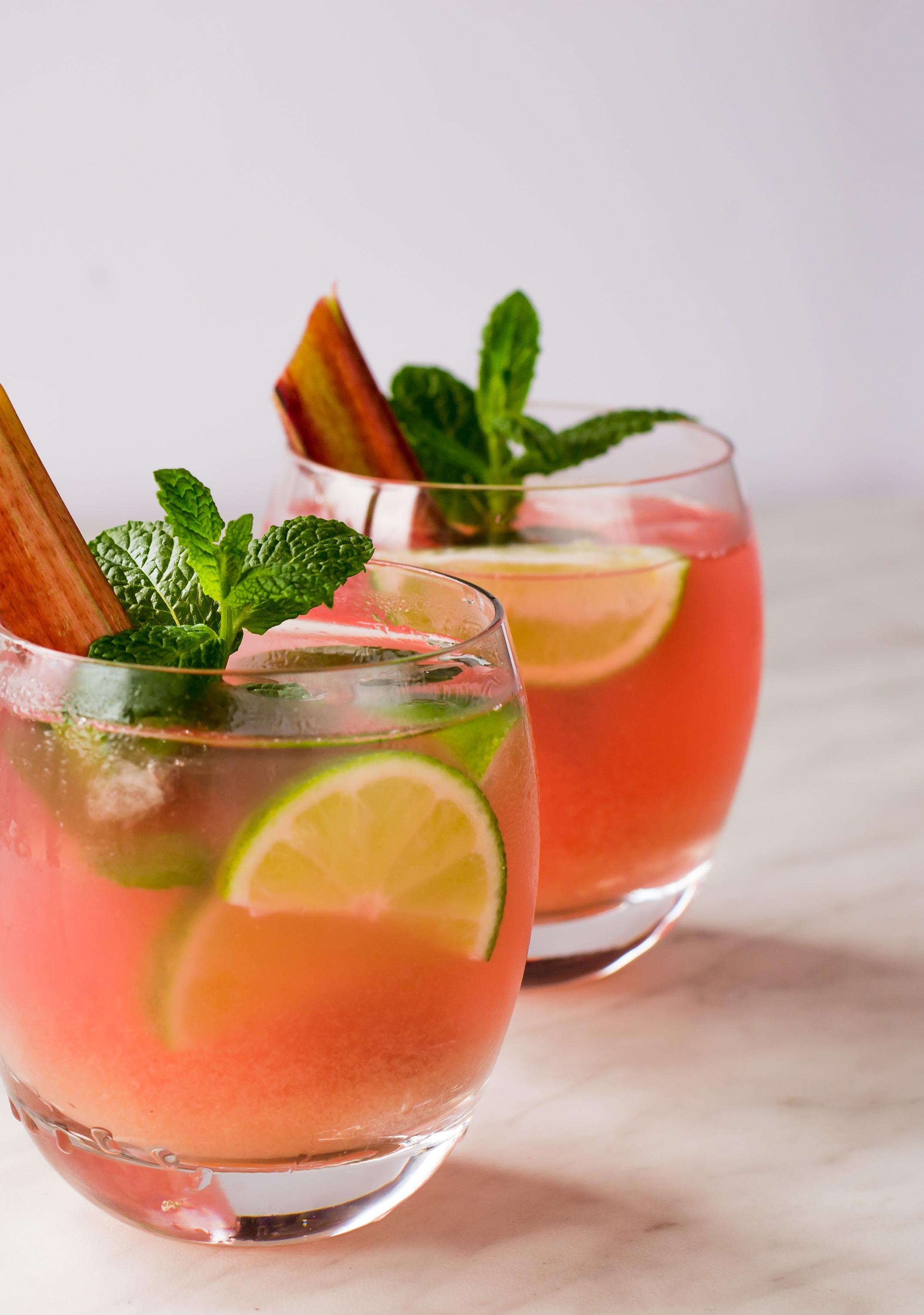

Mayacama Golf Club Sonoma County California
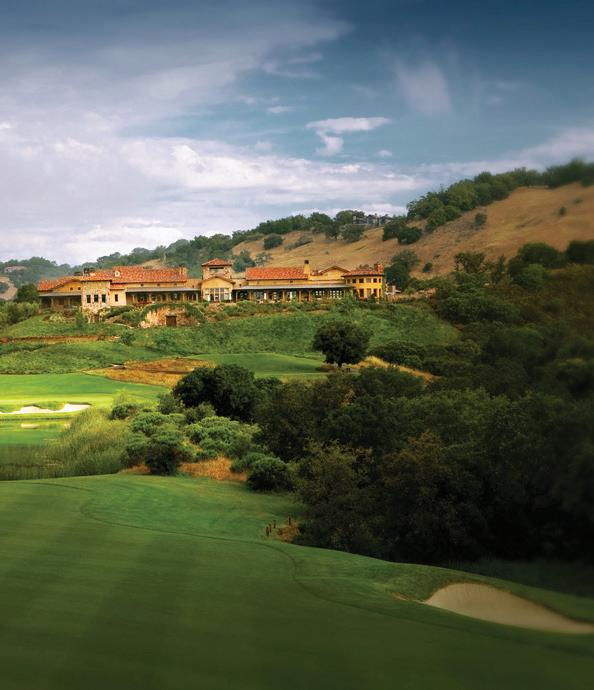
Scott Pikey Executive Chef
Nestled in the hills of northern Sonoma County, California, not far from the charming town of Healdsburg, Mayacama is a private golf and residential community where a vibrant club life is joined by an active sporting life in an indescribably beautiful valley. When I discovered this stunning property, I knew that the culinary team here had to be incredible as there is no shortage of outstanding restaurants in the region.
Scott Pikey is an Executive Chef that is both a mathematical thinker, and a creative thinker. He has a deep desire to educate and uplift his kitchen team. With this collaboration of culinary ideas, and an abundance of outstanding organic produce in the region, he is able to continuously deliver menus that the members and guests at Mayacama continue to return for time and time again. ~
Diana DeLucia
GK:
How did your interest in cooking arise?
I was born in the Midwest in St Louis, Missouri, to working-class parents with high values. I think it is part of the reason that I am where I’m at today. My parents taught me that I needed to have a passion for whatever I was going to do with my life.
A lot of my buddies in St. Louis were cooking in clubs, and I was very interested. I don’t know if this resonates or not, but my grandfather was a chef, and I remember when I was growing up, it was just something I took for granted, but now when I think about it, he had a significant influence on my life. I decided I would give this cooking thing a decent shot.
GK: Where was your first position?
It was at Old Warson Country Club, which was a private, family orientated club with a premier golf course and a great dining program. The chef was Irish, and a Master Chef named Aidan Murphy. I asked Aidan if I could come in to do a stage at Old Warson. He agreed. I loved everything about the kitchen at Old Warson, the hard work, the camaraderie, and me being a Virgo, well, I believe its ingrained in me to be immersed with work and managing many moving parts. After a while, I sat down with Chef Murphy to tell him my thoughts on my future in the industry. He told me that I could go through the ACF (American Culinary Foundation) and do their apprenticeship program. He told me it would be a three year program and that during that time, I will be a part of the United States Culinary Olympic Team. I will be expected to go to school and to compete throughout the Midwest and work six days a week. He said, “If you want to commit to this, I will take you on.” I committed immediately without hesitation.
GK: Tell us about the Culinary Olympic team experience.
It was a fantastic experience, I mean, just the competition aspect of it, the dedication and drive it takes is phenomenal. You utilize the foundation of skills you are learning, which is very important when you are young. I became immersed in the culinary world after that; I wanted to work in a Michelin Star Restaurant in France. It was in the mid 1990’s, which was a
INTERVIEW Golf Kitchen Magazine 96

time that was challenging for Americans to go to France to stage in Michelin or Relais & Chateaux Restaurants. Still, I was determined I wanted to experience international cuisine.
GK: Where did you go first?
I ended up moving to Ireland for seven months as I got a position at Sheen Falls Lodge in the town of Kenmare in County Kerry. I worked for trade, they housed me and fed me, and I worked in the kitchen to gain more experience. Ireland was fabulous; they are such hospitable people, friendly, kind, and funny. Sheen Falls was a hunting lodge at the time, and the kitchen was truly international, I met and worked with cooks from all over the world who speak different languages. There was no dominant nationality in that kitchen; it was diverse. After I got a feel for the Michelin and Relais & Chateaux experience, I wanted more, so I decided to travel Europe for the next five months to get more exposure.
GK: When did you return to the United States?
In 1998 I came back to the United States, and I spent some time in a little town called Telluride, which was a former Victorian mining town in Colorado’s Rocky Mountains, to take a break and get my compass going. I had secured a position at the Peaks Resort and Spa, and they put me in charge of this little kitchen that wasn’t being utilized. I turned it into a tapas-style situation. I loved the town, but it wasn’t known for its culinary scene, more so the skiing. I got bored and made the move to Vail. I met Chef Thomas Salamunovich, who was partnering with Vail Resorts on a 10 000 square foot restaurant named Larkspur. I took the position as a cook and became immersed in a different more Californian style of cooking with a lot of vinegars and verjus, much lighter fare as opposed to the heavy sauces in Europe. After six months, I became the sous chef and stayed for three years. I loved the job and meeting all the chefs that came through there.
There was one guy I really liked, his name was Richard Reddington who had worked for Daniel Boulud and Roland Passot for a long time and was currently the chef at Auberge du Soleil, which was Napa Valley’s first fine-dining
establishment. I believe it was founded in 1981 by visionary French restaurateur, Claude Rouas, and to this day has maintained its legacy as a “must experience” culinary destination.
After he left the restaurant, I had decided I wanted to work for Richard. I gave notice to Larkspur, traveled to California, and just showed up at Auberge de Soleil! Richard gave me the line cook position and then I was offered the sous chef position, where I stayed for two years. Towards the end of two years, I heard the CEO Rick Reiss mention they were opening a new place, Calistoga Ranch in Calistoga, CA. I told him that I would love to be a part of the opening team. He gave me the job, and I stayed for two years.
After two years, Rick asked me if I would be
interested in moving to South Carolina as the chef de cuisine for The Inn at Palmetto Bluff. It was exciting going to the south; there is so much indigenous cooking because they stay tied to their heritage, and the product I was working with was so cool. We were near the May River, and we were pulling out oysters, crabs, and shrimp, it was fantastic. We became the number one resort by Condé Nast in the two years I was there.
GK: What took you back to California?
I was feeling the urge to return to California’s wine country, and I found out that Mayacama Golf Club was looking for a chef. I flew to Cordillera Resort in Aspen, Colarado, which was owned by the same family to go for the interview. They interviewed many chefs, and I was asked to return for a second interview.
“Farm to Table is so much an overused term; people have been doing it for generations; I prefer to look at myself as a responsible chef.”
They loved what I was cooking and gave me the position. Ironically the owners, the Wilhelm’s, were from St. Louis, Missouri, and our families knew each other well.
I was super excited when I started, there was a lot of work to be done, and as you know, I love managing things, and we turned the kitchen around from a food cost and quality perspective. We butchered our own products, and we began to utilize the entire product whether it was chicken, beef, or whatever. Being in Northern California, the resources like fish, and other proteins, cheeses, vegetables are abundant. I try to use the farms within a 100-mile radius of Mayacama. There is a great farmers market in the town of Marin, which became one of the third largest farmer’s markets in California, and on Thursdays, it was a chef’s market. The farmers selling their products there are so passionate about what they grow. I am so fortunate, and its one of the reasons I am still here, my food wouldn’t look as good if it wasn’t for these farmers.
GK: Tell us about some of your favorite farmers.
I love the product from Full Belly Farms, Riverdog Farms, and David Little, which are certified organic farms located in the beautiful Capay Valley of Northern California.
GK: You are quite the farm to table chef then?
Farm to Table is so much an overused term; people have been doing it for generations; I prefer to look at myself as a responsible chef. I try to source products from farmers and fishermen who are producing or growing in an ethical fashion that is traceable and sustainable down the line. I need my menus to be fresh and healthy, and for the most part, I feed the membership here as protectively as I feed my family. I have been here for 12 years now, which is crazy for a chef, and we have developed an incredible culinary program.
GK: Tell us about your farm initiative at Mayacama?
We have a small farm here that sustains about 60% of our greens. Still, we have about an
acre of land we could utilize to have a bigger growing footprint. I envision growing microgreens and edible flowers; we could hold farm to table events right there on the farm so guests can experience the intense flavors of product that is coming straight from a vine or the ground. There is such a massive difference in the smell and taste of the product picked and served almost immediately.
GK: You have an excellent bee program, has it been affected by the fires?
About five years ago, together with our superintendents, we installed our first colonies. The first year the yield was magnificent, but then the fires came and ripped through this valley. The hives remained, but the bees left. After several months they began to return, and we have stabilized them, and now have nine healthy colonies that provide us with honey for most of the year. It’s rewarding to see other golf and country club properties installing hives across the world; it is a critical responsibility to be stewards of the land.
GK: Tell us about some of the proteins you bring in from and other areas. I heard you have some favorites.
I love Millbrook Venison, its probably the best I have ever had, and Akaushi (Japanese Red Cattle) beef which originated and evolved in Kumamoto, Japan, but is now available in Texas, and I love Snake River Farms in Idaho. Our poultry and squab and duck are all from California. Petaluma, at one time, was the capital of poultry in America.
GK: Tell us about your team?
The culinary side of Mayacama is a team effort. I believe in raising my team members up and I value their ideas and creativity. Collaboration brings about a more diverse menu and united team in the kitchen.
GK: You are fortunate to work with 40 of the best vintners in Sonoma and Napa Valley. Does that influence your menu?
Actually no. The menu is created first, and then we challenge our wine director Jeff McCarthy to find the perfect pairing.
99 Mayacama Golf Club
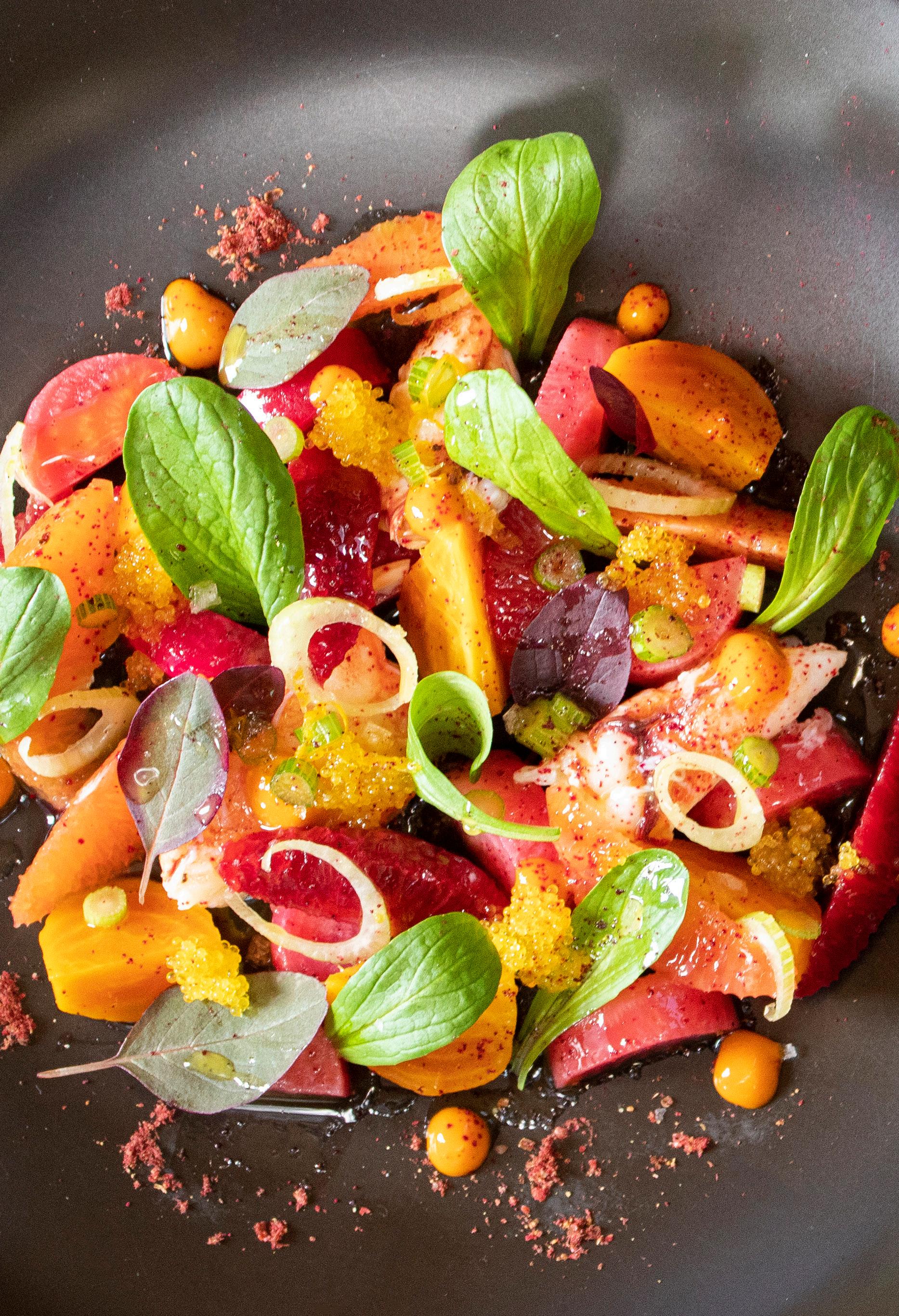 RECIPE BY SCOTT PIKEY
RECIPE BY SCOTT PIKEY
DUNGENESS CRAB SALAD with Roasted
Beets, Citrus, Sea Buckthorn, Vanilla Bean Dressing
Serves 8
Ingredients
Beets
• 14 Baby Candy Stripe Beets (washed and cleaned)
• 14 Baby Gold Beets (washed and cleaned)
• 2 cups Olive Oil
• 1 cup Orange Juice
• 2 Tablespoons Sugar
• 3 cups Water
See Buckthorn Puree
• 1 cup Sea Buckthorn Berries
• 1/2 cup Sugar
• 1 teaspoon Water
Citrus and Vanilla Bean Vinaigrette
• 1 cup Orange Juice (freshly squeezed)
• 1/2 cup Champagne Vinegar
• 2 teaspoons Local Honey
• 3 cups Grape Seed Oil
• 1 cup Extra Virgin Olive Oil
• 1 Fresh Vanilla Bean
To Finish
• 1 #Dungeness Crab Meat (picked and cleaned)
• 3 Baby Candy Stripe Beets (peeled and shaved raw)
• 3 Baby Gold Beets (peeled and shaved raw)
• 3 Blood Orange Segments
• 3 Caracara Orange Segments
• Sea Buckthorn Puree

• 2 Baby Fennel (shaved raw)
• 2 cups Mache Greens (wild if possible)
• 1 ounce Yuzu Tobiko
• Salt and Freshly Cracked Pepper
• 1 Tablespoon Sumac Powder
• Citrus and Vanilla Vinaigrette
• Sea salt
Preparation
Beets
Preheat the oven to 400 degrees °F
Trim the beets tops and wash thoroughly with water until all dirt is removed.
Place the beets in a separate baking dish according to color.
Combine the oil, orange juice, sugar, salt and water and pour over the beets.
Cover the dish with a tight heat proof lid or aluminum foil and place in the oven.
Cook the beets 45 minutes or until tender. Remove and cool to room temperature.
Peel the beets using a kitchen towl to remove the skin. Quarter 14 beets and cut the rest into rounds.
Sea Buckthorn Puree
In a small sauce pan add the water and sugar and simmer until light Carmel.
Reduce the heat to a low simmer and add the sea buckthorn berries, cover and cook for 10 minutes. Remove the cover and reduce the liquid by half. Place in a blender and puree until smooth. Strain the puree through fine sieve and cool.
Citrus and Vanilla Bean Vinaigrette
(Reduce on low heat until a syrup consistency and cool)
Combine the orange juice, vinegar, honey and vanilla bean and whisk together in a stainless steel bowl. Slowly incorporate the olive oil until all the ingredients are combined.
Season with salt and pepper.
Finish and Assemble
Place the assorted beets in a mixing bowl and lightly dress with the citrus vinaigrette and season with salt. Assemble the beets in a shallow coupe style bowl. Thinly shave the baby fennel and raw beets on a mandolin.
Arrange the shaved beets, crabmeat, fennel, blood orange and caracara segments around the dish. Lightly dress the whole dish with the citrus vinaigrette and pinch more sea salt.
Garnish with Mache greens, yuzu tobiko and sumac powder.
Wine Match
The flavor of the beets would be the dominating flavor so I would consider for white wine Albarino, Gruner Vetliner, or Torrantes. A fruity Beaujolais could also work well and when in doubt a dry rose.
If matching the flavors of the crab is your preference, consider Sparkling wine, a dry Alsatian style Pinot Gris or Riesling. An unoaked chardonnay might possibly work but stay away from oak.
Jeff McCarthy, Wine Director Mayacama Golf Club
Golf Kitchen Magazine 102
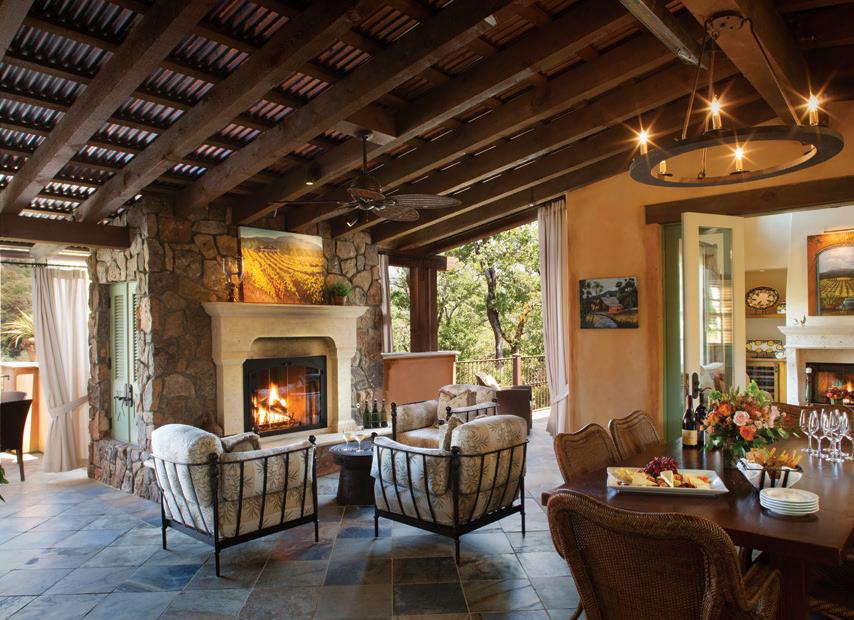
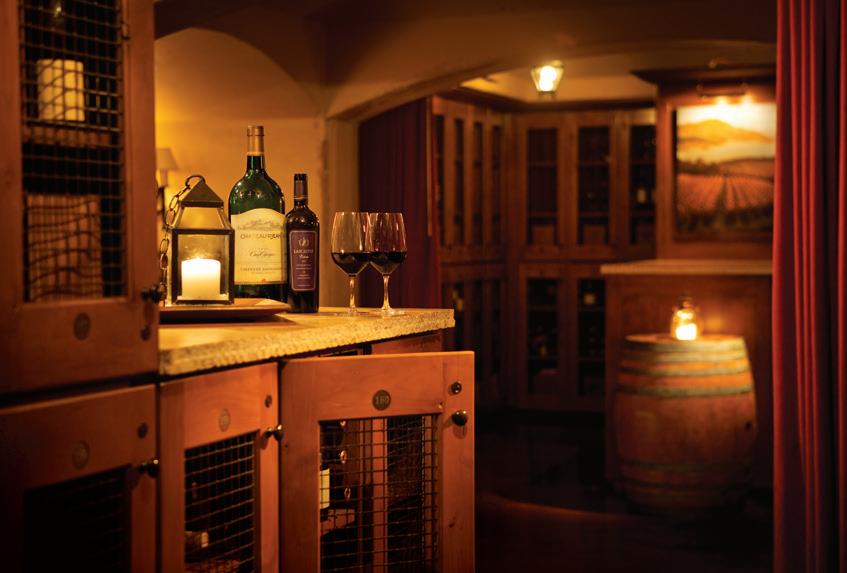
103 Mayacama Golf Club
 RECIPE BY SCOTT PIKEY
RECIPE BY SCOTT PIKEY
Mt. LASSEN TROUT with Cauliflower, Brussels Sprouts, Radish, Grapes, Almonds

Serves 8
8 Trout Fillet (5 ounce portion) (3.5#)
2 Tablespoons Butter
6 Sprigs Thyme
Slow Roasted Grapes
32 Red Seedless Grapes
1/4 cup Grapeseed Oil
Cauliflour
1 head Purple Cauliflower
1 head Cheddar Cauliflower
1 head Green Cauliflower
Cauliflour Puree
1 head White Cauliflower
4 cups Cream
2 teaspoons Salt
1 Tablespoon Curry Powder
4 Tablespoons Unsalted Butter
Braised Radishes
24 French Breakfast Radishes
2 cups Vegetable Stock
4 sprigs Thyme
2 Tablespoons Unsalted Butter
Brussels Sprouts
24 Brussels Sprouts
105 GlenArbor Golf
Ingredients Trout
Preparation
Trout
Chef Note: The skin can be left on or removed.
Remove all bones from the trout filet and portion to 5 ounces. Keep refrigerated until ready to cook.
Chef Note: The butter and thyme will be used when cooking the fish.
Slow Roasted Grapes
Preheat the oven to 150° F (low fan). Wash the grapes and place on a paper towel to dry.
Toss the grapes with grapeseed oil and the place into a large sauté pan or lined baking sheet and roast for 2 hours.

Cauliflower
Preheat the oven to 150° F (low fan). Wash the grapes and place on a paper towel to dry.
Toss the grapes with grapeseed oil and then place into a large sauté pan or lined baking sheet and roast for 2 hours.
Saute until the Gnocchi are a light golden brown on either side, about 3 minutes on each side. Toss with whole butter, Parmesan, and black pepper.
Cauliflower Puree
Place the cauliflower, cream, salt and curry powder into a large saucepan. Cover and bring to a simmer for 30 minutes stirring every 10 minutes.
Drain the Cauliflower and reserve the liquid.
Puree half of the cauliflower mixture into a blender slowly adding half the butter and a tablespoon of the reserved liquid until smooth. Pass through a fine mesh Tamis.
Pour the mixture into the lined pan to cool and cover with plastic wrap with a tight seal to prevent a crust from forming.
106
Golf Kitchen Magazine
Braised Radishes
Trim the radish tops leaving 1/4 inch stem and wash until all dirt has been removed, then place the cleaned radishes in a large sauté pan.
Cover with the vegetable stock and simmer on low heat for 8 minutes, add the butter and thyme and emulsify. Cool the glazed radishes at room temperature.
Brussels Sprouts
Clean the outer leaves and discard. Cut the Brussels sprouts in half and peel away the tender leaves.
Save the center Brussel sprout core for another use.
Final Preparation and Assembly
In a small sauce pot gently rewarm the cauliflower puree and keep a lid on until ready to plate.
Place two large sauté pans on high; add 3 ounces of the grapeseed oil to both.
When the oil is hot, sear the trout and cook for three minutes, add 2 Tablespoons of butter and thyme and cook two minutes.
Remove the fish from the pan and place on a paper towel. In the other saute pan add the cauliflower, and lightly caramelize.
Remove any excess oil and add the Brussels sprout leaves, radishes 3 Tablespoons of vegetable stock and heat all the vegetables, add 2 Tablespoons butter until emulsified. Finish with the almonds, grapes and then season.
Spoon the cauliflower puree into the center of a coupe style bowl.
Add the glazed vegetables on top followed by the trout.
Serve immediately.
Wine Match
A classic pairing with Mt. Lassen Trout would be a lightly oaked chardonnay, or a light, lower alcohol Pinot Noir from the Sonoma Coast or Burgundy. However, the curried cauliflower throws a slight curve into the mix, and this would give me an excellent opportunity to suggest a light, unoaked chardonnay or even better an aromatic white wine like Chenin Blanc, Arneis, or Torrantes. If I wanted to go outside the box, I would also consider Grenache.
Jeff McCarthy, Wine Director Mayacama Golf Club

107 Mayacama Golf Club
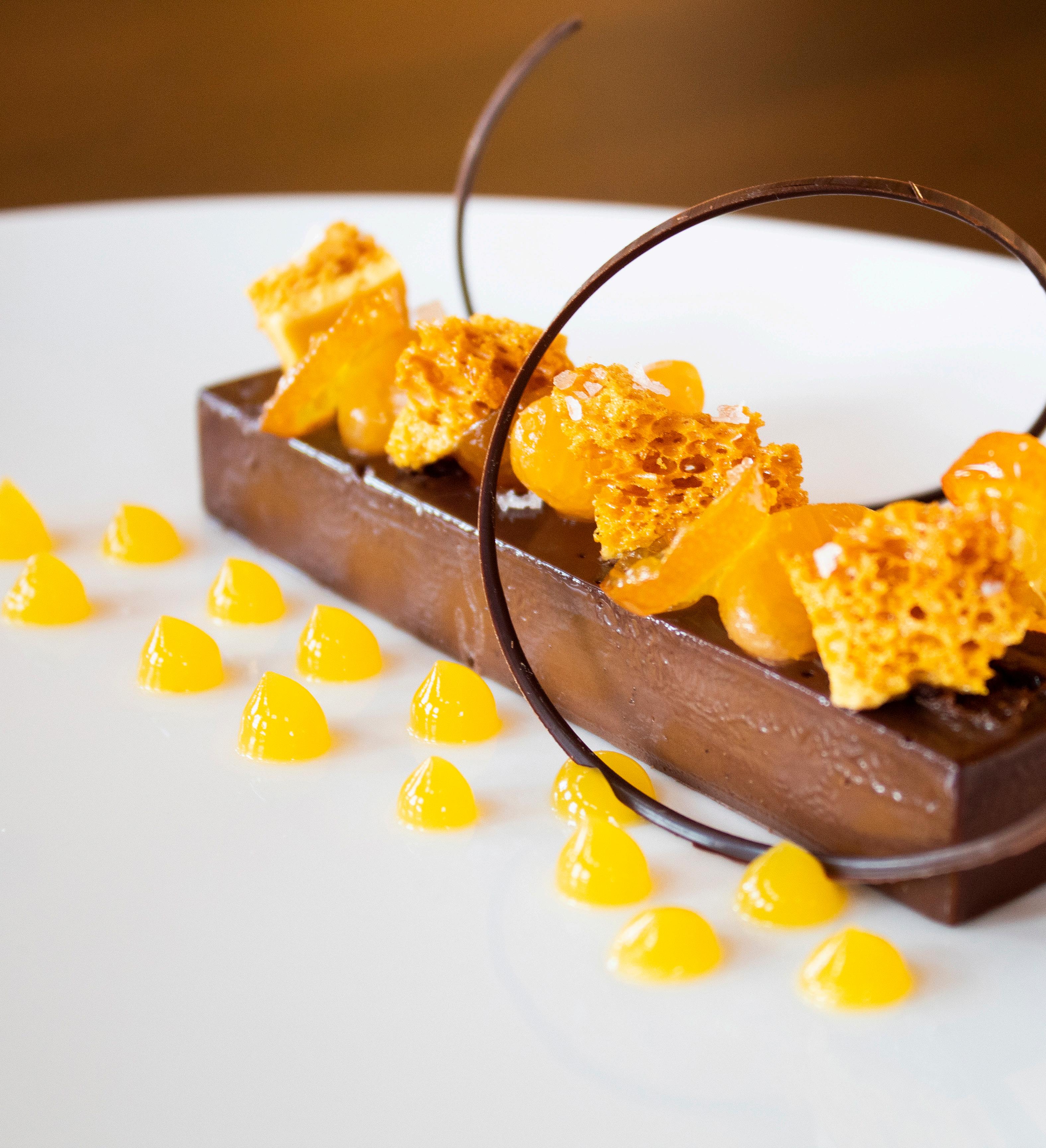
Golf Kitchen Magazine 108
RECIPE BY SCOTT PIKEY
SOFT CHOCOLATE GANACHE
Serves 6
Ingredients
Soft Chocolate Ganache
284 grams Bitter Sweet Chocolate (63% or higher)
470 grams Heavy Cream
1 ½ Gelatin Sheets
200 grams Cold Water (#1)
½ teaspoon Agar Powder
55 grams Cold Water (#2)
teaspoon Salt
Honey Comb Candy
300 grams Sugar
110 grams Water
30 grams Honey
65 grams Corn Syrup
4 teaspoons Baking Soda
Mandarin Orange Segments
100 grams Mandarin Orange Segments
300 grams Sugar
150 grams Water
Mandarin Orange Fluid Gel
335 grams Mandarin Orange Juice
75 grams Water
75 grams Sugar
6 grams Agar Powder
1 Tablespoon Lemon Juice
Candied Kumquats
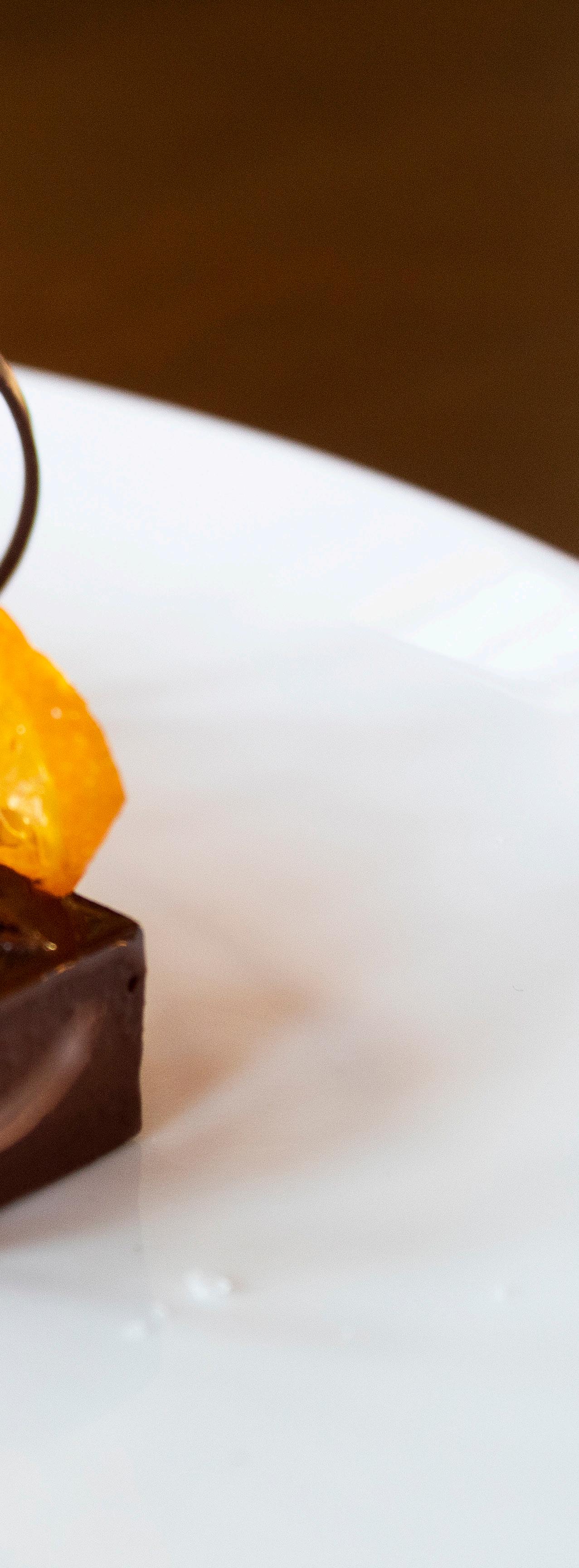
100 grams Sliced Kumquats
200 grams Water
200 grams Sugar
Mayacama Golf Club 109
Preparation
Soft Chocolate Ganache
Bring the heavy cream to a simmer and pour over the chocolate. Allow the cream and chocolate mixture to sit for five minutes.
Slowly stir the cream into the chocolate and mix until the mixture is completely emulsified and all the chocolate is melted. Set aside and keep warm.
Soften the gelatin in cold water #1. Mix together agar powder and cold water #2. In a small sauce pan bring the agar/water mixture to a simmer and cook for 3 minutes.
Strain the gelatin and add it to the hot agar/water mixture and whisk until the gelatin has completely dissolved.
Whisk the gelatin mixture into the chocolate and strain. Pour chocolate ganache into a parchment lined 8x8 cake pan and place in the refrigerator until completely set. About 4 hours.
Honey Comb Candy
Line an 8x8 cake pan with parchment paper. In a small sauce pot, mix together the sugar, water, honey and corn syrup.
Cook the mixture until it reads 270° F on a candy thermometer. Quickly stir in the baking soda and pour candy onto the parchment lined cake pan. Allow to cool slowly at room temperature for two hours.
Break into small pieces using a fork and store in an air tight container in a cool dry place.
Mandarin Orange Segments
Peel the mandarin orange and carefully pull apart the segments.
Clean as much of the white pith off of the segments using a small paring knife.
Lay the segments flat in a shallow pan. Bring the water and sugar to a boil making sure the sugar is fully dissolved.
Pour the hot syrup over the mandarins and allow the segments to cool in the refrigerator.
Store in the refrigerator in an air tight container.
Mandarin Orange Fluid Gel
In a small sauce pan whisk together the water and agar powder and bring to a simmer. Cook for three minutes then add the sugar and cook for 10 more seconds.
Whisk the mandarin and lemon juice into the hot syrup. Quickly pour the mixture onto a lightly oiled sheet pan and place in the refrigerator to cool for at least one hour.
The gel will be hard, cut into ½ inch cubes and place in a blender.
Slowly blend the mixture until it reaches a smooth paste. Place in a piping bag and store in the refrigerator.
Candied Kumquats
Slice the kumquats into rings about 1/16 th of an inch wide, removing all of the seeds.
Bring a pot of water to a boil and place the kumquats in cooking for 30 seconds.
Strain the kumquats and cool in ice water. Repeat the process one more time.
Bring the sugar and water to a boil then add the kumquats.
Simmer the kumquats until 75% of the syrup has been reduced.
Pour onto a sheet pan and allow to cool. Store in the refrigerator in an air tight container.
Assembly
Take an almost overflowing tablespoon of parsnip puree and smear side to side on a the plate.
Place the seared chickpea gnocchi across the parsnip puree.
Sprinkle in the same direction the seared bay scallops. Garnish with the micro greens.
Wine Match
“LVNAE” Etichetta Nera, Vermentino, Cantina Bosoni, Colli di Luni, Italy 2016.
Jeff McCarthy, Wine Director Mayacama Golf Club
Golf Kitchen Magazine 110

Mayacama Golf Club 111
The Tuxedo Club Tuxedo Park New York
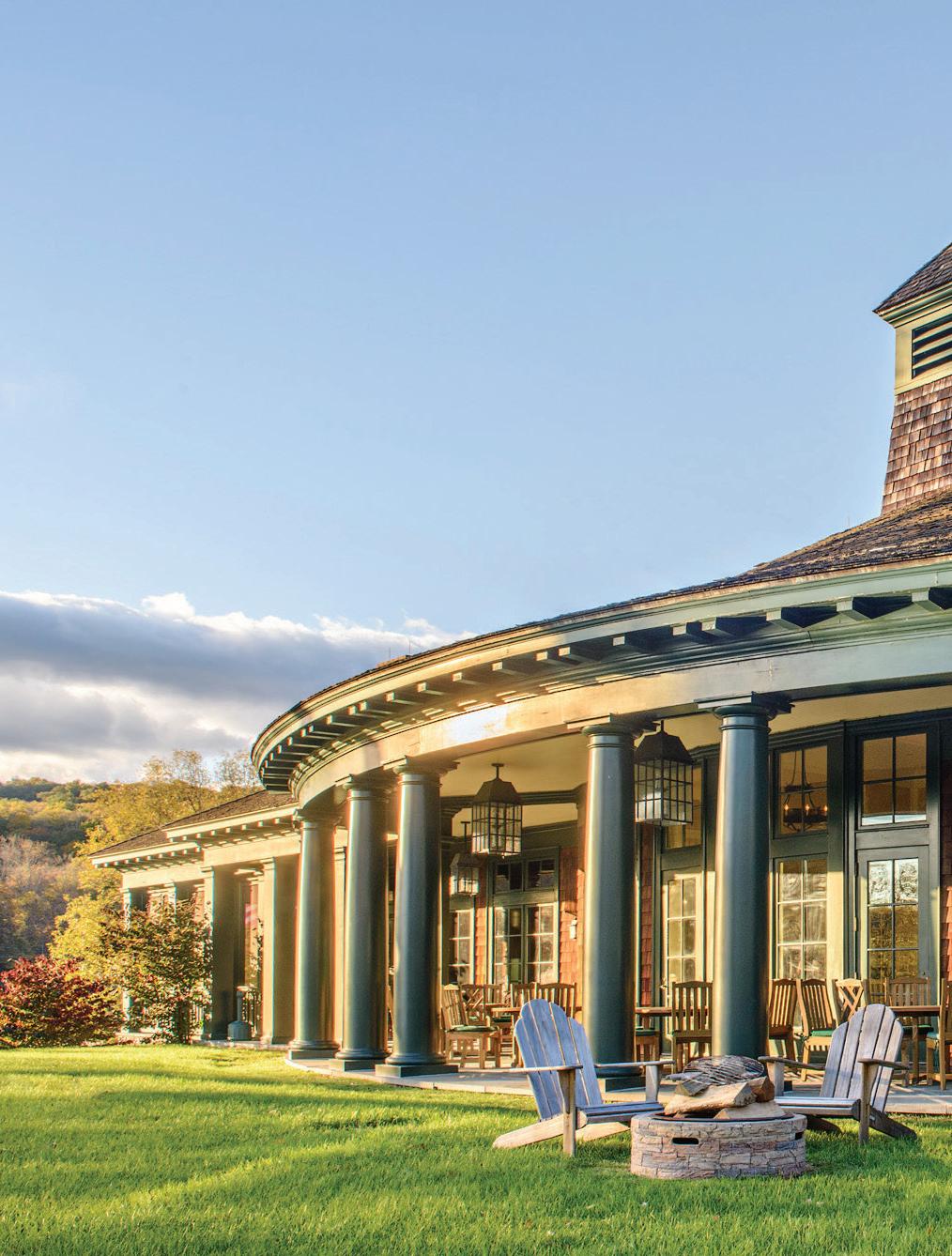
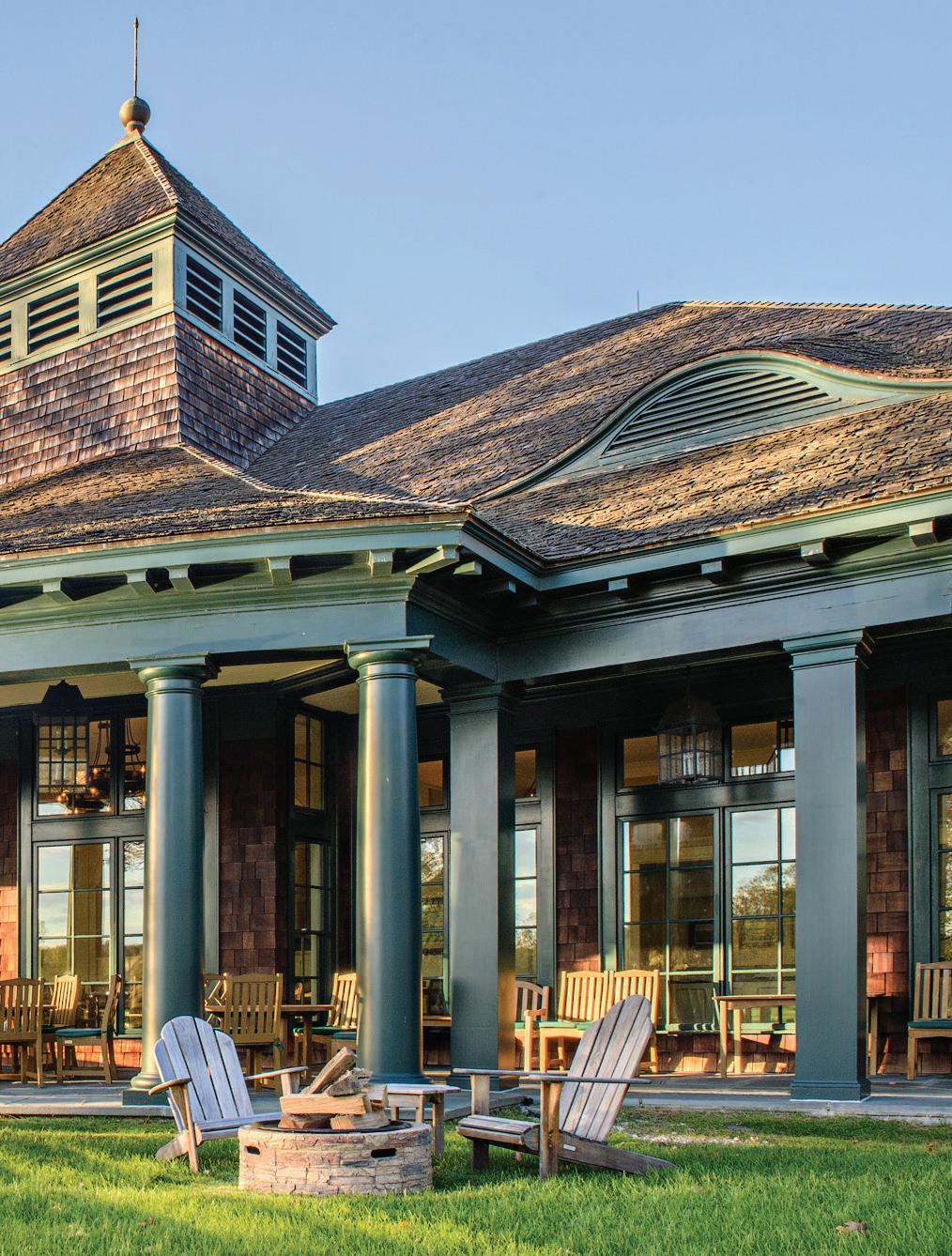
The
Image
Golf Clubhouse
courtesy The Tuxedo Club
Blake Burgard Executive Chef
I met Blake Burgard through his colleague and friend Michael Ruggiero, who had previously worked at The Tuxedo Club as the Executive Chef. Blake traveled to Golf Kitchen Punta Mita in Mexico to play golf and cook alongside Ruggerio in April of 2019 and then cooked at the Golf Kitchen Culinary Excellence Awards at GlenArbor Golf Club in August of 2019. He has an excellent manner, and with his roots being from New Orleans, Chicago and Westchester, he has undoubtedly refined his culinary talents. ~
Diana DeLucia
GK: When did you decide you were interested in cooking?
I am originally from New Orleans, and I have always been interested in cooking. Everyone in my family is an excellent cook! My mom and both of my grandmothers were great cooks. Gloria, who babysat for my family for two generations, was also a great cook. In New Orleans, food is such a big part of the culture. If you were a dinner guest at someone’s house, you always brought a dish along, and we would all talk about our recipes.
When I was younger, my father used to have to take clients out to lunch regularly. When I wasn’t in school, I was lucky enough to get brought along on quite a few business lunches at some very nice restaurants. This opened my eyes to high-end dining.
I have worked in a restaurant/kitchen of some shape or form since I was 15 years of age. I started as a busboy in a local neighborhood restaurant and moved into the kitchen and have been in a kitchen ever since.
I went to school in New Orleans and after high school, I did a brief stint at Louisiana State University (LSU), then attended the John Folse Culinary Institute at Nicholls State University, Thibodaux, LA. When I was there, I did an internship in Chicago for Edward Leonard CMC and wound up getting along so well with him that he offered me a job when I finished college. When Ed sold the restaurant, he took the job at Westchester Country Club and took me with him.
GK: How long were you at Westchester CC?
I worked at Westchester CC for five years. My time there was an invaluable learning experience. Chef Ed and the team (Michael Ruggiero, Matthew Roche, Jose Tavarez, Jonathan Moosemiller, Michael Pillarella, and Victor Zarate) were a great crew to work with and to learn from.
When my friend and colleague Michael Ruggiero left, I followed him to The Orienta Beach Club as his sous chef and then stayed there for about four years. I went to a sous chef position at the Field Club of Greenwich in Connecticut, and I enjoyed working there, it was a small but active membership, mainly tennis and racquets focused. Chef Mark LeMoult and the team were a pleasure to work with.
Michael had moved to Louisiana for a season, and when he returned, he took the position at The Tuxedo Club and asked me if I would consider joining him as he needed help with staffing issues and other things. I came on board as the golf clubhouse chef. I worked in that position for about a year and a half, and
INTERVIEW Golf Kitchen Magazine 114
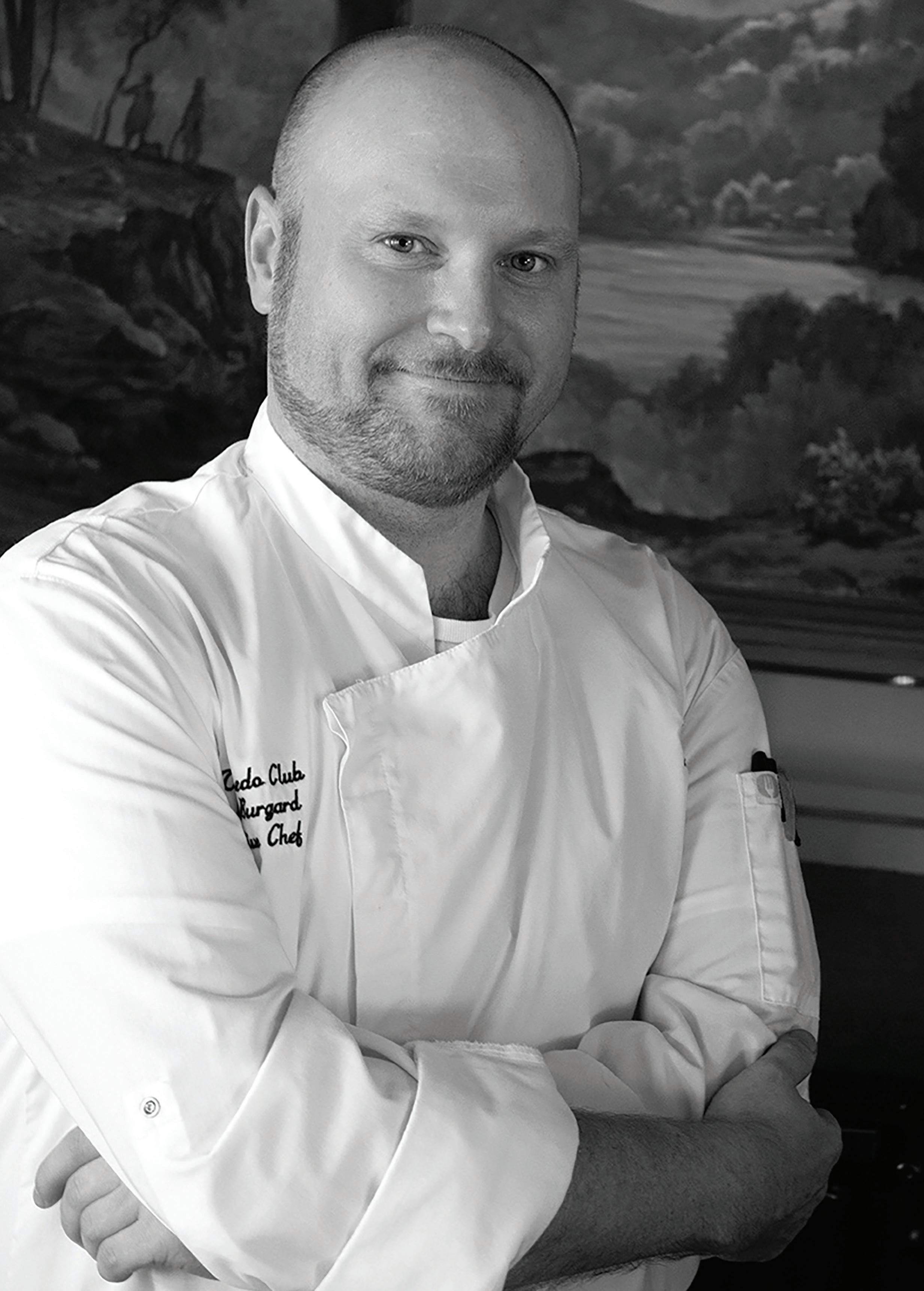


Business magazine Template 116
The bar at the Golf Clubhouse Image courtesy The Tuxedo Club
The ballroom Image courtesy The Tuxedo Club
when Michael was promoted to the Culinary Director position, I became the Executive Chef. Michael left after a year and took the reigns at GlenArbor Golf Club in Bedford Hills, New York, that’s two and a half years ago now!
GK: Tell us about The Tuxedo Club kitchens?
This club is exciting. We have the main production kitchen where we do all of our banquets, weddings, and big member events. The pool kitchen is our quick service casual operation, and the golf kitchen is where we do the majority of our a la carte dinners. The golf kitchen is open six days a week, lunch and dinner, and we do breakfast on the weekends, and it is open from April-November.
One thing that proves to be a challenge here is the location of the kitchens. They are spread around the property. The golf clubhouse is almost a ten-minute drive from the main clubhouse. That makes logistics of moving products and people to where they need to be a bit of a challenge at times. I have a core staff of 9-10, but during the season, my staff goes up to about 30. My banquet/pastry chef Mauro Cantatore is an integral part of what we do.
At the main clubhouse we change the menus each week throughout the entire season. This gives my team a chance to be creative each and every week as we continue to exceed our membership and committee’s demanding expectations.
The menus at the pool and the golf clubhouse, are changed every month and weekly in the main clubhouse. We do keep member favorites like salads and burgers, we have to, and they have high expectations with the quality.
GK: Tell us about your garden?
We started the garden two and a half years ago, and it is producing well. We are expanding this year and adding two more beds at the main clubhouse and also a new herb garden at the golf clubhouse. We are working on getting some beehives installed, but there are bears here and many town regulations with electric fences; bears love honey, and we are trying to
figure that out. We are trying to work out how we can put the hives up on the roof of one of the buildings so that way we don’t need an electric fence. Recently we started an indoor hydroponic garden, and this will be utilized to produce herbs, microgreens, and flowers.
We produce our charcuterie, salamis, deli meats, pastrami, and sausages in house. We cure all kinds of things and its always fun. Right now, what I like doing the most is working with the smaller farms in the Hudson Valley. We get cool products weekly, and it’s ever-changing. I have to change the menu often, and I get many product lists from these farms and some of the stuff, I don’t even know what it is!! This is exciting for me as I get to work with new products often. It is fun and a challenge for everyone here.
GK: Tell us about your Shore dinners?
Every Friday, during the summer, we have Shore dinner. The “appetizer” portion of the meal is served buffet style, and we have composed salads, salad bar, raw bar, and action stations. Then entrees are served a la carte followed by a dessert/pastry buffet.
GK: How long is your season here?
We are open almost 11 months out of the year as our members like to come in for lunch or dinner even in the offseason. We close for five weeks in January.
- Pool Kitchen open from May-September
- Golf Kitchen open from April-November
GK: Tell us about the reservoir.
People can boat on Tuxedo lake, but the boats must be electrically powered. We have a boathouse, and many members store their boats here. The lake is stocked with several varieties of trout; we split the costs with the village. A lot of people come here to fish, and the club owns some boats that are available for rent. We have a full-time boat master who is also a fishing captain. He is very knowledgeable and helps people out when they want to go fishing.
The Tuxedo Club 117
GK: You have every type of racquet sports here. Tell us about that?
Yes, it’s a big operation and during the summer and we have solid tennis and racquet sports programs here, and players come to compete from all over the world.
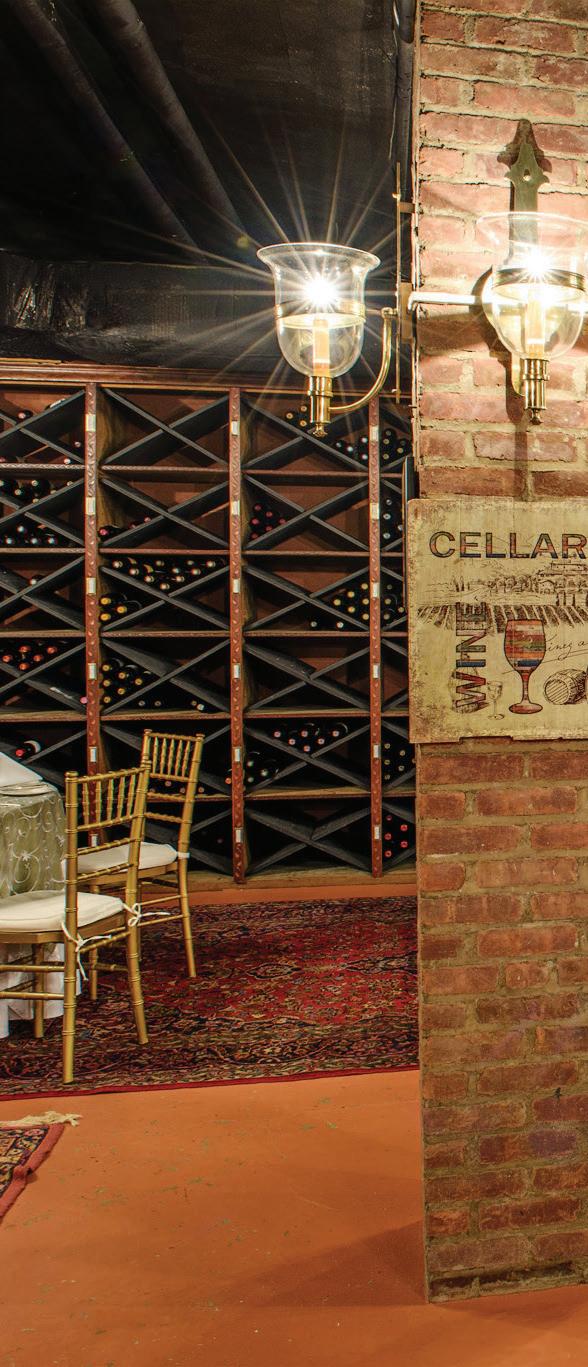
Golf Kitchen Magazine 118
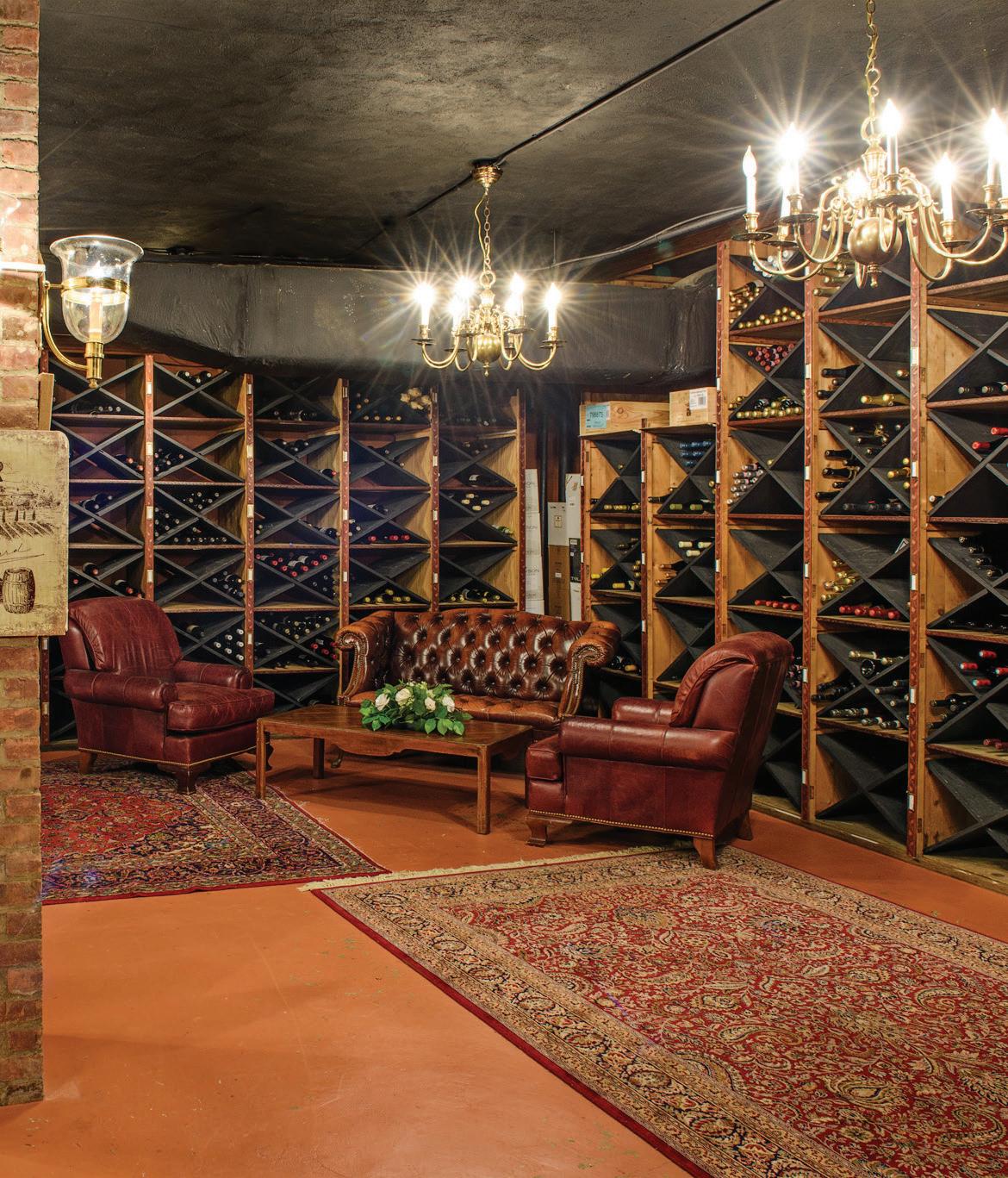
The Tuxedo Club 119
The Wine cellar
Image courtesy The Tuxedo Club
RECIPE BY BLAKE BURGARD
SCALLOP CRUDO with Sour Apple Consume, Fennel, Apple, Radish and Horseradish Oil
Yields 4
Ingredients
Sour Apple Consume
• 4 Apples (Tart variety such as Granny Smith, Courtland, Empire or Pink Lady)
• 2-3 Tablespoons Apple Cider Vinegar
• Salt and Pepper (to taste)
• Maldon Sea Salt (sprinkle)
Fennel Salad
• 1 Apple (sweeter variety such as Honeycrisp, Zester or Fuji)
• 1 head Fennel (reserve fronds for garnish)
• 2 Tablespoons Rice Wine Vinegar

• 1 Tablespoon Extra Virgin Olive Oil (plus a few drops for garnish)
• 1 Tablespoon Honey
• Salt (to taste)
Crudo
• 4 u-10 Scallops
• 1 Watermelon Radish
• 1 Apple ((sweeter variety such as Honeycrisp, Zester or Fuji)
Garnish
• 4 Nasturtium Leaves
• Horseradish Oil (4-5 drops for garnish) Chef Note: Can be found at most Asian markets
Golf Kitchen Magazine 120


Golf Kitchen Magazine 122
The 18th hole
Image courtesy The Tuxedo Club
Preparation

Sour Apple Consume
Freeze the four tart apples. (whole apples) Remove from freezer and let thaw at room temperature for 2 hours.
With a skewer poke a few holes through the flesh of each apple and crush with your hands or a press.
Retain the juice and pass through a chinois or cheesecloth.
Season the juice with salt to taste and 2-3 Tablespoons of the Apple Cider Vinegar.
Fennel Salad
Remove the core from the fennel and finely shave on a mandolin.
In a bowl mix the fennel with the rice wine vinegar, salt, honey and Extra Virgin Olive Oil.
Scallops Crudo
Trim the adductor muscle from the scallops and slice thinly. (4-5 slices each scallop)
Slice the watermelon radish and sweet apple thinly on a mandolin and punch out small rounds with a ring cutter.
Assembly
Place the fennel salad slightly off-center in the bottom of a bowl.
Shingle the sliced scallop on the side of fennel. Garnish the dish with the rounds of sliced apple and watermelon radish, nasturtium leaf and fennel frond.
Pour 3 ounces of the sour apple consume into the bowl and place a few drops of horseradish oil and EVOO in the consume.
Wine Match
2015 Drouhin Vaudon Chablis Premier Cru
The Tuxedo Club 123

•
RECIPE BY BLAKE BURGARD
DUO OF DUCK with Pan Roasted Margret Duck Breast, Crisp Duck Leg Confit, Chiccory, Chioggia Beets, Chanterelles, Sun Choke Puree, and Preserved Orange
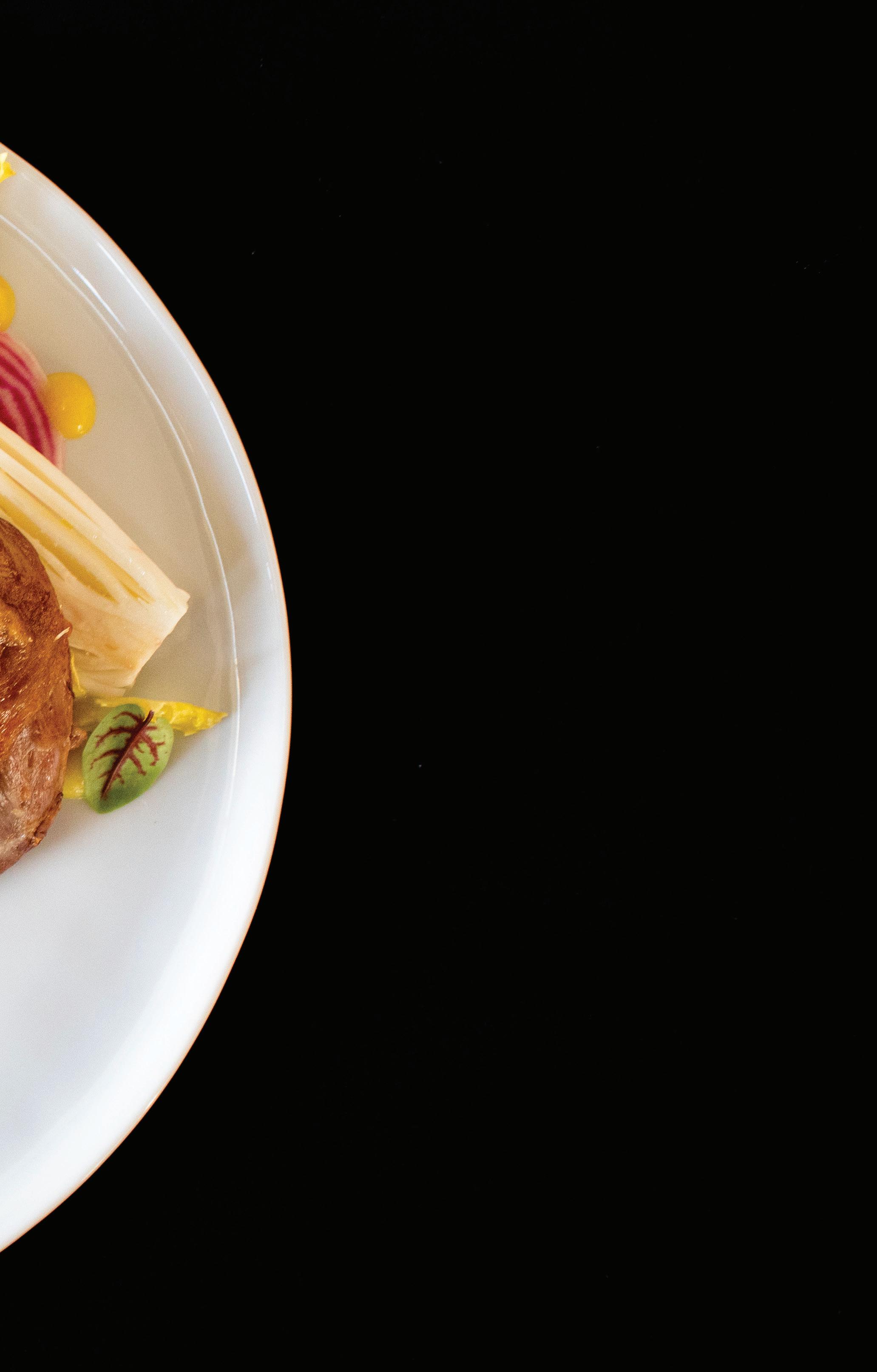
Yields 4
Ingredients
• 1 Magret Duck Breast
• 4 Duck Leg and Thigh Quarters
• 3 Chioggia Beets
• 1 cup Chanterelles
• 3 Garlic Cloves (smashed)
• 3 Bay Leaves
• 4 Chiccory (frisee, friseline, or other bitter green)
• EVOO
• Maldon Sea Salt
• 1 Meyer Lemon (juice)
Curing Mix
• 2 cups Salt
• 1 cup Sugar
• 2 Tablespoons Toasted Coriander Seeds
• 3 Bay Leaves
• 1/2 bunch Thyme
Sun choke Puree
• 2 cups Sun Chokes (peeled and roughly chopped)
• 2 Tablespoons Butter
• 1/2 cup Heavy Cream
• 1 Tablespoon Salt
Preserved Orange
• 6 Oranges
• 2 Lemons (juiced)
• 2 cups Kosher Salt
• 1/2 cup Sugar
Garnish
• Red Veined Sorrel
• Pea Tendril
• Viola flower
Preparation
Preserved Oranges (make 4 weeks ahead of time)
Cut the 4 oranges into wedges. Mix the salt and sugar together in a small bowl. Layer orange wedges in a clean jar with the salt and sugar mixture in between each layer.
Cover with juice of remaining oranges and lemon juice. (enough to submerge).
Leave in a cool dark place for at least four weeks. Once oranges are ready, remove from brine. Chef Note: The rind will be tender when ready. Cut the flesh from the rind.
Poach the rind in water for about 20 minutes. Transfer the rind and a little of the poaching water to a blender. Puree until smooth consistency. Chef Note: Can thicken with xanthan gum if necessary. Place in squeeze bottle for assembly.
Curing Mix (make ahead of time)
Combine all ingredients for the curing mix and split in half. Set aside.
Roast 2 chioggia beets 300°F one hour or until tender. Set aside.
Slice 1 beet very thin on mandolin and hold in cold water. (save for garnish)
Duck Breast
Trim the duck breast and score the skin.
Coat the duck breast in the curing mix, cryovac and let stand in fridge for 3 hours. Rinse, dry and season the breast with salt and pepper.
Place the breast skin side down in a flat cast iron skillet on as low a heat as you can keep the burner.
Chef Note: Try to render as much fat as possible, it will take a good 20-30 minutes. Do not flip the duck. When the skin is rendered and crispy, remove from heat and let cool on a wire rack.
Duck Confit
Cover the duck legs with the reserved curing mix. Cryovac and let stand in fridge overnight.
Wash duck legs and dry.
Place legs on a wire rack and place in preheated 375°F oven for 25-35 minutes until nicely browned and fat rendered. Reserve the rendered fat.
Place the duck legs in cryovac bags with 2-3 ounces of the reserved duck fat, smashed garlic cloves, bay leaf and salt and pepper to taste. Seal and submerge in 155°F water bath for 24 hours.
Roast in 400°F oven until skin is crisp and warmed through for service.
Sun Choke Puree
Place the peeled sun chokes, heavy cream, butter and salt in cryovac bag and seal.
Steam for 30-40 minutes until sunchokes are exceedingly tender.
Empty contents of the bag into a blender and puree until smooth. Adjust seasoning and consistency if necessary.
Beets/Chanterelles
Season the unpeeled beets with EVOO, salt and pepper. Place beets on a baking tray and roast in a wood oven (400-450°F) for 30-40 minutes or until a pick can be inserted and removed easily. Cut into wedges. In a frying pan sautee the chanterelles in butter.
Assembly
Spoon the sunchoke puree onto a serving plate. Slice the duck breast length wise - 4 portions per breast. Place on top of sunchoke puree.
Place the warmed beets and chanterelles around sliced breast.
Toss the bitter greens and thin sliced chioggia beet with EVOO, Meyer lemon juice, and salt. Place on opposite side of plate from duck breast.
Place crisp duck leg confit next to salad.
Place small dot’s of preserved orange puree around salad.
Garnish with red veined sorrel pea tendrils and blue viola flowers.
Wine Match
Golf Kitchen Magazine 126
2014 Domaine Odoul-Coquard Gevrey Chambertin
 The reservoir and boat house Image courtesy The Tuxedo Club
The reservoir and boat house Image courtesy The Tuxedo Club
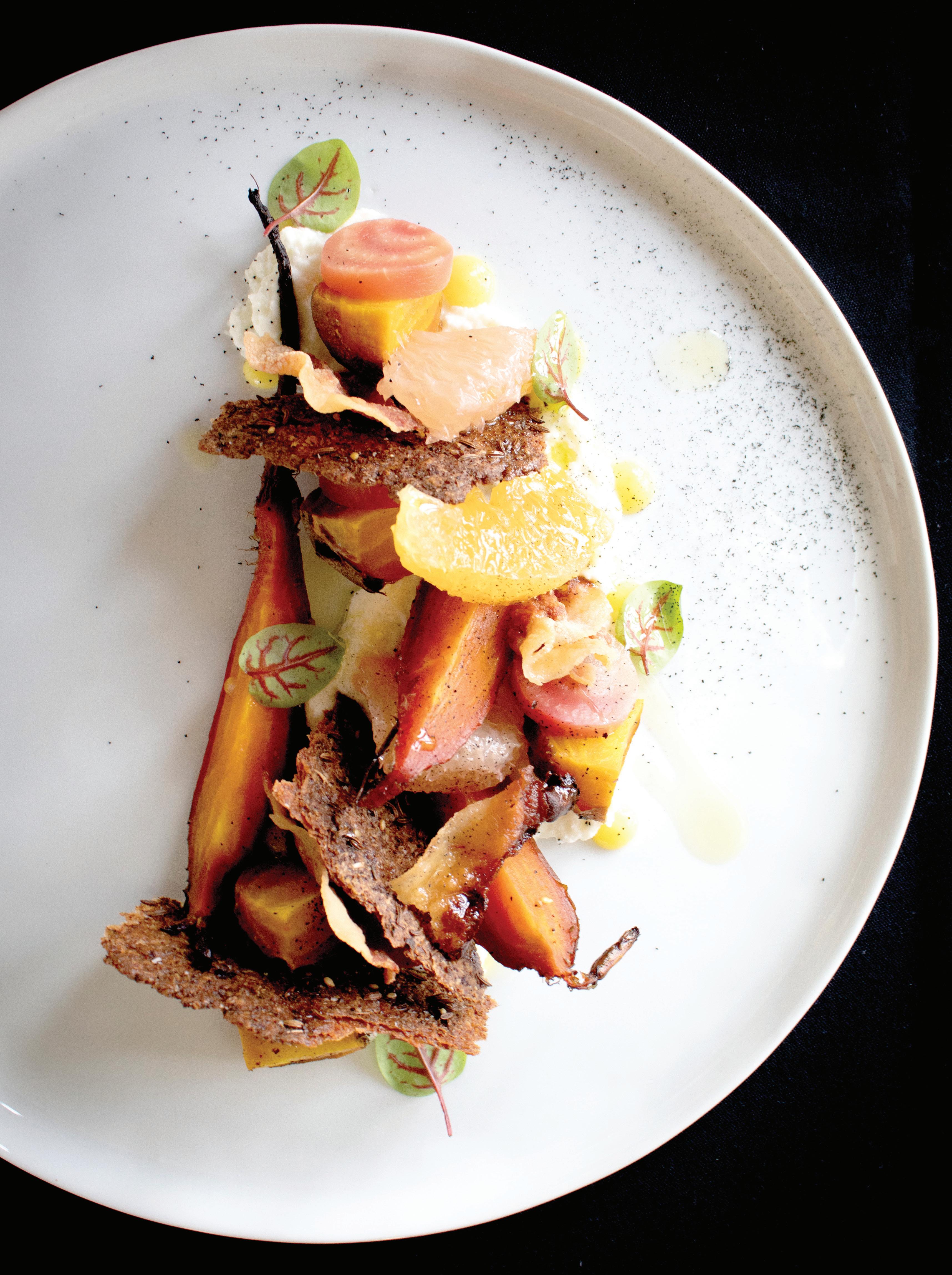
Golf Kitchen Magazine 128
RECIPE BY BLAKE BURGARD
WOOD ROASTED REMEMBRANCE FARM BADGER FLAME BEETS
with Whipped Acorn Hill Farm’s Goat Ricotta, Rye Crisp, Winter Citrus, House Cured Guanciale, and Preserved Orange
Yields 4
Ingredients
Preserved Orange
• 6 Oranges
• 2 Lemons (juiced)
• 2 cups Kosher Salt and Pepper
• 1/2 cup Sugar
Beets
• 4 Badger Flame Beets
• 4 Baby yellow Beets
• 4 Choggia beets
• 1 cup Fresh Goat Ricotta
• 1 Oranges (segmented)
• 1 Grapefruit (Segmented)
• Red Veined Sorrel (for garnish)
• Beet Ash (for garnish)
• 1 Tablespoon Sherry Vinegar
• Extra Virgin Olive Oil
• Salt and Pepper (to taste)
Guanciale
• 2# Pork Jowl
• 1/2 cup Kosher Salt
• 1/3 cup Sugar
• 4 Cloves (smashed)
• 10 Black Peppercorns (smashed)
• 1/2 bunch Thyme
• 3 Bay Leaves
Rye Crisp
• 2 Tablespoons Za’atar
• 1 Tablespoon Caraway
• 1 Tablespoon Maldon Sea Salt
• 3 Tablespoons Active Dry Yeast
• 3 1/2 cups Warm Water
• 455 grams Rye Flour
• 555 grams All-purpose Flour
• 20 grams Salt
Preparation
Preserved Oranges (make 4 weeks ahead of time)
Cut the 4 oranges into wedges. Mix the salt and sugar together in a small bowl.
Layer orange wedges in a clean jar with the salt and sugar mixture in between each layer.
Cover with juice of remaining oranges and lemon juice. (enough to submerge). Leave in a cool dark place for at least four weeks.
The Tuxedo Club 129
Once oranges are ready, remove from brine. Chef Note: The rind will be tender when ready. Cut the flesh from the rind.
Poach the rind in water for about 20 minutes.
Transfer the rind and a little of the poaching water to a blender. Puree until smooth consistency.
Chef Note: Can thicken with xanthan gum if necessary.
Place in squeeze bottle for assembly.
Beets
Season beets with EVOO, salt and pepper.
Place beets on a baking tray and roast in a wood oven (400-450°F) for 30-40 minutes or until a pick can be inserted and removed easily.
Once cool cut into various shapes and marinate with the EVOO and 1 Tablespoon of the sherry vinegar and salt and pepper.
Rye Crisp
Add the yeast and warm water to a mixing bowl and allow to sit and foam.
Add the flour and salt and mix with a dough hook on a stand mixer for about 10-12 minutes.
Transfer to a lightly greased bowl, cover and allow to rise for about one hour.
Punch down dough and scale to 5 ounces. (it will be sticky)
Roll the dough out to about 1/16 of an inch.
Brush with EVOO and season with the za’atar, caraway, and Maldon sea salt.
Bake in 400°F oven or cook in hot cast iron pan or griddle until nicely browned and crispy. Break into bite-size pieces
For the Guanciale
Mix the salt, sugar, and spices together in a mixing bowl.
On a plate, cover the pork jowl with the curing mix. Cryovac and let sit in the fridge for 5-6 days turning to redistribute the cure every day.
Remove from the cure, wash, dry and hang in a drying chamber for 2-3 weeks until desired dryness is reached.
Remove the skin from the jowl and slice very thin. Place between two silpats and bake at 350 °F for 10-12 minutes or until crispy.
Assembly
Whip the goat ricotta with 1 Tablespoon of EVOO and season to taste with salt and pepper.
Smear a crescent of goat ricotta onto the dinner plate. Artfully arrange marinated beets, rye crisp, guanciale and citrus segments on the goat ricotta.
Place a few small dots of preserved orange puree around the edges of the goat ricotta.
Garnish with EVOO, beet ash and red-veined sorrel.
Wine Match
Golf Kitchen Magazine 130
2016 Crossbarn by Paul Hobbs Sonoma Co
 The clubhouse from the 18th hole Image courtesy The Tuxedo Club
The clubhouse from the 18th hole Image courtesy The Tuxedo Club
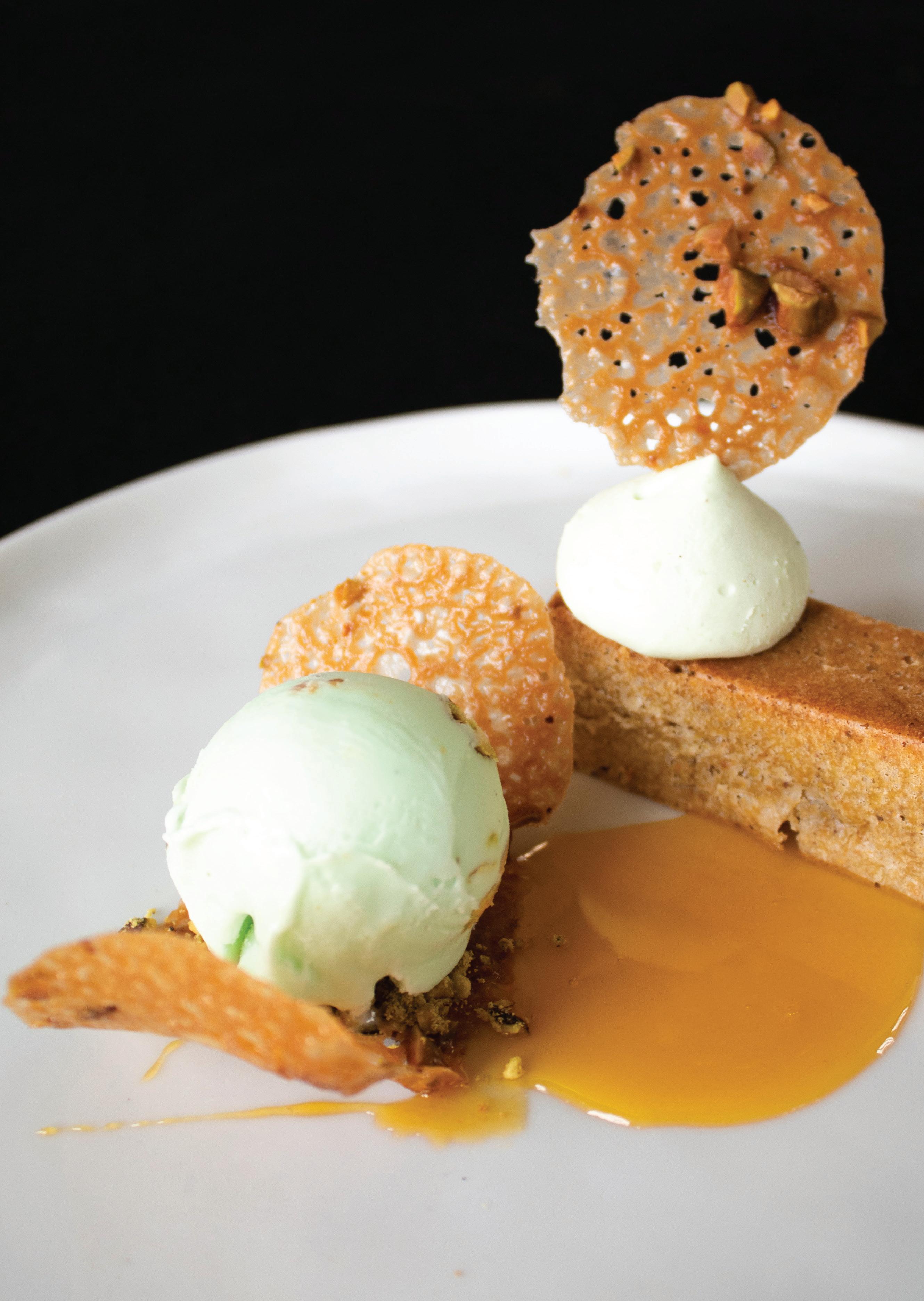
RECIPE BY BLAKE BURGARD
TASTING OF PISTACHIO
Serves 4
Ingredients
Pistachio Ice Cream
• 1 cup Toasted Pistachio (whole)
• 1/2 quart Milk
• 1/2 quart Heavy Cream
• 8 ounces Sugar
• 1 Vanilla bean (split)
• Salt (pinch)
• 1 Tablespoon Pistachio Paste
Pistachio Lace Cookie
• 8 ounces Butter
• 1 cup Corn Syrup
• 1 cup Sugar
• 2 cups All-purpose Flour
• 1 cup Pistachio (chopped)
Pistachio Mousse
• 2 cups Milk
• 2 cups (+ 1 Cup reserved) Heavy cream
• 12 yolks
• 8 ounces Sugar
• 1/4 teaspoon Vanilla
• 2 Tablespoons Pistachio Paste
• 6 Sheets Gelatin
Passion Fruit Sauce
• 2 cups Passion Fruit Puree
• 1 cup Sugar
• 1 teaspoon Vanilla
Pistachio Financier
• 8 ounces of Browned Butter
• 1 cup All-purpose Flour

• 1 cup Sugar
• 1 cup Light Brown Sugar
• 8 Egg Whites
1/2 Cup Pistachio (fine ground)
1/2 cup Pistachio (crushed)
2 Tablespoons Baking Powder
The Tuxedo Club 133
Preparation
Pistachio Ice Cream
Heat the milk, cream, pistachio paste, and split vanilla bean in saucepot.
In a mixing bowl temper the milk/cream mixture into the egg yolks.
Return mixture to the pot and warm to 180°F.
Strain and chill overnight.
Churn in an ice cream maker.
When ice cream is freezing fold in the toasted pistachios.
Lace Cookies
In a mixing bowl cream the butter and sugar.
Add the corn syrup, flour, and mix well.
Add the pistachio’s and mix well.
Chill the dough for at least 30 minutes. When chilled, scoop 1 teaspoon and bake on silpat at 325°F until amber in color. Chef Note: The dough will spread to about 3x original size.
Pistachio Mousse
Mix the eggs and sugar in a mixing bowl. In a saucepot, heat the milk, cream, and pistachio paste. Temper mixture into egg yolks. SHOULD THIS BE IN WITH THE EGG AND SUGAR MIXTURE??
Return the mixture to the pot and cook until 180°F. Strain and chill. Set aside.
Bloom 6 sheets gelatin in cold water. Whip the reserved 1 quart of heavy cream to medium-stiff peaks.
Drain the gelatin sheets and melt over a water bath. In a mixing bowl, mix the chilled crème anglaise and the melted gelatin. Fold in the whipped cream and pour into desired molds. Allow 3-4 hours to set.
Passion Fruit Sauce
Add the all ingredients to a small saucepot. Reduce until the desired consistency is reached. Chill for service.
Pistachio Financier
In a mixing bowl, whip the egg whites and sugar until they form medium peaks.
Fold in the flour and nuts then fold in browned butter. Bake 350°F for 12-15 minutes on a baking tray.
Assembly
When Lace cookies are just out of the oven, take half and place on a rolling pin to shape. Leave the other half flat.
Pool passion fruit sauce into the middle of a servingplate.
Place pistachio financier off center and rest chilled pistachio mousse on top.
Placethe curved lace cookie down on plate, place a small spoonful of crushed pistachio to act as a base for the pistachio ice cream.
Gently stand flat lace cookie in the mousse.
Wine Match
2013 Hermann Donnhoff Riesling Spatlese Norheimer Kirschheck
Golf Kitchen Magazine 134
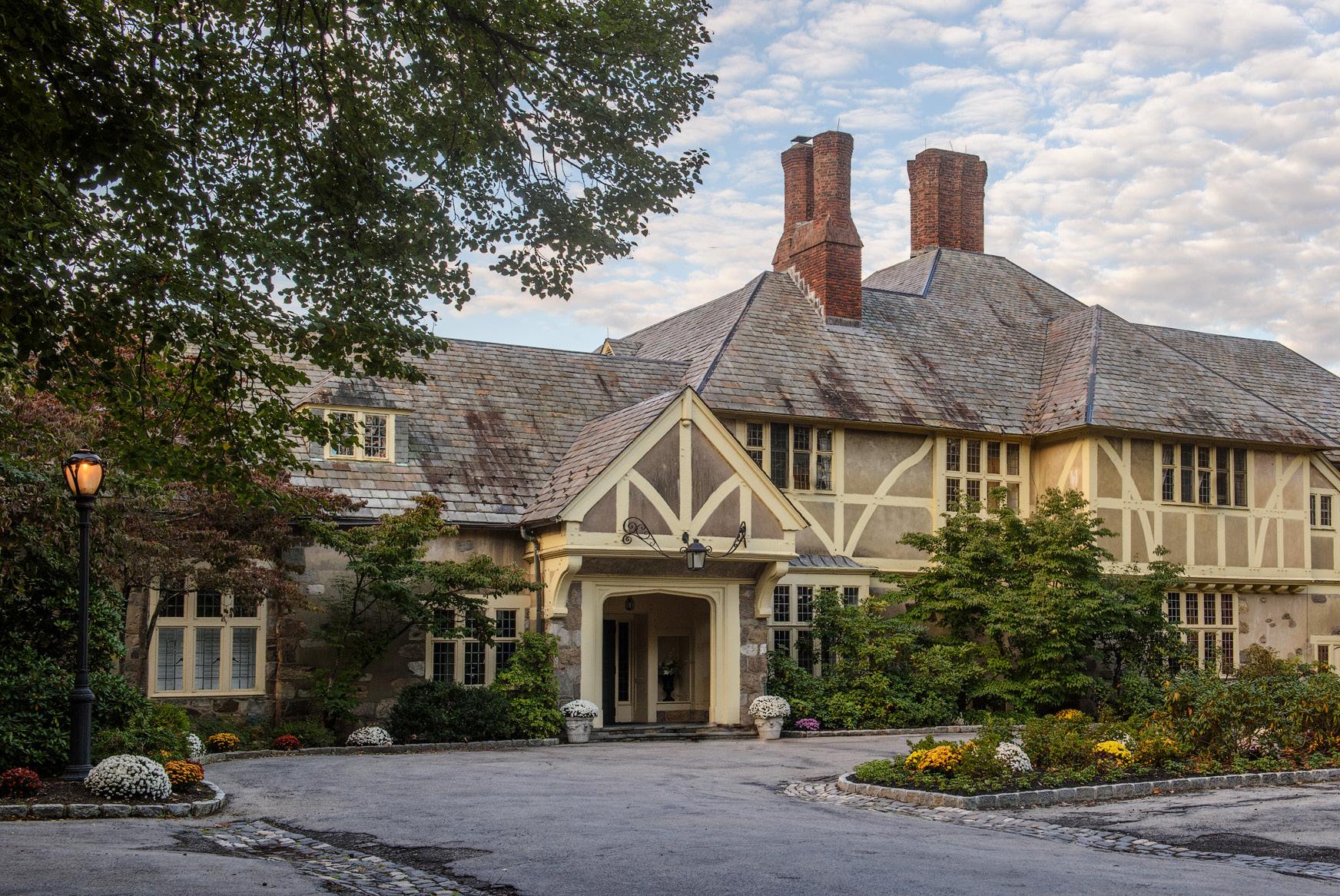
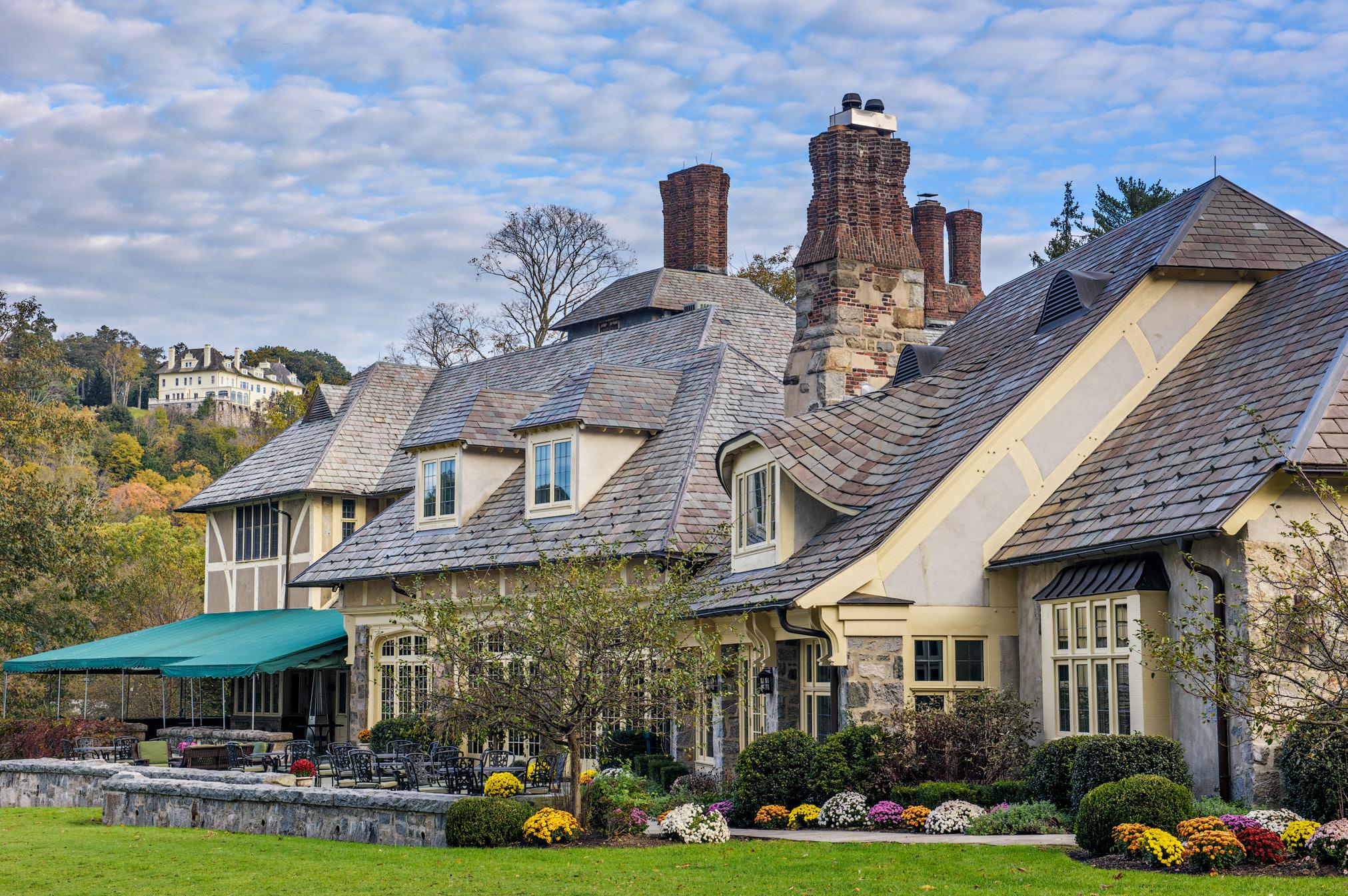 The main entrance
Image courtesy The Tuxedo Club
The terrace
Image courtesy The Tuxedo Club
The main entrance
Image courtesy The Tuxedo Club
The terrace
Image courtesy The Tuxedo Club
Clubhouse Cocktails
THE PROPER SPRITZ
Ingredients
1.5 ounces Stoli-Orange Vodka
1 ounce Pomegranate Juice (substitute - Cranberry)
Splash of Nelli & Joe’s Key West Lime Juice
Club Soda Lime Twist
Preparation
Shake the vodka and lime juice in a shaker glass with ice. Fill a rocks glass with ice and pour in the pomegranate juice.
Gently pour the vodka and lime juice over the ice to create a layered look.
Top with a splash of club soda. Garnish with the lime twist.
Mixologist Note: It’s a simple drink, but a fan favorite.
 Recipe by Hailey Clower Mixologist, Sebonack Golf Club
Recipe by Hailey Clower Mixologist, Sebonack Golf Club

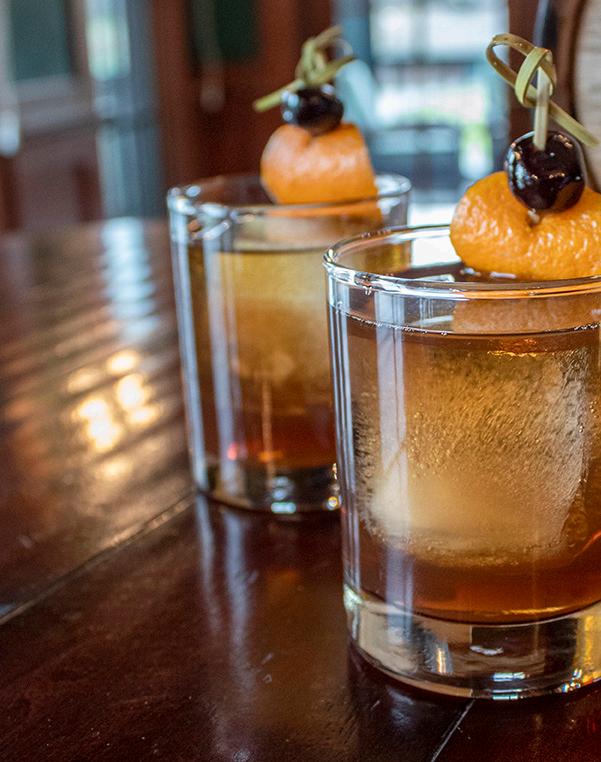
MAPLE OLD FASHIONED
Ingredients
Maple Simple Syrup (make ahead of time and store if desired)
1 cup Maple Syrup
1 cup Water
2 whole Cloves
1 teaspoon Allspice
1 teaspoon Cardamom
Sea Salt (pinch)
Maple Old Fashioned
2 ounces Rye Whiskey or Bourbon
1/2 ounce Maple Simple Syrup (see recipe)
2 dashes Angostura Aromatic Bitters
1 large Ice Cube
Garnish
Orange peel (curled)
Preparation
Maple Simple Syrup
Combine the maple syrup and water in a saucepan. Add the cloves, allspice, cardamom and sea salt. Boil until reduced by half. Let cool.
Maple Old Fashioned
Pour the whiskey, maple simple syrup and bitters into a mixing glass.

Add the ice and stir until very cold, about 15 seconds. Strain into the glass over new ice.
Garnish
Using a peeler, make an orange twist about 2 inches long. Express the oils from the peel, rub and twist on the rim and put into the drink.
Mixologist note: Try using black walnut bitters from Fee Brothers in place of the Angostura Aromatic Bitters.
Recipe by Brian Weber, Mixologist at The Tuxedo Club and Co-Author of Cocktails Made Simple.
MAGAZINEClubhouse Cocktails 139
Dan Hess A Rising Star at Westchester Hills Golf Club
Dan Hess grew up watching Emeril Lagasse and other famous chefs on The Food Network and the Cooking Channel, they had inspired him from a very young age. Dan went on to complete an Associates in Culinary Arts and a Bachelors in Business Administration at SUNY Delhi, New York. At 22, Dan has a strong list of achievements in both the theatre and the kitchen. ~
Diana DeLucia
GK: First of all, tell us about your Broadway achievements.
From as young as I can remember, I was interested in musical theater, and I wanted to see Broadway shows. I was involved in the chorus, band, jazz band, concert choir and the performed in an accapella group in high school. I’ve been in 30 shows. I was part of an off-Broadway acting group, and this allowed me to go to the city and perform with Broadway stars. I can sing, dance, and play almost any instrument.
GK: Do you see a correlation between music and cooking?
Cooking is considered a symphony. We always have to have our eyes and ears open, and we must be paying attention all the time for the service to come together. If you make a mistake, it can ruin the show or the service. And like a symphony working and playing together with a team creates a master piece and has great impacts on our membership.
GK: What lead you to Westchester Hills Golf Club?
Tyler Demarest, the General Manager visited my school searching for an intern to run the pool cafe. He hired me the day after I interviewed and I am now in my third season and was recently promoted to Banquet Chef. I started at the pool and ran that for two years before moving to the main Clubhouse and getting a full time job as the Banquet Sous Chef.
GK: How did you get involved in the ACF competitions?
Since my first year of college I have been a member of the American Culinary Federation (ACF) and have taken full advantage of all they have to offer. I helped train with the hot foods team in college in hopes that some day I would be able to compete on that student team in ACF sanctioned competitions. I was an apprentice for a year and then eventually earned a spot on that team. I competed in individual competitions, teams, and then the Student Chef competition. I have always looked up to the professionals who compete in different categories trying to learn from them so that some day I can compete at that level too.
GK: Tell us about your second place experience?
I was one out of five students across the nation to compete in last year’s American Culinary
Golf Kitchen Magazine 140
INTERVIEW

Federation National Student Chef of the Year competition. I qualified by winning 1st place in the Northeast regional Student Chef competition in Spring 2019, and then placed second in the National competition in Orlando, Florida, in August 2019. I had to use Grouper, squab (pigeon) and on top of that, I had Florida pink shrimp, bacon, tomatoes, corn, hazelnuts, leeks, green zucchini, key lime, farro, oyster mushrooms, and two fruits of my choice in which I used mango and edamame. These are all the products I had to work with.
It was an amazing opportunity to represent the Northeast region and show the nation my skills. I made multiple connections while in Orlando and had a blast preparing and competing on that prestigious stage for the
GK: Tell us about your new role.
Back in November of 2019, I was promoted to Banquet Sous Chef. I was three months out of college and I became a full time employee at the club. Due to the time of year I only got minimal experience in the position before the club closed for the month of January. Now that we are open and back in full swing I am getting more experience in the role. I assist Chef Tony and make sure all banquets and events go out as efficiently as possible. I still ove see the pool café under Chef Antonio’s direction and will be in charge and running a mobile wood fire pizza oven which is new to the Club this past November.
GK: What are your long-term goals at Westchester Hills Golf Club?
I hope to earn some great new skills and make many connections with other chefs in the area and members at the Club. With the new pizza oven I want to master another skill to add to my repertoire. Working along side Chef Antonio has been a great time and I hope to continue it for many years to come. I want to continue trying out new ideas for the membership and want to share my ideas with others in the form of food.
ACF National convention at the World Marriott in Orlando, Florida.
GK: Does your Executive Chef Antonio Zepeda give you opportunities to shine during special dinners at the club?
Yes, I have been very fortunate to do some chefs table dinners and create specials during ala carte service on weekends. One of them was special as I was serving two dishes from my ACF competition. One of the dishes was squab, and I found out that the members were not familiar with it. That is the nervous part of cooking for the members, sometimes you get it right and sometimes you don’t. Cooking unique foods for members can be a hit or miss. Some of them are willing to try new dishes while others just want the simple meat and potatoes.
Golf Kitchen Magazine 142
“ I want to continue trying out new ideas for the membership and want to share my ideas with others in the form of food.”
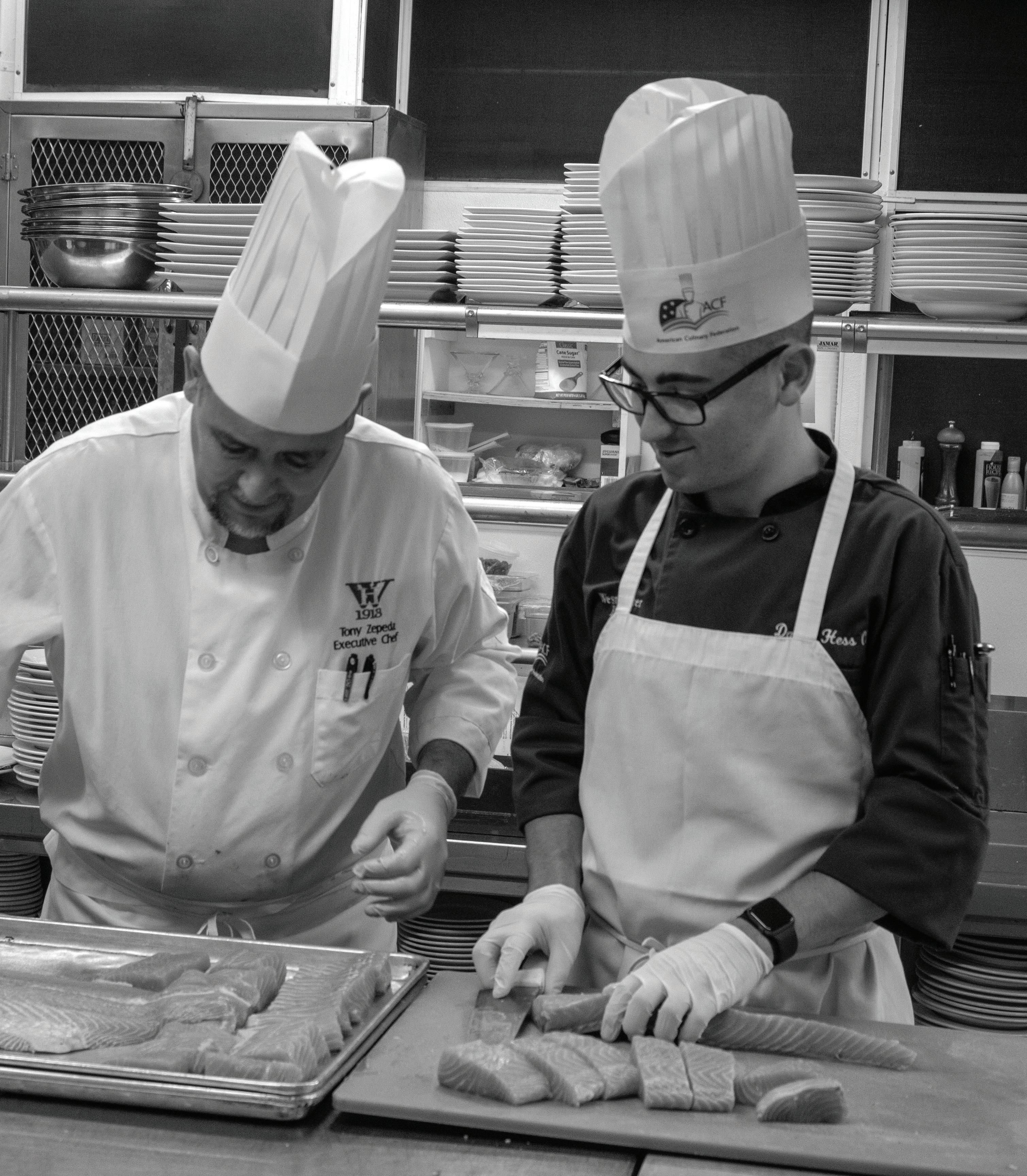
Westchester Hills Golf Club 143
Antonio Zepeda, Executive Chef with Dan Hess Banquet Chef at Westchester Hills Golf Club
RECIPE BY DAN HESS
Fall Harvest Salad with Shallot Dijon Dressing
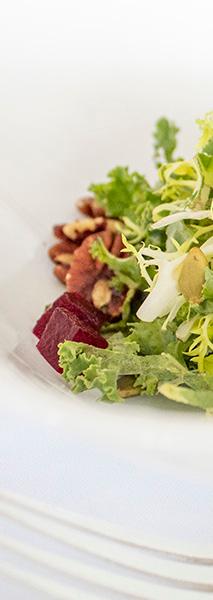
Yields 2
Ingredients
Salad
• 3 cups Kale Greens
• 1 head Kale
• 1 Red Beet (cubed)
• 1 Apple (sliced)
• 1/2 cup Pecans
• 1/2 cup Pumpkin Seeds
Shallot Dressing
• 1/2 Shallot
• 1/2 cup Olive Oil
• 1/4 cup White Wine Vinegar
• 1/2 cup Dijon Mustard
• 2 Tablespoons Lemon Juice
• 2 large Garlic Cloves
• Salt and Pepper (to taste)
Preparation
Salad
Rinse the greens in a colander until free of sediment. Place the beets in foil and cover in salt. Roast in an oven at 350ºF for 40 minutes. Remove from the oven. Slice the apples on a mandolin and cover with powdered sugar and cook in an oven at 250ºF for ten minutes or until brown.
Sauté the pumpkin seeds in a pan on high heat with oil until golden in color and set aside. After the beets have cooled cut into 1/2-inch cubes and set aside. Combine all ingredients in bowl and dress when ready to serve.
Golf Kitchen Magazine 144
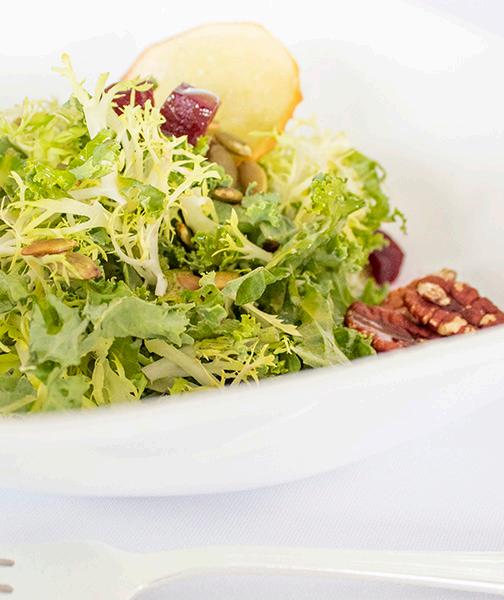
Westchester Hills Golf Club 145
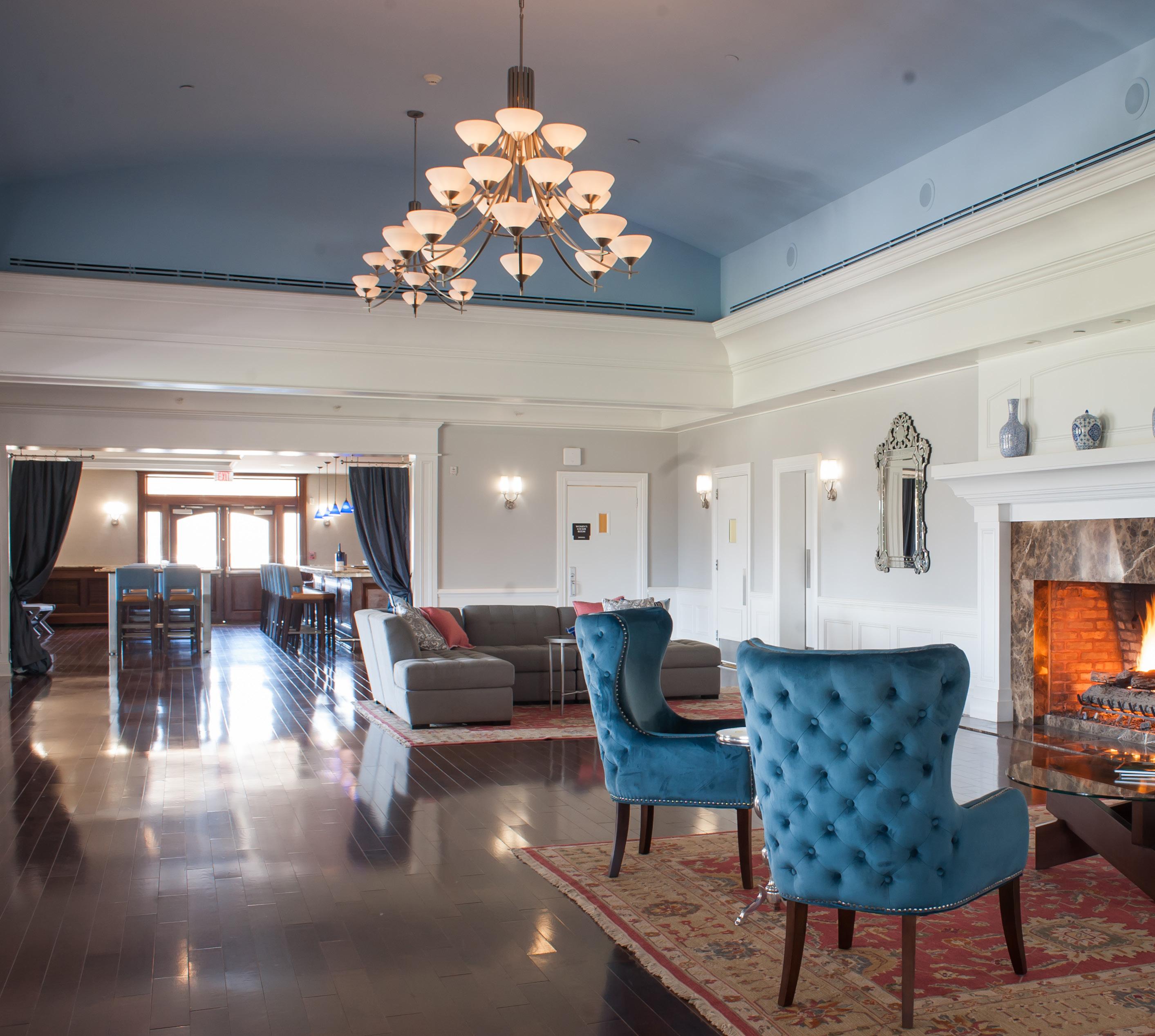
Golf Kitchen Magazine 146
Shallot-Dijon Dressing
Sauté the diced Shallot and chopped garlic in a pan until slightly brown. Mix in the vinegar, mustard, and lemon juice together in medium bowl. Slowly add the olive oil until thick in consistency while whisking.
Combine the shallots and oil mixture and refrigerate until ready to serve.
Wine Match
Appellation Sancerre Controlee
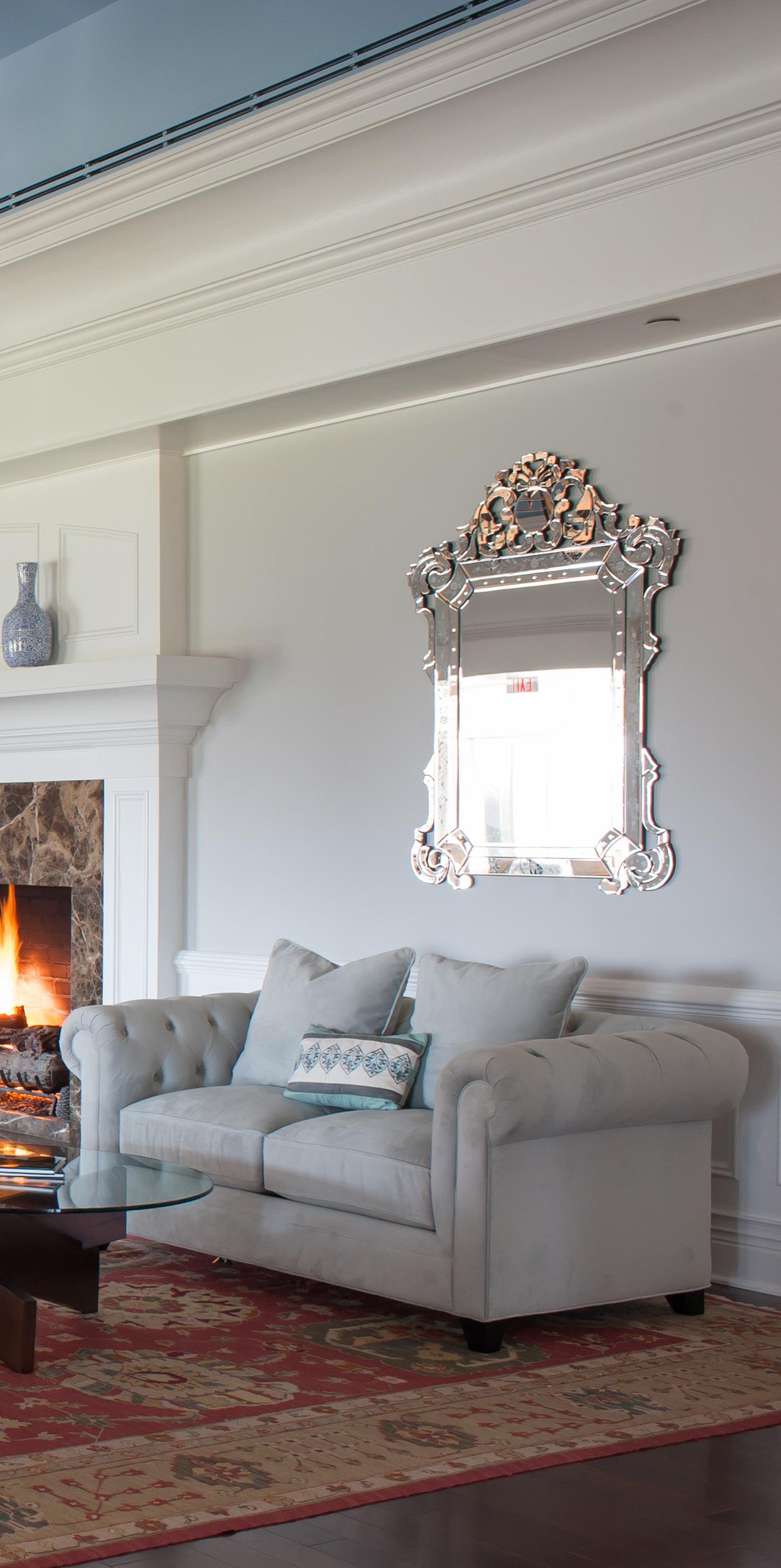
Westchester Hills Golf Club 147
 RECIPE BY DAN HESS
RECIPE BY DAN HESS
Stuffed Breast of Squab with Mushroom Farce, Drumstick Rillette, Edamame Zucchini Succotash Style and Seared Farro Cake
Yields 2
Ingredients
Edamame Succotash
• 2 ounces Bacon
• 1/2 Shallot
• 1 teaspoonGarlic
• 1 ear Corn
• 1/2 Zucchini
• 1/2 cup Tomato
• 1 teaspoon Chives
• 2 Tablespoons Olive Oil
• Salt and Pepper (to taste)
Squab Rillette
• 2 each Squab Thighs, Legs, Tenderloin meat: leg bones reserved
• 1/2 egg white
• 2 Tablespoons Breadcrumbs

• 1 Tablespoon Parsley
• 4 sprigs Thyme
• 1 Shallot
• 2 cloves Garlic
• 1 cup Stock
• 3/4 cup Hazelnuts
• Salt and Pepper (to taste)
Farro cake
• 1.5 cups Farro
• 1 each leek
• 1/2 Carrot
Westchester Hills Golf Club 149
• 3 cups Veal Stock
• 2 Tablespoons Parsley
• 2 Tablespoons Chives
• 2 Tablespoons Olive Oil
• Salt and Pepper (to taste)
Mushroom Farce
• 8 ounces Oyster Mushrooms
• 2 ounces Stock
• 2 ounces Brandy
• 2 ounces Shallot (diced)
• 1 strip Bacon
• 1 Egg
• 1 ounce Hazelnuts (roasted)
• 1 Tablespoon Parsley
Preparation
Edamame Succotash
Render bacon in sauté pan on low heat until crispy and remove from pan. Add onion, and garlic into same pan and sauté until white in color. Add in zucchini, corn, edamame and cook for four minutes until soft. Add in tomato and cook for one minute. Add in cooked bacon and stir in chives, salt, and pepper.
Squab Rillette
Add squab meat, shallot, thyme, and garlic to sauce pot with stock. Braise until tender about 25 minutes. Strain reserved liquid and cool braise in a little braising liquid. Grind toasted hazelnuts and set aside. Finely chop cooled braise and combine in bowl with egg white, salt, pepper, and parsley. Add in breadcrumbs if needed. Roast leg bones in oven for 10 minutes after cleaning excess meat off bone. Form braising mixture around bone, roll in hazelnuts and evenly coat. Fry in 350-degree fryer for five minutes or until golden brown.
Farro Cake
Grind raw farro in food processor until finely chopped. Add chopped leek, carrot, water and veal stock to sauce pot and bring to a boil. Turn down to a simmer and reduce all liquid. Reserve until ready to serve.
Sauce
Reduce leftover braising liquid and season with salt and pepper. Mount with cold butter until thick in consistency.
Mushroom Farce
Sauté mushrooms and shallot in sauté pan until soft. Add in garlic and then deglaze pan off the flame with brandy. Add in stock and let reduce by half. Cool in freezer
until room temperature. Grind chopped hazelnuts in food processor with mushroom mixture and pulse until smooth. Fold in herbs and season with salt and pepper.
Assembly
Combine all parts on white plate and serve.
Wine Match
Oregon Pinot Noir
Golf Kitchen Magazine 150

A CHEF WHO GETS THE MESSAGE RIGHT
by Paul Sorgule
Two of the most significant issues facing businesses today are RETAINING good employees who are so difficult to find and MAXIMIZING the productivity and efficiency of those same employees. Ample research has been done pointing to the most significant culprit behind these issues - POOR COMMUNICATION! According to Big Picture Learning – “A 2014 survey by About.com found that the top three reasons for leaving an organization were communication related: a lack of direction from management, overall poor communication, and poorly communication constant change.” Furthermore, they concluded that: “People look for new opportunities elsewhere when they are not engaged with the vision and the mission of their current employer.”
Sometimes the fault lies with a lack of desire to communicate, oftentimes the problem is the incorrect use of communication, but the majority of time the challenge is that leadership has no idea how to effectively communicate a message in a succinct, timely manner.
We live in a world where numerous communication tools are available and where an overload of ineffective communication abounds, confuses, and even irritates those on the receiving end. Newsletters, bulletin boards, payroll stuffers, email blasts (the average person receives nearly 120 emails every day), and tweets and texts seem to attack our senses with reckless abandon. How are employees going to decipher what is important, what needs immediate attention, and what is simply useless fodder that has little relevance to the work in front of them? Additionally, where is the opportunity for those same employees to engage in the conversation, offer their own input, and see the results of their involvement?
There are many clues to more effective communication that include making your message clear and concise, creating a vehicle for feedback from employees and demonstrating that you actually pay attention to that feedback, and being more strategic so that communication overload is kept to a minimum. But, the most effective way to improve this connection with employees is to communicate through storytelling. When communication is interesting and fun, then it’s relevance is more likely to be realized.
I recently spoke with Charles Carroll – one of America’s more successful chefs and business leaders, about an initiative that he has been engaged with for the past few years. Carroll is the Executive Chef of the River Oaks Country Club in Houston – one of the most prestigious, and busiest, clubs in the country. His accomplishments in the culinary arts are far too broad to review here, but this new project takes his many talents far beyond the kitchen. As he stated in our interview: “This system that we have been developing is a game changer!”
Chef Carroll is now engaged in a project that is applicable to any business, of nearly any size. This chef has taken on the challenge of communication and may just have found the answer that business leadership has been looking for.
These are the highlights of our interview:
Paul Sorgule: So with everything that is on your plate as Executive Chef of one of the busiest clubs in America, author, public speaker, and ambassador for initiatives within the American Culinary Federation and the World Chefs Association – why did you take on the monumental task of developing a Podcast?
Charles Carroll: After writing my third book The Recipe – a story of loss, love, and the ingredients of success, my book partner John David Mann recommended that we connect as a guest on a total of 60 podcasts to promote the book. I was willing to do whatever it took, so

Paul Sorgule 153
we did. After the fifth or sixth interview I was thinking – this is pretty cool I think I want to develop my own. Two months later – The Recipe Podcast, Celebrity Secrets – was born.”
Paul Sorgule: What are your goals with this medium of communication?
Charles Carroll: Well, it started as a hobby, but soon gained a lot of attention. We did four on location shows to include two ACF Conventions and the World Chefs Congress in Malaysia. After that we started to attract sponsors as it became more serious. We now have a very cool studio that has allowed us to stream the shows on YouTube.”
Paul Sorgule: Who do you see as your audience?
Charles Carroll: We have two different shows: The Recipe Celebrity Secrets, and The Recipe Unplugged which is more on the comedy side with guest comedians. So we capture many chefs and people in the hospitality field as well as individuals who just want to kick back and laugh.
Paul Sorgule: How will you measure success?
Charles Carroll: We can monitor how many listeners we have so we work hard with promotions to keep the audience numbers high. It is important that our sponsors are happy. Also, with all of the interesting chefs that we have as guests, we are able to expose them to sponsor products – many of our guest chefs have, as a result of the show, hired or contracted with our sponsors. It’s a win, win.
Paul Sorgule: It is my understanding that you are going to use this model to create a communication tool for businesses of all types as they seek new ways of interacting with their employees. How will you translate a culinary business model to fit in other types of environments?
Charles Carroll: YES! We are so excited to have started a service called: My Company Radio. I was involved in consulting for a company that has 4,000 employees in 14 states. They asked me how they could communicate and educate them on a weekly basis. That was what started the wheels turning. So, we developed a system where we take messaging from top level leadership and surround it with motivation, inspiration, education, employee recognition, and turn the message into an entertaining show sent to their entire team. Now, the weekly message, full of pertinent information, is entertaining as well as informative. Employees can’t wait to hear the next show.”
Paul Sorgule: What is your vision with regard to this?
Charles Carroll: We currently have several clients including private clubs, an oil company, and distribution vendors. We are also engaged in conversations with hospitals, police and fire departments, resorts and large hotels. The beauty of the system is that there are only two qualifications: 1) You need to have at least 50-employees, 2) you genuinely care about your people. That’s It!
Let’s face it, when there is a challenge or mistake in our business, the vast majority of time the source comes down to a breakdown in communication. Now, we are making communication fun, attractive, convenient, and easily accessed through your smart phone.
Paul Sorgule: It has been said that the most common complaint by employees in any business is a lack of, or lack of accurate communication between leadership and employee. Is it your goal to present a way to fix this?
Charles Carroll: Absolutely, Our system is so easy to use and downloads on any smart phone. We have some of the most sought-after experts contributing to the shows with topics pertaining to motivation, inspiration, celebrity fitness, Fortune 500 consultation, meditation, and Human Resource Management. Also, another feature we are excited about is allowing
employees to have direct communication back to top leadership through the show. Now, front-line employees have a safe environment and conduit direct to the decision makers.
Paul Sorgule: Put on your future glasses and talk about what this business model might look like in five years considering all of the lightening fast changes in technology.
Charles Carroll: To be honest, I think this system is a game changer! The days of employee newsletters that nobody reads, email blasts that never get opened, or teleconferencing that only a few can take part in are over. This system allows employees to listen on their time, while at the gym, driving to work, grocery shopping, or boarding a plane. Most of all – with our company inspirational presenters, we consider the show a gift of enrichment. I believe this model can become a standard of communication for any company, no matter how technology allows it to evolve in the future.
At a time when so many companies struggle with finding, motivating, and retaining employees – it only makes sense to invest in the appropriate tools that will connect staff members with management and leadership in a way that is honest, timely, and effective. It may just be that Chef Carroll has found the answer.
To connect with Chef Carroll and his portfolio of contemporary communication tools – use the following links:
MY COMPANY RADIO
www.mycompanyradio.com
THE RECIPE PODCAST, CELEBRITY SECRETS and THE RECIPE, UNPLUGGED
www.chefcharlescarroll.com
PLAN BETTER – TRAIN HARDER
Harvest America Ventures, LLC
Restaurant and Culinary School Consulting www.harvestamericacues.com - BLOG
Paul Sorgule 155
























































 Gideon Dariyal Heller is a creative professional based in South Florida, United States.
Gideon Dariyal Heller is a creative professional based in South Florida, United States.

 The stunning GlenArbor Clubhouse.
The front entrance of Wycliffe Golf & Country Club Image courtesy Wycliffe G & CC
The stunning GlenArbor Clubhouse.
The front entrance of Wycliffe Golf & Country Club Image courtesy Wycliffe G & CC

 Flavours at Wycliffe Golf & Country Club
Image courtesy Wycliffe G & CC
Flavours at Wycliffe Golf & Country Club
Image courtesy Wycliffe G & CC
 Flavours at Wycliffe Golf & Country Club
Image courtesy Wycliffe G & CC
Flavours at Wycliffe Golf & Country Club
Image courtesy Wycliffe G & CC


 Corn Papaya Relish
Corn Papaya Relish
 The Cliffe at Wycliffe Golf & Country Club
Image courtesy Wycliffe G & CC
The Cliffe at Wycliffe Golf & Country Club
Image courtesy Wycliffe G & CC



 The back of the clubhouse at Wycliffe Golf & Country Club Image courtesy Wycliffe G & CC
The back of the clubhouse at Wycliffe Golf & Country Club Image courtesy Wycliffe G & CC



 The Grille at Wycliffe Golf & Country Club Image courtesy Wycliffe G & CC
The Grille at Wycliffe Golf & Country Club Image courtesy Wycliffe G & CC


 The Veranda at Wycliffe Golf & Country Club
The Veranda at Wycliffe Golf & Country Club

 Image courtesy of The Madison Club Madison, Wisconsin, USA
Image courtesy of The Madison Club Madison, Wisconsin, USA
 by Alex Tyink
by Alex Tyink




 Peter Zoole prepping for his Underground Club Dinner
Image by Gideon Heller
Peter Zoole prepping for his Underground Club Dinner
Image by Gideon Heller


 Lasagnette of Bleu Crab with Buerre Nantais and Pistachio
Image by Gideon Heller
Lasagnette of Bleu Crab with Buerre Nantais and Pistachio
Image by Gideon Heller
 Randy and Betsy Haberman
Randy and Betsy Haberman

 Orange Dulce with Gianduja Cremeux, Bitter Orange, Passion Mango Sorbet
Image by Gideon Heller
Orange Dulce with Gianduja Cremeux, Bitter Orange, Passion Mango Sorbet
Image by Gideon Heller
 Image by Michael J. Fiedler
Fernando Silva
A Sommerlier & Artist at GlenArbor Golf Club
Image by Michael J. Fiedler
Fernando Silva
A Sommerlier & Artist at GlenArbor Golf Club

 “The Golf Swing TAngo”
by Fernando Silva
“The Golf Swing TAngo”
by Fernando Silva



 The clubhouse from the 18th hole Image courtesy Liberty National Golf Club
The clubhouse from the 18th hole Image courtesy Liberty National Golf Club







 Harvest Moon
Image by Shaun C. Lewis
Grey Goose VX Martini
Image by Shaun C. Lewis
Harvest Moon
Image by Shaun C. Lewis
Grey Goose VX Martini
Image by Shaun C. Lewis
 The outdoor terrace.
Image courtesy Liberty National Golf Club
The outdoor terrace.
Image courtesy Liberty National Golf Club


 RECIPE BY SHAUN C. LEWIS
RECIPE BY SHAUN C. LEWIS


 The City View Terrace (CVT) Image courtesy Liberty National Golf Club
The City View Terrace (CVT) Image courtesy Liberty National Golf Club
 RECIPE BY SHAUN C. LEWIS
RECIPE BY SHAUN C. LEWIS


 The main dining room.
Image courtesy of Liberty National Golf Club.
The main dining room.
Image courtesy of Liberty National Golf Club.
 RECIPE BY SHAUN C. LEWIS
RECIPE BY SHAUN C. LEWIS

 by Natalia Fedra Cabrera MerCader
by Natalia Fedra Cabrera MerCader











 RECIPE BY SCOTT PIKEY
RECIPE BY SCOTT PIKEY



 RECIPE BY SCOTT PIKEY
RECIPE BY SCOTT PIKEY



















 The reservoir and boat house Image courtesy The Tuxedo Club
The reservoir and boat house Image courtesy The Tuxedo Club

 The clubhouse from the 18th hole Image courtesy The Tuxedo Club
The clubhouse from the 18th hole Image courtesy The Tuxedo Club



 The main entrance
Image courtesy The Tuxedo Club
The terrace
Image courtesy The Tuxedo Club
The main entrance
Image courtesy The Tuxedo Club
The terrace
Image courtesy The Tuxedo Club
 Recipe by Hailey Clower Mixologist, Sebonack Golf Club
Recipe by Hailey Clower Mixologist, Sebonack Golf Club









 RECIPE BY DAN HESS
RECIPE BY DAN HESS


